

Smash Factor – What is it? & Ideal Numbers
Smash factor is the amount of energy transferred from the club to the ball. It is a simple math problem, ball speed divided by club speed.
A great smash factor is around 1.50 for a driver, a wedge may be closer to 1.25. But these are numbers that professional golfers would expect.
“Efficiency”, or “Efficiency Rating” are other terms commonly used when referring to smash factor.
Smash Factor Examples
A golfer has a driver club head speed of 110 mph and a ball speed of 165, smash factor equals 1.5. If you can do that consistently, I should see you on TV someday!
Another golfer has a driver club head speed of 110 mph and a ball speed of 150, that’s a smash factor of 1.36. If that’s you, welcome to the party of amateur golf!
Smash factor calculation is simply Ball Speed divided by Clubhead Speed. So 165 / 110 = 1.5 from the example above.
Smash Factor Calculator
If you know club head speed and ball speed, you can calculate your smash factor here.
What is the Highest Smash Factor?
Max smash factor is 1.539. It is also the highest smash factor ever recorded on the PGA tour . With golf club and golf ball limitations by the USGA R&A, it’s really not humanly possible to obtain numbers higher than this.
Oh, and that 1.539 is not an average…it was the HIGHEST value observed across all players since the PGA has been tracking this metric.
The average smash factor on the PGA Tour in 2022 was 1.499. Approximately 111 Pros came in higher than this mark, including Rory Mcilroy with a 1.507 average.
How about the average golfer? The average golfer’s smash factor is about 1.44 . This average comes from TrackMan , which has a lot of data on golfers of all skill levels.
Ideal Smash Factor for Each Club
How to improve smash factor.
It’s all about striking the ball in the center of the club! This generates maximum ball speed.
You can hit the ball further by either increasing your swing speed, or increasing your efficiency. Even better, you can do both!
Typically, when you swing harder, your efficiency will go down . I have been in a love-hate relationship with this fact for quite some time!
When I was a teenager, my Grandfather would tell me to “swing easy”. Or he’d pick a spot in the fairway about 100 yards away and tell me to just try to hit my driver to that distance.
I had no idea at the time, but he was giving me great advice. Now that I have a launch monitor and can see instant results on my ball speed, smash factor, clubhead speed…you name it…it makes a lot of sense.
I can swing the club 115mph and get an average distance of around 305 yards, but my accuracy sucks! I can “hit it easy” at about 105mph and average around 285 yards and my accuracy is pretty consistent. It’s a lot easier to hit the golf ball far when you are efficient.
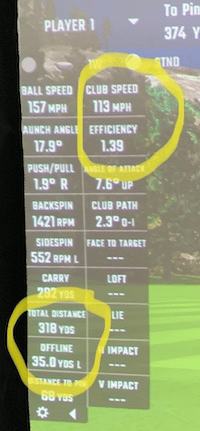
Yes, 20 yards is a big deal…but keeping the ball in play is an even bigger deal.
Try our swing speed calculator to get an estimate.
Interestingly, it took me about 5 shots total to produce those two images. I knew that’s exactly how it would go…and it did.
So, when you see me on the golf course and I’m swinging my driver hard, throw a ball at me and tell me I’m an idiot!
Ball Striking Drills
The first thing I’d recommend doing here is simply figuring out where you are striking the ball. Use some foot powder spray on the clubface and get a decent idea of your dispersion. You’ll quickly see some patterns.
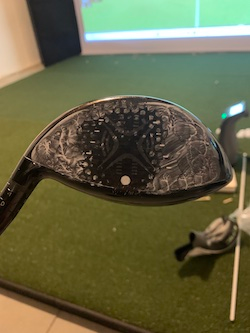
I actually used glass cooktop polish for these, that works pretty well too!
If you are hitting the ball on the heel, try putting a couple of tees in the ground on the outside of your ball, forcing your swing path closer and getting a strike more to the center.
Hitting the ball on the toe, try moving a bit closer in your setup.
Hitting low on the club face? Evaluate the position in your stance, it may be too far toward your front foot. It could also just need to be teed up a bit higher.
Hitting high on the club face, try moving it up in your stance, and try “hitting up on it” more to improve your attack angle. You’re likely “hitting down on it” if the ball is high on the club face.
Hitting all over the club face? I feel you! Develop a very consistent setup. Don’t just walk up to the ball and set your feet where they “seem to be right”. Get a feel for the distance between you and the ball by doing the exact same thing every time.
Frequently Asked Questions
For amateur golfers, if you are hitting your driver with a smash factor over 1.45, this would be considered very good. Scratch golfers will average around 1.46, while 15 handicappers will average around 1.41.
1.5 is commonly referred to as the maximum smash factor, however, PGA Tour golfers are able to get up to 1.539 on individual golf shots. 1.499 was the PGA Tour average in 2022.
As club loft increases, smash factor decreases. The PGA tour average smash factor for a wedge is around 1.25. 8-Iron is around 1.32, 6-Iron is around 1.38, 3-Iron is around 1.45, and driver is around 1.499.
Yes, the higher the better! 1.5 is pretty much the maximum with a driver.
Smash factor is calculated by dividing ball speed by clubhead speed.
No, the higher the better. Although a higher smash factor is a good thing, the maximum we see from professional golfers is 1.539.
Smash factor tells you how efficiently you hit the ball. It is the amount of ball speed generated compared to your clubhead speed.
A 1.3 smash factor with a driver is not good. Hitting with a smash factor around 1.4 and up for an average golfer would be considered good.
In 2022, Rory McIlroy’s average smash factor was 1.507. Out of 124 recorded shots with his driver, his best was 1.537.
Final Thoughts
If you want a higher smash factor, you need to hit the ball on the sweet spot! It’s really that simple. Certainly, launch angle, angle of attack and equipment are going to play a part, but at the most fundamental level, it all comes down to hitting the ball on the center of the club face.
You can increase your efficiency by having a more controlled golf swing and working to gain consistency through practice and drills to promote ball striking in the sweet spot.
About The Author
Leave a comment cancel reply.
Your email address will not be published. Required fields are marked *
Save my name, email, and website in this browser for the next time I comment.

Instruction
What’s your smash factor.
One of the most egotistic terms that my Trackman monitor produces is undoubtedly SMASH FACTOR . Often varying between 0.8 and 1.5, smash factor, by nature, speaks to the egos of people wanting the see the highest number. But what really is smash factor?

In simple terms, smash factor is an “efficiency rating” on the quality of strike; it shows us how much ball speed we are achieving per 1 mph of club speed that we produce. For example, if your ball speed was 140 mph and your club speed was 100 mph, your smash factor would be 1.4, since 140/100 = 1.4.
Generally, top professionals would be aiming for a 1.5 smash factor with a driver and a 1.4 smash factor with mid irons. But it’s important to note that any level of golfer can achieve these numbers; a young child who has a good relationship between his club speed and ball speed could produce a 1.5 smash factor!
Why is smash factor important?
Primarily, smash factor is highly influential in terms of controlling the distance we hit the ball. From a distance perspective, it is important to understand the importance of ball speed, as it accompanies launch angle and spin rate to complete the three main components of distance. Despite this, I see a lot of players chasing club head speed, and while it is important, it is almost redundant if not accompanied by appropriate ball speed.

To match the desire for distance, as a general rule, we should be striving to create the HIGHEST smash factor with our longer clubs; however, this is not the case with shorter clubs and in wedge play. With those clubs, a smash factor of around 1.0 should be targeted as opposed to a 1.1 or 1.2 that I so often see.
This idea of lowering the smash factor is to help with distance control, as a ball that is flying off the club face too quickly can be difficult to control. James Ridyard, a PGA Professional from the UK, has done some great work on smash factor in wedges, discussing specifically the idea of controlling spin loft (explained below). In a recent presentation, James explained how a 4-degree error in spin loft with a club head speed of 60 mph can result in a 30-foot miss!
What affects smash factor?
The two most influential things that can affect smash factor are:
- Strike point
By definition, spin loft is most easily thought of as the difference between the angle of attack (is the club traveling downwards or upwards) and the dynamic loft (loft presented at impact). It is often referred to as a measure of how much energy is transferred into the ball.
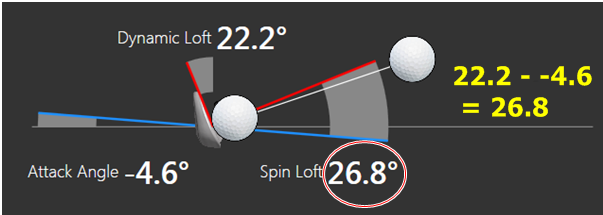
The above picture shows an angle of attack of -4.6 and a dynamic loft of 22.2. The difference between these 2 numbers is 26.8, giving a spin loft of 26.8 .

BUT in the above example, the difference between the angle of attack and dynamic loft is 27.7, however the spin loft reported is 28.0. This is because spin loft is by exact definition a 3-dimensional number and involves the face-to-path relationship.
If you think about spin loft as a measure of the amount of energy transferred into the ball and then think about punching a bag with a glancing blow (representing hitting a ball with a club face well open to club path), this should help you visualise how a poor face-to-path relationship could increase spin loft (reduce the energy transferred into the ball).
Striking the ball on the sweet spot of the club is also very important when looking at smash factor. As you know, off-center hits do not always result in long drives and controlling the strike point is pivotal when attempting to achieve a high smash factor. The below picture is a great example of how strike point is important. As you can see, a lower club head speed with a better strike point resulted in more distance.
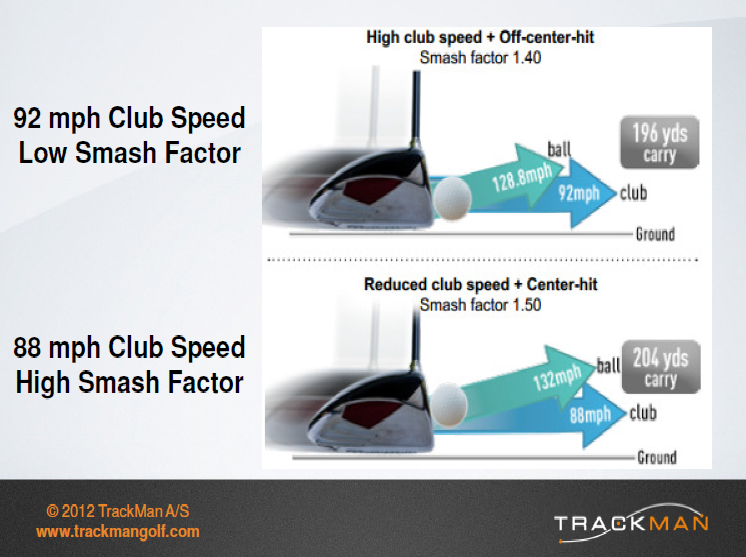
In essence, it is a combination of strike point AND spin loft that will help you achieve a good smash factor!
How can we improve our smash factor?
Before identifying how we can improve smash factor, here is a fact from Trackman that may just motivate you:
[quote_box_center]Reducing Spin Loft from 30 degrees to 25 degrees with a 6 iron will raise Smash Factor by 0.06. For the average amateur, 0.06 equals 5 mph of ball speed or approximately 9 yards.[/quote_box_center]
As shown, reducing spin loft can often drastically help improve smash factor; however, without a ball flight monitor it is impossible to accurately measure spin loft. For this reason I would advise you to go and find your nearest instructor with a monitor and with his or her help you should then be able to gather some information on your current spin loft and discuss whether it actually needs improving.
If you’re not able to use a monitor, however, try this.
Strike point is an easier variable to measure yourself, and all you need is a little athlete’s foot spray. Simply spray a light coating on the club face and after hitting a shot or two, you will soon be able to get some accurate feedback on your strike point.
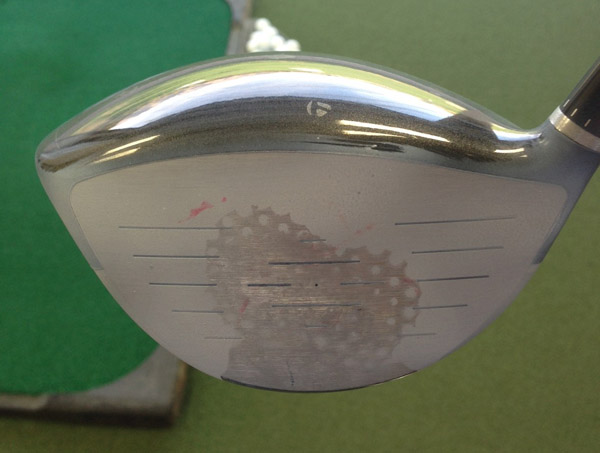
Remember, one (spin loft) without the other (strike point) is not what we want. So aim to combine the two! Happy smashing!

Dave Pelz with research on why average golfers need better short games
Four essential movements for a better golf swing
Thomas is an Advanced UKPGA Professional and Director of the Future Elite (FUEL) Junior Golf Programme. Thomas is a big believer in evidence based coaching and has enjoyed numerous worldwide coaching experiences. His main aim to introduce and help more golfers enjoy the game, by creating unique environments that best facilitate improvement.
19 Comments
Pingback: Smash Factor Calculator (Chart for Each Club): 2023 Why Should You Care?
Nov 4, 2015 at 10:02 pm
1.55 lol alright, and im pretty sure smash factor is regulated for clubs anyway?
Nov 4, 2015 at 10:04 pm
http://www.pgatour.com/stats/stat.02403.html
Feb 16, 2020 at 12:58 pm
No, CoR is limited, smash factor is about efficiency of the stike
Nov 4, 2015 at 5:26 pm
It depends – whenever I high a high slice it is obviously the max as why would I ever hit a high slice in the same fairway as myself. However, for all other shots it is closer to 1.40 or less.
Christestrogen
Nov 4, 2015 at 2:23 pm
This is one of the best articles I’ve ever read on barstool. Awesome!!!
-Christosterone
Nov 4, 2015 at 2:41 pm
Nov 4, 2015 at 8:32 am
How can you get your wedge smash down but still flight your wedges and have a spin loft that is too high? Thanks
Thomas Devine
Nov 4, 2015 at 10:20 am
Hi Jack…sorry I do not fully understand your question….however from my experience, when spin loft gets too high, the player does not launch the ball at their desired height and thus suffers with distance control
Nov 4, 2015 at 4:30 pm
Sorry my question wasn’t clear! I’ll try again. I have a smash of around 1.1 with my distance wedges (40-80 yards 58 degree) I have a low dynamic loft at impact (say 40 deg) is there a way to decrease smash with this club without increasing DL? I like my current wedge flight but would like my smash closer to 1. Thanks!
Nov 4, 2015 at 5:42 pm
ok great…the first question would be do you have difficulty controlling your yardages with the wedges….if not, I would not get hung up on aiming for a 1.0 smash factor. Like most things, this is desired/preferred by some coaches but not essential for everyone. Have you thought about using a lower lofted club, for e.g 52 degree. With this club, you could achieve the same launch with less downward hit….I have found this to help at times (a shallower attack with a lower lofted club) when trying to produce those low spinny ones!
Nov 4, 2015 at 5:53 pm
Thanks Thomas!
Nov 3, 2015 at 5:32 pm
Maybe your smashfactor was low because you have a descending blow? I had a lesson on Trackman and the best I can get was 1.40 with a descending blow with the driver. We worked on swinging up and the smash factor increased to 1.48. Since I wasn’t used to the up swing, my swing speed decreased but carry distance signifcantly improved.
Nov 3, 2015 at 6:21 pm
Unless i misheard the TM rep, he said i had a nice long back swing along with a good AOA. He even joked in saying i should try long drive comp.
Nov 3, 2015 at 10:02 am
Would type of golf ball used during the launch monitor session impact ball speed thus changing the smash factor? For an example, range ball is used opposed to regular golf balls
Nov 3, 2015 at 11:21 am
Ball speed is the dividend, so a cruddy ball would not travel as fast. So yes, it matters.
Nov 3, 2015 at 2:05 pm
Yes, it will have a big impact. You should always use the balls you are playing with on the course in a TrackMan.
Nov 3, 2015 at 2:55 pm
Damn. My ball speed was very slow compared to the clubhead speed being shown at the TM demo session on flightscope. Is there a setting to add some sort of offset for using rangeballs?
I think my smash factor was in the low 1.4 but the total distance and carry numbers looked great.
Nov 4, 2015 at 10:17 am
The Trackman Monitor has a normalisation feature that allows you to translate what the range ball has done into what a premium golf ball would do….as long as the user has the ball type selected correctly, you should get some very reliable figures even when using the range balls 🙂
Your email address will not be published. Required fields are marked *
This site uses Akismet to reduce spam. Learn how your comment data is processed .

You may like
Clement: laid-off or perfect fade across-the-line or perfect draw.
Some call the image on the left laid off, but if you are hitting a fade, this could be a perfect backswing for it! Same for across the line for a draw! Stop racking your brain with perceived mistakes and simply match backswing to shot shape!
The Wedge Guy: The easiest-to-learn golf basic
My golf learning began with this simple fact – if you don’t have a fundamentally sound hold on the golf club, it is practically impossible for your body to execute a fundamentally sound golf swing. I’m still a big believer that the golf swing is much easier to execute if you begin with the proper hold on the club.
As you might imagine, I come into contact with hundreds of golfers of all skill levels. And it is very rare to see a good player with a bad hold on the golf club. There are some exceptions, for sure, but they are very few and very far between, and they typically have beat so many balls with their poor grip that they’ve found a way to work around it.
The reality of biophysics is that the body moves only in certain ways – and the particulars of the way you hold the golf club can totally prevent a sound swing motion that allows the club to release properly through the impact zone. The wonderful thing is that anyone can learn how to put a fundamentally sound hold on the golf club, and you can practice it anywhere your hands are not otherwise engaged, like watching TV or just sitting and relaxing.
Whether you prefer an overlap, interlock or full-finger (not baseball!) grip on the club, the same fundamentals apply. Here are the major grip faults I see most often, in the order of the frequency:
Mis-aligned hands
By this I mean that the palms of the two hands are not parallel to each other. Too many golfers have a weak left hand and strong right, or vice versa. The easiest way to learn how to hold the club with your palms aligned properly is to grip a plain wooden ruler or yardstick. It forces the hands to align properly and shows you how that feels. If you grip and re-grip a yardstick several times, then grip a club, you’ll see that the learning curve is almost immediate.
The position of the grip in the upper/left hand
I also observe many golfers who have the butt of the grip too far into the heel pad of the upper hand (the left hand for right-handed players). It’s amazing how much easier it is to release the club through the ball if even 1/4-1/2″ of the butt is beyond the left heel pad. Try this yourself to see what I mean. Swing the club freely with just your left hand and notice the difference in its release from when you hold it at the end of the grip, versus gripping down even a half inch.
To help you really understand how this works, go to the range and hit shots with your five-iron gripped down a full inch to make the club the same length as your seven-iron. You will probably see an amazing shot shape difference, and likely not see as much distance loss as you would expect.
Too much lower (right) hand on the club
It seems like almost all golfers of 8-10 handicap or higher have the club too far into the palm of the lower hand, because that feels “good” if you are trying to control the path of the clubhead to the ball. But the golf swing is not an effort to hit at the ball – it is a swing of the club. The proper hold on the club has the grip underneath the pad at the base of the fingers. This will likely feel “weak” to you — like you cannot control the club like that. EXACTLY. You should not be trying to control the club with your lower/master hand.
Gripping too tightly
Nearly all golfers hold the club too tightly, which tenses up the forearms and prevents a proper release of the club through impact. In order for the club to move back and through properly, you must feel that the club is controlled by the last three fingers of the upper hand, and the middle two fingers of the lower hand. If you engage your thumbs and forefingers in “holding” the club, the result will almost always be a grip that is too tight. Try this for yourself. Hold the club in your upper hand only, and squeeze firmly with just the last three fingers, with the forefinger and thumb off the club entirely. You have good control, but your forearms are not tense. Then begin to squeeze down with your thumb and forefinger and observe the tensing of the entire forearm. This is the way we are made, so the key to preventing tenseness in the arms is to hold the club very lightly with the “pinchers” — the thumbs and forefingers.
So, those are what I believe are the four fundamentals of a good grip. Anyone can learn them in their home or office very quickly. There is no easier way to improve your ball striking consistency and add distance than giving more attention to the way you hold the golf club.
More from the Wedge Guy
- The Wedge Guy: Golf mastery begins with your wedge game
- The Wedge Guy: Why golf is 20 times harder than brain surgery
- The Wedge Guy: Musings on the golf ball rollback
Clement: Stop ripping off your swing with this drill!

Not the dreaded headcover under the armpit drill! As if your body is defective and can’t function by itself! Have you seen how incredible the human machine is with all the incredible feats of agility all kinds of athletes are accomplishing? You think your body is so defective (the good Lord is laughing his head off at you) that it needs a headcover tucked under the armpit so you can swing like T-Rex?

Dave Portnoy places monstrous outright bet for the 2024 Masters

John Daly stuns fans into silence with brutal opening tee shot on PGA Tour Champions

Things got heated at the Houston Open between Tony Finau and Alejandro Tosti. Here’s why

Justin Thomas on the equipment choice of Scottie Scheffler that he thinks is ‘weird’

Tiger Woods arrives at 2024 Masters equipped with a putter that may surprise you

‘Absolutely crazy’ – Major champ lays into Patrick Cantlay over his decision on final hole of RBC Heritage

Report: Tiger Woods has ‘eliminated sex’ in preparation for the 2024 Masters

Two star names reportedly blanked Jon Rahm all week at the Masters

2-time major champ announces shock retirement from the sport at age of 33

Report: LIV Golf identifies latest star name they hope to sign to breakaway tour

Steve Stricker WITB 2024 (April)
Steve Stricker WITB accurate as of the Zurich Classic. More photos from the event here. Driver: Titleist TSR3 (9 degrees, C4...

Alex Fitzpatrick WITB 2024 (April)
Alex Fitzpatrick what’s in the bag accurate as of the Zurich Classic. Driver: Ping G430 LST (10.5 degrees) Shaft: Fujikura...

Alejandro Tosti WITB 2024 (April)
Alejandro Tosti what’s in the bag accurate as of the Zurich Classic. Driver: Srixon ZX5 Mk II LS (9.5 degrees...

Drew Brees WITB 2024 (April)
View this post on Instagram A post shared by GolfWRX (@golfwrx) Driver: TaylorMade Stealth 2 Plus (10.5 degrees)...

Neal Shipley presser ends in awkward fashion after reporter claims Tiger handed him note on 8th fairway

Brandel Chamblee has ‘no doubt’ who started the McIlroy/LIV rumor and why
What is Smash Factor? A Comprehensive Guide to Understanding This Essential Parameter
We’re reader-supported. Purchases via our links may earn us a commission, at no extra cost to you.
In the world of golf analytics, one of the key performance indicators is the Smash Factor . This term, often referred to as the Power Transfer Index, is the ratio of ball speed to clubhead speed.
The Smash Factor is primarily determined by three main factors – the clubface, the golfer’s swing, and the golf ball itself.
This parameter is of paramount importance as it measures the efficiency of a golfer’s ball striking. It provides invaluable insight into how effectively energy is being transferred from the club to the ball during a swing.
Table of contents
- 1 Definition and Calculation
- 2 Understanding the Importance
- 3 Decoding Smash Factor: Practical Examples
- 4 Ideal Smash Factor Numbers
- 5 Increasing Your Smash Factor
- 6.1 The following reasons could lead to a misreading
- 7 Spin Loft’s Influence on Smash Factor
- 8 Impact of Equipment on Smash Factor
- 9 Launch Monitors and Smash Factor
- 10 Conclusion: The Real Value of Smash Factor
Definition and Calculation
The smash factor , also known as the Power Transfer Index , is fundamentally the ratio of ball speed to clubhead speed.
It’s a measure that gives us insight into the efficiency of a golfer’s swing, specifically focusing on the power transfer from the club to the ball.
This ratio quantifies how well the kinetic energy from the swing is transferred into potential energy for the golf ball, which then translates to distance.
In order to calculate this metric, we use a simple formula: divide the speed of the ball by the speed of the clubhead. This results in a number that signifies the smash factor. For example, if the ball speed is 150 mph and the clubhead speed is 100 mph, the smash factor would be 1.50.
Smash Factor = Ball Speed / Clubhead Speed
This formula provides a direct insight into the efficiency of energy transfer during the impact of a golf swing.
However, it’s important to remember that a plethora of factors can influence these speeds, including the quality of the club, the type of ball, environmental conditions, and the individual golfer’s skill and technique.
Understanding the Importance
Understanding the importance of the Smash Factor requires a deep dive into its relation to energy transfer. Significantly, a higher Smash Factor inherently indicates a more efficient energy transfer from the club to the ball.
This is due to the fact that the Smash Factor is a ratio of the ball speed to the clubhead speed . Hence, when the Smash Factor is higher, it means the ball speed is relatively high compared to the clubhead speed, suggesting that a greater amount of energy has been transferred to the ball during the strike.
A higher Smash Factor inherently indicates a more efficient energy transfer from the club to the ball. This is a key metric in measuring the performance of a golfer’s swing.
However, attaining a high Smash Factor is not solely dependent on the golfer’s swing. Three critical factors play a prominent role in determining the Smash Factor. These include:
- Clubface: The position and angle of the clubface at the point of impact significantly influence the Smash Factor. A square clubface helps achieve a more efficient energy transfer, thereby increasing the Smash Factor.
- Swing: The golfer’s swing speed and path are crucial aspects. A faster, more direct swing path tends to increase the ball’s speed, improving the Smash Factor.
- Golf Ball: The type and of the golf condition ball also affect the Smash Factor. Balls designed for distance and speed generally enhance the Smash Factor.
The Smash Factor isn’t just a reflection of the golfer’s skills but also the efficiency of the equipment being used. A comprehensive understanding of these factors can assist golfers in improving their performance.
Decoding Smash Factor: Practical Examples
For a practical understanding of smash factor, let’s consider a golfer’s driver swing. The driver is one of the most potent tools in a golfer’s arsenal and offers a perfect example to illustrate the smash factor.
A player swings the driver and records a clubhead speed of 100 mph. The resulting ball speed clocks in at 150 mph. Therefore, the smash factor is calculated as:
Smash Factor = Ball Speed ÷ Clubhead Speed = 150 ÷ 100 = 1.50
This is considered an ideal smash factor for a driver. It indicates that the golfer has achieved an excellent energy transfer from club to ball.
But, is a higher smash factor necessarily indicative of more distance? Generally, the answer would be yes. However, it’s not as straightforward as it appears.
- Other Variables: Along with smash factor, other variables such as launch angle and spin rate can significantly affect the distance achieved. A higher launch angle with a lower spin rate can lead to a longer carry.
- Optimal Conditions: While a higher smash factor generally implies efficient energy transfer and thus more potential distance, it needs to be understood that achieving this requires optimal conditions. This includes a centered strike, a specific club path, and an ideal spin loft.
Let’s look at how a higher smash factor can potentially lead to more distance. For instance, if a golfer increases their ball speed to 155 mph while maintaining a clubhead speed of 100 mph, their smash factor increases to 1.55.
If all other factors remain the same, this should theoretically result in a longer carry, provided the launch conditions are optimized.
Ideal Smash Factor Numbers
When we delve into the specifics of ideal Smash Factor numbers, we find that there are certain standards that golf professionals aim for. The ideal Smash Factor differs from club to club and is largely influenced by the type and model of the club used. However, we can still provide some general guidelines.
For instance, for a Driver, the apex of Smash Factor is typically around 1.50. This is considered the perfect balance, where maximum energy transfer takes place between the club head and golf ball.
Any number higher than this might be the result of equipment error or a misread by the launch monitor .
For a Driver, the ideal Smash Factor is 1.50.
As we shift focus to mid-irons, particularly a 6 Iron, the numbers change. The ideal Smash Factor for a 6 Iron falls between 1.30 and 1.38. This range is based on the averages from PGA Tour data, where professional golfers consistently achieve these numbers.
For a 6 Iron, the ideal Smash Factor ranges from 1.30 to 1.38, according to PGA Tour averages.
It is crucial to remember that these numbers are guidelines, not rules. They are benchmarks to strive for, but achieving them will depend on various factors, including swing technique, club fitting, and the type of golf ball used.
Increasing Your Smash Factor
One of the key strategies to enhance your Smash Factor is honing your precision in striking the golf ball.
The focus should be on hitting the ball at the very center of the club face, commonly referred to as the sweet spot.
This is imperative because an off-center hit can significantly reduce your Smash Factor, even if other variables are optimal.
Remember, a higher Smash Factor signifies greater efficiency and power in your swing. The objective is to get the most from your swing speed by ensuring a high-quality impact.
Additionally, maintaining a neutral club path is crucial. In golf terms, a club path refers to the direction the club head is moving (left, right, or straight) at the moment of maximum compression during the downswing.
A neutral club path means the club head is moving straight at the target at impact. This minimizes side spin, resulting in more distance and accuracy.
- Centeredness of strike: Striking the ball at the center of the clubface is paramount. An off-center hit can lead to a decrease in ball speed and consequently, a lower Smash Factor.
- Neutral club path: This refers to the direction the club head is moving at the moment of maximum compression. A neutral club path, moving straight at the target at impact, will result in a higher Smash Factor.
Avoiding glancing blows is another important consideration. Glancing blows occur when the club face does not squarely meet the ball, resulting in a loss of energy and a lower Smash Factor.
Therefore, it is essential to ensure that at impact, the club face is square to the direction of the swing to maximize energy transfer.
Strive to hit the ball squarely with the center of the clubface and maintain a neutral club path. These techniques will help to attain an improved Smash Factor, leading to greater distances on the course.
Limitations and Maximums
Understanding the concept of a “too high” smash factor is crucial for any golfer aiming to maximize their performance.
While a higher smash factor generally equates to greater distance, there are restrictions in place that limit how high it can be. These limitations are closely related to the coefficient of restitution (COR).
The coefficient of restitution is a key factor in golf, as it measures the energy transfer between the clubhead and the golf ball.
According to the rules set by the United States Golf Association (USGA), the COR must not exceed 0.83. In simpler terms, this means that the golf ball should not rebound more than 83% of the clubhead’s speed upon impact.
It is important to note that a smash factor exceeding the maximum allowed figure of 1.50 for drivers, as per USGA regulations, is often indicative of a misreading from the launch monitor or the use of non-conforming equipment.
The following reasons could lead to a misreading
- Using a non-regulated golf ball
- Swinging with a non-conforming club
- Errors in the launch monitor’s calibration
Therefore, focusing on achieving an efficient and consistent smash factor within the limits set by the USGA can lead to significant improvements in a golfer’s game.
Spin Loft’s Influence on Smash Factor
The influence of spin loft on the smash factor is significant. Spin loft, by definition, is the difference between the angle of attack and the dynamic loft of the club face at impact.
It is a critical parameter that directly affects the spin and speed of the golf ball. By controlling spin loft, golfers can optimize their smash factor and, consequently, their overall performance.
A higher spin loft generally results in more spin but less ball speed, which can decrease the smash factor. Conversely, a lower spin loft contributes to less spin and more ball speed, which can increase the smash factor.
However, it’s critical to strike a balance because both extremes can negatively affect the distance and control over the golf ball.
“Understanding and optimizing your spin loft can significantly improve your smash factor and overall golf performance.”
Here are some tips for using spin loft to your advantage:
- Learn your loft: Know the loft of your club and understand how it affects the spin and speed of the ball.
- Adjust your swing: Experiment with different swing techniques to find the ideal angle of attack for your playing style.
- Choose the right club: Different clubs have different lofts. Choose the right club for the right situation to optimize spin loft.
It’s also essential to consider the variability among different clubs. Wedges and lofted irons, for example, have different ideal smash factors than drivers. This difference is mainly due to their different spin lofts, which can affect the efficiency of energy transfer from the club to the ball.
“Proper understanding and use of spin loft can be a game-changer. With the help of launch monitors, golfers can identify their current spin loft and make necessary adjustments to improve.”
Impact of Equipment on Smash Factor
In the endeavor to achieve an optimal smash factor, the role of the golf shaft is undeniable. The length and flexibility of the shaft can significantly influence the clubhead speed and subsequently, the smash factor.
A longer shaft can potentially increase the clubhead speed, leading to a higher smash factor. However, this is not without its caveats. A longer shaft may also increase the likelihood of off-center strikes, which can adversely affect the smash factor.
It is here that the concept of club fitting comes into play. A properly fitted golf shaft can ensure that the golfer is able to consistently strike the ball at the center of the clubface.
This can significantly improve the smash factor. Consider the following points when fitting a club:
- Length: The shaft length should be such that the golfer is able to comfortably strike the ball at the center of the clubface.
- Flex: The shaft flex should match the golfer’s swing speed to ensure optimum energy transfer to the ball.
- Weight: A lighter shaft can increase swing speed but may compromise control, and vice versa.
Properly fitting your golf club to your swing can lead to significant improvements in your smash factor, ultimately enabling you to hit the ball further and more accurately.
It is also essential to remember that the ideal smash factor varies among different clubs. For instance, achieving the perfect smash factor with a driver is different from achieving it with a wedge or an iron. The table below illustrates the ideal smash factor for different clubs:
Understanding the role of the golf shaft, the importance of club fitting, and the variability in achieving the ideal smash factor among different clubs can significantly improve your efficiency in striking the ball and enhance your overall golfing performance.
Launch Monitors and Smash Factor
The advent of modern technology in golf has seen the rise of premium launch monitors, sophisticated devices that provide a myriad of metrics to golfers, with one of the key parameters displayed prominently being the Smash Factor.
These high-end launch monitors, such as those from Trackman and FlightScope , are instrumental in offering accurate readings of both the ball speed and clubhead speed, which are used to calculate the Smash Factor.
These devices go a step further to offer a detailed analysis of every swing, providing insights into factors such as spin rate, launch angle and club path, all of which affect the Smash Factor. This information allows golfers to make adjustments to their swing and strike for optimal performance.
Portable launch monitors have also emerged as a practical solution for golfers who frequent driving ranges. These are compact, easy-to-carry devices that provide immediate feedback on key metrics, including the Smash Factor.
- Swing Caddie SC300 is a notable example of a portable launch monitor which, despite its compact size, offers a comprehensive analysis of your swing and the resulting Smash Factor.
- The Rapsodo Mobile Launch Monitor is another portable device that uses your smartphone’s capabilities to provide detailed analytics, including Smash Factor, straight to your device.
These portable monitors are not just convenient but also affordable, making them suitable for golfers of all levels who are interested in improving their Smash Factor.
They offer instant feedback on your performance, allowing you to make immediate adjustments to your swing and strike for maximum efficiency and power transfer from club to ball.
By using these premium and portable launch monitors, golfers can gain a better understanding of their Smash Factor and work on improving it, potentially leading to better ball striking efficiency and greater distances.
Conclusion: The Real Value of Smash Factor
In the nuanced and precision-driven game of golf, understanding the Smash Factor is an invaluable asset.
This key parameter is a reflection of how efficiently a golfer strikes the ball, which directly influences their game’s overall performance. It is, in essence, a measure of the ratio of ball speed to clubhead speed.
Optimizing your Smash Factor can unlock new levels of efficiency and power in your game. It helps you strike the ball with more accuracy and force without necessarily having to increase muscle or swing speed.
This improvement arises from the fact that a higher Smash Factor indicates a more effective energy transfer from the club to the ball.
Note that a higher Smash Factor generally results in greater distances covered by the ball. However, other variables like launch angle and spin rate also play a crucial role in the overall distance.
Some factors that can affect Smash Factor include the centeredness of the strike, club path, swing speed, and spin loft. By understanding these factors and how they influence Smash Factor, golfers can work towards improving their swing and overall performance.
- Striking the ball in the center of the clubface is one of the most effective ways of improving Smash Factor.
- A neutral club path ensures a direct and effective energy transfer.
It’s also worth noting that golf equipment and its features can influence Smash Factor. For instance, a longer driver can increase clubhead speed but can also lead to off-center strikes. Therefore, proper shaft fitting is of utmost importance.
Finally, remember that different clubs have different ideal Smash Factors. For example, the ideal Smash Factor for a Driver is 1.50, while that for a 6 Iron is 1.38 (PGA Tour average).
Utilizing launch monitors that display Smash Factor prominently can help golfers analyze and improve their technique. By focusing on this vital metric, golfers can improve their game significantly.
In conclusion, Smash Factor is more than just a number. It’s a tool for evaluation, improvement, and, ultimately, success in the game of golf. We encourage all golfers to pay attention to this metric and utilize it to refine their game.

I'm a passionate golfer, having been playing the sport for the past 4 years. I'm absolutely in love with it, and recently discovered golf simulator technology, which has opened up a whole new world of possibilities for me. My mission is to help other golfers find the right golf simulator that fits their budget. Whether you're just starting out or a seasoned pro, I'm here to help you get to the top of your game!
Leave a Reply Cancel Reply
Your email address will not be published.
Save my name, email, and website in this browser for the next time I comment.
What Is Smash Factor In Golf?
Martin Hopley reveals what your smash factor is, how to calculate it and how to interpret this valuable data point
- Sign up to Golf Monthly Newsletter Newsletter

Smash factor on a golf shot is something you will come across if you have been hitting balls using one of the best launch monitors such as Toptracer , Trackman or Foresight Sports GCQuad . But what does it mean?
Smash factor is a measure of how efficient you are at transferring energy from the club head into the ball. It is calculated by dividing the ball speed by the club head speed. If your ball speed is 145 miles per hour and your driver club head speed is 100 mile an hour, then the smash factor is 1.45.
Smash factor will vary for different clubs and the ideal for drivers is 1.5, although it possible to see smash factor numbers above this. Most amateur golfers should be in the 1.43 to 1.45 range. With irons you can expect to see smash factors below 1.4 as the heads are less efficient at transferring energy.

Smash factor in itself is therefore just a ratio for guidance when fitting as many things can determine it. To maximise energy transfer you need the face of the club to be square at impact and on a neutral swing path to minimise any side spin. You also need to hit the club as close the middle as possible as the sweet spot is the point on the face of maximum energy transfer.
If you miss hit the ball off center or your swing path cuts across the ball then this can reduce your smash factor. A lesson to improve your technique or a custom fitting session to change the set up of your club to improve your impact conditions should increase the smash factor and therefore the resulting distance.

Smash Factor is often referred to as Efficiency
You also need to ensure that you are measuring the part of the face you are hitting the ball from as during the swing the toe is travelling faster than the center, which in turn is going faster than the heel. Whilst smash factor is a good measure of efficiency it does not necessarily measure the best club for ball speed, which is the main factor in distance. A club moving at 100 mph with a smash factor of 1.5 would create 150mph ball speed. However a club moving at 105 mph with a 1.47 smash factor would generate 154mph ball speed. The best golf clubs , especially the best golf drivers and the most forgiving drivers , keep the smash factor number up when the strike moves away from the sweet spot.
Get the Golf Monthly Newsletter
Subscribe to the Golf Monthly newsletter to stay up to date with all the latest tour news, equipment news, reviews, head-to-heads and buyer’s guides from our team of experienced experts.
Factors such as club head design and type of shaft can influence club head speed and an experienced custom fitter should be able to get the balance right to optimise ball speed and smash factor. It can be hard to know what the launch monitor numbers mean but a good fitter will be able to explain them simply.
Martin Hopley is one of the foremost UK equipment reviewers with over 20 years' experience. As the former founder of Golfalot.com he was an early pioneer of online reviews and has also been a regular contributor to other titles. He is renowned for his technical knowledge and in-depth analysis, which he now brings to Golf Monthly.

Jordan Spieth will have his latest Grand Slam effort at next week's PGA Championship - but is still dealing with a nagging wrist issue
By Ben Fleming Published 11 May 24

The four-time Major winner also claimed that he hopes a deal can be struck between the PGA Tour and Public Investment Fund who back the LIV Golf League
By Matt Cradock Published 11 May 24

A new round of funding and a strategic partnership with the game's biggest professional circuit looks set to accelerate the company's growth
By Ben Fleming Published 15 August 23

Are the clubs we buy the same as those in the bags of Tiger, Rory, Rahm & co? We spoke to a club fitter who works with DP World Tour players to find out
By David Usher Published 31 May 23
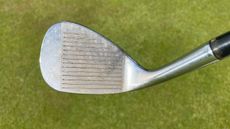
The wedge is the fastest deteriorating club in your bag, so how often do you need to change them?
By David Usher Published 26 May 23
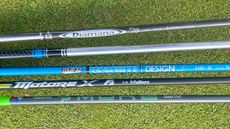
Martin Hopley explains what torque is in a golf shaft and why it benefits you
By Martin Hopley Published 26 May 23
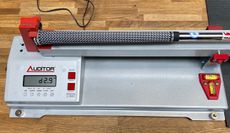
Martin Hopley explains what swing weight is in golf clubs and how it affects the feel and performance golfers experience
By Martin Hopley Published 25 May 23
- Contact Future's experts
- Terms and conditions
- Privacy policy
- Accessibility statement
- Cookies policy
- Advertise with us
Golf Monthly is part of Future plc, an international media group and leading digital publisher. Visit our corporate site . © Future Publishing Limited Quay House, The Ambury, Bath BA1 1UA. All rights reserved. England and Wales company registration number 2008885.
Golf Launch Monitor Metrics Explained | Smash Factor, Clubhead Speed, and More
Last Updated on July 25, 2021

Launch monitors (like the GCQuad, Trackman, and FlightScope) have revolutionized how we can analyze and improve golfers' games.
These devices track ball flight and club delivery, outputting specific metrics to indicate what's good and what needs improvement in your swing.
But what do all of these metrics mean, and how can you use them to improve your golf game?
In this guide, we'll explain what each of these terms mean and give you insight into how to use them when evaluating your swing and ball flight .
You can jump ahead to any section of this article or any specific metric using the following links:
Club Speed / Club Head Speed / Clubhead Speed
Smash factor, spin rate / total spin, carry distance, roll distance, total distance, flight time, launch angle, dynamic loft / impact loft, angle of attack / attack angle, spin-tilt axis, delivered lie angle, basic launch monitor metrics.
To start, we'll cover some of the more basic launch monitor metrics. Even more basic devices will track most of these metrics.
" Club Speed, " which you may also see expressed as "Club Head Speed" or "Clubhead Speed," is the club head's velocity just prior to the club's impact with the ball . This metric is usually measured in miles per hour (mph).
In general, faster club speeds lead to faster ball speeds, ultimately resulting in the ball traveling further .
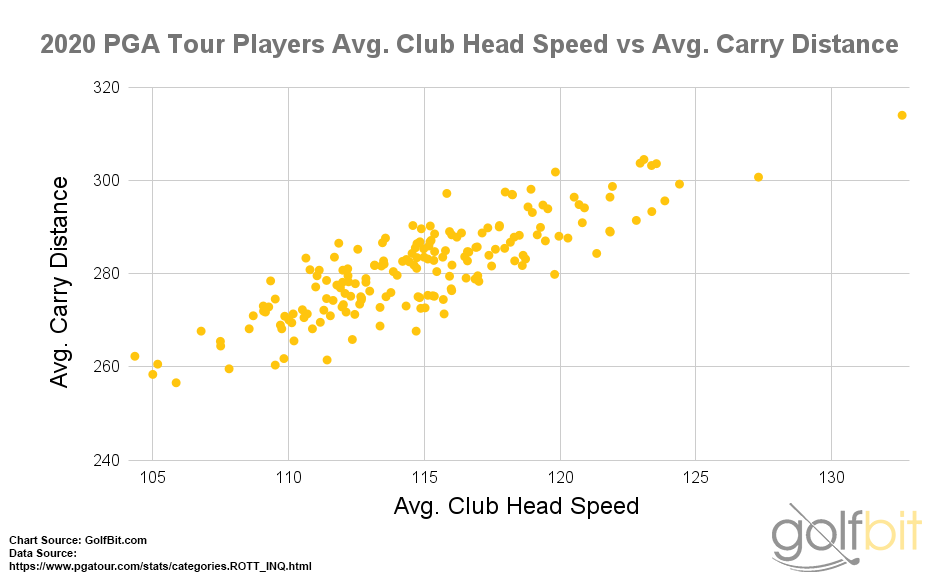
While faster golf club swingers will generally hit the ball further, other factors like how a golfer delivers their club and how much spin is placed on the ball are crucial in determining how far a golf ball will travel.
Check out the chart below for an idea of how fast different groups of golfers swing their drivers.
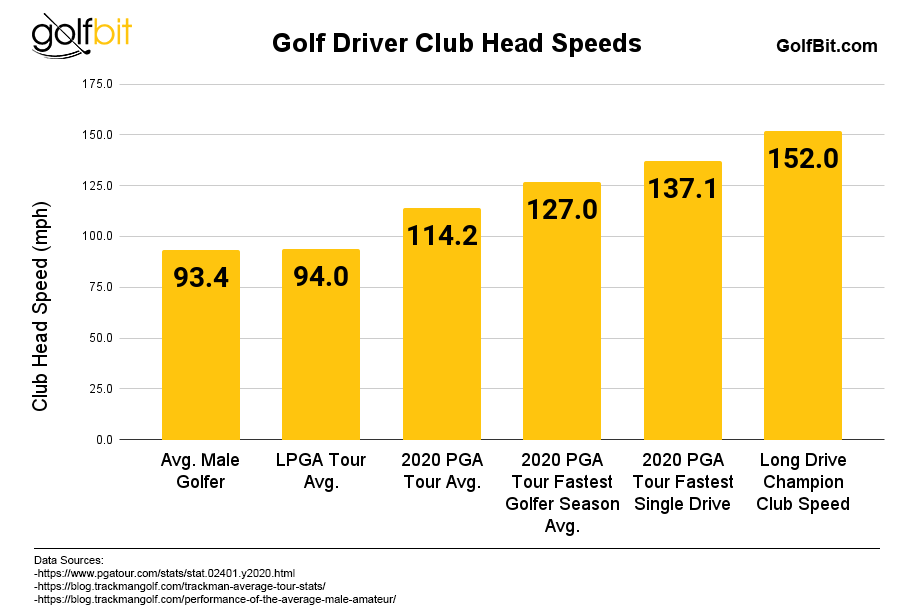
According to data from Trackman , the average male golfer swings their driver at 93.4 mph . Bear in mind this sample size includes male golfers of all age groups.
The average male golfer's driver club speed is just shy of the average among female LPGA Tour Professional golfers who clock in at 94 mph.
According to stats tracked by the PGA Tour in 2020, the average club head speed of PGA Tour Professionals is around 114 mph . Cameron Champ led the season in this category with an average club speed of 127 mph on qualifying par-4 and par-5 holes. The fastest drive of the season was achieved by Bryson DeChambeau, reaching 137.14 mph.
For an idea of what's possible at the absolute extreme end of club speed, 152 mph of club speed is roughly what it takes to win a World Long Drive competition.
As a general rule, longer clubs can be swung faster. To illustrate this, look at how PGA Tour average club speeds change for each club in the chart from Trackman below.
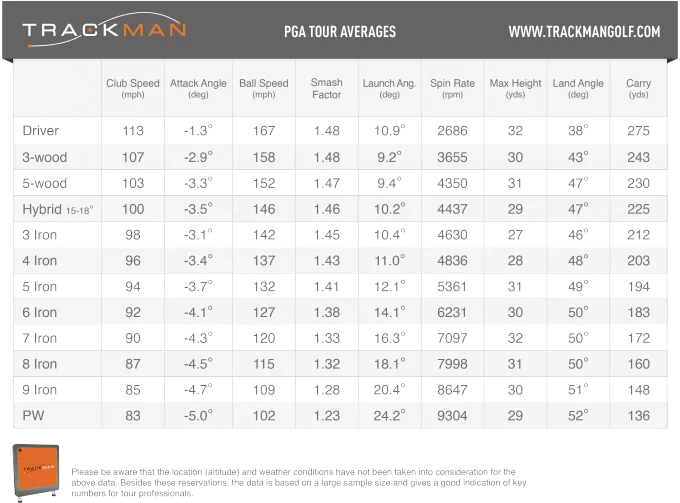
"Ball Speed" is the velocity of the ball measured just after impact. Like club speed, ball speed is most commonly measured in miles per hour (mph).
Higher ball speed will generally lead to more distance.
"Smash Factor" is a calculation of ball speed divided by club head speed.

It's excellent for determining how efficiently you are transferring energy from the club to the ball. A higher smash factor means you're more efficient.
Hitting the ball in the sweet spot of the club face and optimizing the club's delivery should be your focus for maximizing smash factor.

Looking at PGA Tour and LPGA Tour averages for each club can be used to see what smash factor numbers are possible for each club with near-optimal delivery and impact.
It's important to understand that PGA Tour club speed is not needed to achieve PGA Tour level smash factors. As the data from Trackman shows below, slower swinging female LPGA Tour golfers achieve similar or even higher smash factors than male PGA Tour players.
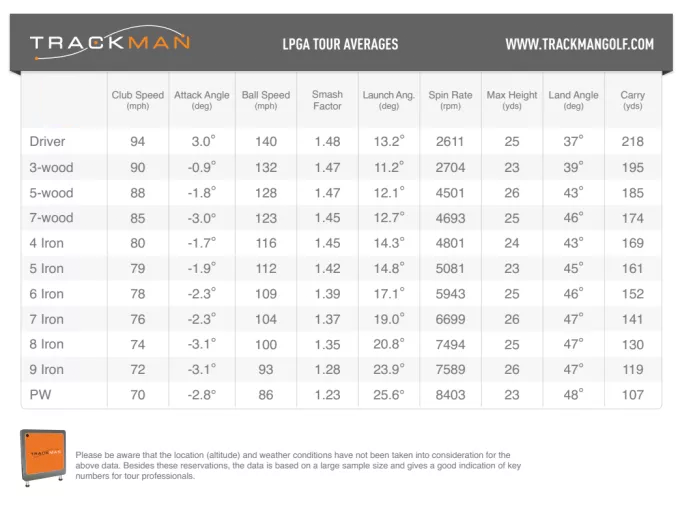
The higher LPGA smash factor averages for some clubs than PGA averages are likely due to professional female golfers being more likely to use cavity-backed irons vs the blade irons typically used by their male professional counterparts.
"Spin Rate" or "Total Spin" measures how much a ball is spinning in revolutions per minute (rpm) immediately after impact.

Golf clubs with higher lofts should generally have more spin. Higher club head speed should also lead to more spin, assuming the same club, delivery, and impact.
Optimal spin rates are player-dependent and have a lot to do with a golfer's swing speed. For example, golfers who swing their driver 105 mph or more should usually be around 2,000 rpm, while the average golfer or even slower swingers could be better suited to 2,500+ rpm.
A knowledgeable club fitter should be able to help you optimize your clubs' spin rates for your swing.
"Carry Distance" is the distance a ball travels in the air before touching the ground. While launch monitors offer other distance metrics like "Total Distance," carry distance is far more accurate and valuable to know.
With the driver, you'll be striving to increase carry distance. As we've mentioned throughout this guide, increasing club speed and improving your delivery/impact will lead to further carry distances.
Finding your carry distances with all of your other clubs is incredibly useful. Golfers tend to overestimate how far they can hit each of their clubs, but hard data will help you select the right club for the job.
Check out how far golfers hit each of their clubs .
When simulating golf, "Total Distance" is an estimate of how far the ball was hit, including any bouncing and rolling after it first hits the ground. The course condition settings you input in your simulator software will heavily influence the simulated total distance.
While total distance is nice to have for simulating games and getting an idea of what you can expect from your shots including roll, we recommend focusing more on carry distance when working on your game.
"Roll Distance" is the distance a ball rolls or bounces after hitting the ground for the first time.
"Flight Time" is a measurement of the time your golf ball stays in the air.
Advanced Launch Monitor Metrics
Now for some more advanced launch monitor metrics.
The metrics in this category can be incredibly useful to measure, giving you precise insights into your swing and club delivery. Unfortunately, most cheaper launch monitors don't track these metrics.
"Launch Angle" is the angle of a golf ball's ascent relative to the ground plane. This metric is measured right after impact in degrees.

The ball's spin, the speed of the ball, and launch angle determine how high and how far a ball will travel.
Launch angle is highly correlated with dynamic loft and thus club lofts . Higher lofted clubs should lead to higher launch angles.
Good club fitters should be able to help you find the right balance of spin rate and launch angle.
"Dynamic Loft" or "Impact Loft" is the effective delivered loft of the club face at impact.
Club delivery, including angle of attack, shaft bend, club path, contact point, etc., can all affect the dynamic loft delivered.

While a standard 6-iron has around 30-31 degrees of loft , PGA players deliver on average 20.2 degrees of dynamic loft with their 6-iron, according to Trackman.
Many amateur golfers fail to deloft their irons at impact like professional golfers. Dynamic loft/Impact loft measurements will show this.
"Angle of Attack" or "Attack Angle" measures the upward or downward path of the club head at impact in degrees .
Shots from the ground, like iron shots, should have a slightly negative angle of attack (hitting slightly down on the ball). Good golfers will impact the ground just after impacting the ball.
When the golf ball is teed up for drives, an optimal delivery has a slightly positive angle of attack on the ball (hitting up on the ball).

"Spin-Tilt Axis" is the axis that the ball rotates around . A ball's spin-tilt axis will determine a shot's shape and lift.

A shot with a spin-tilt axis to the right (indicated with a positive number rather than negative on some launch monitors) will curve left to right. A shot with a spin-tilt axis to the left (negative number on some launch monitors) will curve right to left.
Larger numbers will be sliced and hooked shots , while smaller numbers will be fades and draws.
"Club Path" measures the swing path of the club head relative to your target line measured in degrees.

This metric will tell you if you're swinging "out-to-in" or "in-to-out."
Out-to-in club paths result in a fade, while in-to-out club paths result in a draw.
"Face Angle" or "Delivered Face Angle" is the direction your club face is aimed relative to your target line at impact . Your shot will generally start on a path very similar to where the face angle is aimed.
An open club face points to the right of your target, while a closed club face points to the left of your target.
"Delivered Lie Angle" is a dynamic measurement of your club face relative to the ground . This will measure how "toe up" or "toe down" your club is at impact.

Wrapping Up
Hopefully, this guide helped you get a better grasp on how to use launch monitor metrics.
To learn more golf lingo, check out 100+ Golf Terms Every Golfer Should Know .
- Golf Terms Guide
- Golf Scoring Terms
- Best Golf Rangefinder
- What to Wear Golfing
- Terms of Service
- Privacy Policy
- Affiliate Disclosure
The science of the smash factor
Published: 23 August 2017 Last updated: 15 January 2018

Smash Factor is one of golf’s buzz-phrases. So what is it, and how do you up yours?
Is there a better feeling in golf that ripping a drive right down the middle? When everything comes together – aim, swing plane, impact zone, finish – it yields long, soaring shots that we admire as they fly. And one number in particular is crucial to achieving this more often; Smash Factor.
You may have heard commentators talk about it on TV. If you’ve ever been fitted for a set of clubs you’ve certainly heard of it. But what is it? Why is it so important? And how can you increase yours?
Put simply, Smash Factor is the ratio of ball speed to clubhead speed on a given shot – in other words, a measure of the efficiency of impact. Limitations placed by physics and the rules on club and ball design have given smash factor a nominal upper limit of 1.5 (15 players on the PGA Tour currently hit this, or slightly above) – in other words, in a perfect world a 100mph impact clubhead speed would produce a 150mph ball speed.
But why does that matter to you and me? Well, as a measurable figure it is the proof that quality-of-strike can override clubhead speed when it comes to distance. With better Smash, your driving distance can go up, even when your swing slows down. Smash Factor shows the bene t of hitting better over hitting harder. And that, in theory, should stop us lashing at the ball.
“Smash Factor is important as it helps you ensure that every drop of effort you put into hitting the ball is being converted into distance,” says club- fitting specialist Jason MacNiven of fitting specialist Golf Principles.
“As far as distance goes, it’s not the only god – in fact there is a perfect triangle of smash factor, spin rate and launch angle – but working on it certainly plays a valuable part in helping you become a better driver.“
According to MacNiven, the average club golfer has a Smash Factor somewhere in the region of 1.35-1.4. And as you might expect, getting that figure up has much to do with nding the driver’s sweetspot.
“In the most technical definition, the sweetspot is the actual point of balance inside the clubhead that we refer to as the centre of gravity,” says American club- fitting expert Tom Wishon. If you hit the ball so the centre of the ball is directly in line with the clubhead’s centre of gravity (CoG), there will be no loss of energy in the shot.”
So far so good. But here comes the bad news. “The centre of gravity is a single point about the same size as the full stop at the end of this sentence,” Wishon adds. “When impact occurs such that the centre of the ball is not in line with the clubhead’s CoG, energy is lost, as does distance.”

Two ways to boost YOUR Smash Factor
Shaft length
Based on 10 years of custom- fitting feedback, US club- fitting legend Tom Wishon believes that for golfers with a handicap between 10 and 26, over 75% will hit the ball longer and straighter and more on-centre with a shorter length driver than what the golf companies are selling off the shelf.
Total weight and swingweight
All clubs sold off the rack are made to one standard total weight and one standard swingweight. It is very possible that many, many golfers are using clubs in which the total weight and/or swingweight do not match their inherent swing tempo. From that, they don’t “time” shots for maximum efficiency and/or lose valuable speed.
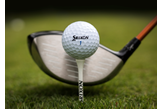
Smash Factor Calculator (Chart for Each Club): 2024 Why Should You Care?
Even if you’ve never heard of the term “ smash factor ,” it sounds fantastic. Everyone wants to “smash” the golf ball further and farther away on every hole, so why not?
The ability to hit the ball far is an essential factor in golf, but there are many other elements to consider. With a calculator , you may be capable of getting something out of your swing and adding yards to your drives by measuring your smash factor and other vital data.
A basic understanding of the smash factor in golf, as well as how to use a smash factor calculator, will be provided in this article. Read on to learn about some golf tips!
Smash Factor: What Is It?
One of the pieces of information that a launch monitor or Automatic Tracking System gives is the smash factor. It is obtained by adding the ball’s speed and the clubhead’s speed. It can be found on a broad range of launch trackers. The Power Transfer Index (PTI) is another name for the Smash Factor.
In golf, the smash factor is the ball speed divided by the clubhead’s speed. The greater the smash factor, the more energy is transferred from the club to the ball. It depends on your swing, the golf ball, and the face of the club.
For instance, if the speed of the ball was 128 mph and the club’s rate was 88 mph, your smash factor would be 1.45 (128/88 = 1.45).
Most of the time, the best golfers aim for a 1.48 smash factor with their driver and a 1.41 smash factor with their mid-irons. But it’s essential to mention that any number of golfers can get these numbers.
Even a young child with a successful relationship between his club speed and ball speed could get a 1.48 smash factor!
Smash Factor Calculator Tool
A smash factor calculator is a tool that was scientifically developed to measure the amount of energy a golf club can transmit onto a ball. It directly correlates to the ball speed you anticipate producing with each club in your bucket.
Although more significantly, it is a statistic you can use to determine how effectively you hit the ball, which may clarify why you aren’t striking it. However, you would like to, given your present swing speed.
What Makes Smash Factor Significant?
First and foremost, the smash factors significantly impact how far we can strike the golf ball.
From a distance standpoint, it’s critical to comprehend the significance of ball speed because it completes the three key elements of distance together with launch angle and spinning rate.
Notwithstanding this, most players chase club head speed, which, while essential, becomes nearly unnecessary without the right ball speed.
Reducing the smash factor is intended to improve distance control since it can be challenging to control a ball leaving the club’s face too quickly.
A PGA Professional from the United Kingdom, James Ridyard, has done some excellent research on the smash factor in wedges, focusing on the concept of regulating spin loft.
With a club head speed of 60 mph, a four-degree spin loft inaccuracy can cause a thirty-foot error.
How To Improve Smash Factor With Driver
Golfers should concentrate on clubface and path accuracy, making a central strike, and understanding attack angles if they want to improve their smash factor.
Targeting the center of the club will have similar advantages to aligning the clubface and path, which will prevent you from making ineffective low-velocity contact.

Optimizing the strike angle will give the ball the right spin to sustain speed and increase distance.
First Factor: Direction and Clubface Orientation
To preserve the smash factor and distance, you must hit a shot straighter with little to no transverse spin. If you’re unsure whether your clubface will be open or closed at impact, take some slow swings with a magnetized orientation rod to obtain instant feedback.
Second Factor: Middle Strike
The swing speed momentum will be lost if the ball has too much contour, which will reduce its speed. Try putting a standard roll (for alignment reasons) on your golf clubs to see if you are swinging the bat out of the club’s center.
As a result, you will be able to pinpoint where you strike the ball with your clubface, allowing you to concentrate on changing bad habits.
Third Factor: Attacking Angle
You won’t be able to fully impact (strike) the ball considering your clubhead speed if your attack angle is too high or too narrow.
Furthermore, if you provide too much loft, you will also witness a decline in the smash factor and ball speed to hit the ball lower.
In the ideal case, the attack angle and loft of the club should be optimized or aligned to keep them close to one another.
Smash Factor Chart for Each Club
An analysis of each of the golf club distance categories will be presented in this section. There are three main categories—the golf club distance for men, women, and professionals in each distance category. The following chart compares each club based on its smash factor. Keep reading!
Golf Club Distance Predictions For Men
The statistics are estimates, and the introduction demonstrates that the range of 2 iron to 4 iron is not particularly exceptional. Even a 2-iron and a 3-iron should be optimistic in the standard portion.
These are challenging clubs to smash and typically travel very little distance due to alignment and swing speed issues. Golfers with high handicaps and little expertise should avoid these clubs for some time.
The 2 iron down through the 5 iron, starting with “Top Players,” should improve as comfort and precision increase, leading to a faster swing speed.
Golf Club Distance Predictions For Ladies
Women will typically strike the golf ball at a shorter range than men. Even women’s elite division (driver) might have a lower estimated strike range compared to men’s advanced division.
However, the women’s precision is significantly higher than the men’s when analyzing equal distances from the superior to the mediocre (lower) level.
Golf Club Distance Predictions For Pro and Senior
The figures are approximations; from analysis in the professional part, the driver to 9-iron ratio is relatively high. According to statistics, the distances range from 196 to 105 yards (from driver to PW). This serves as a motivational board for male novices and even top women.
PGA Tour Average Smash Factor Chart for Each Club
According to the PGA TOUR statistics , the smash factor values for each player in each tournament are listed. The smash factor scores are all excellent, so I assume everyone strikes the ball well.
According to the study, the driver has a smash factor of 1.48 at a club speed of 94 mph, an attack angle of 3.0 degrees, and an optimal carry.
For a 6-iron, a semi-trajectory club speed of 78 mph yields a smash factor of 1.41. A 70-mph club speed and semi-trajectory for a pitching wedge deliver a smash factor of 1.28.
LPGA Tour Average Smash Factor Chart for Each Club
With their driver, LPGA tour professionals have a smash factor of roughly 1.48, which is precisely scratch level.
Tour players, however, are probably smashing the ball with a faster clubhead speed, making this smash factor much more remarkable and striking it farther.
Even players with ten handicaps had a smash factor of 1.45 on average, just 0.04 below that of an LPGA Tour player.
For this reason, it’s crucial to consider the ball speed, smash factor, and club head speed as a whole to identify your game’s benefits and potential areas of improvement.
Tool for Converting Smash Factor to Ball Speed
The smash factor calculator is a scientifically made tool that measures how much power a golf club can put into a golf ball. To get the “ball speed,” the calculator multiplies a club’s smash by the clubhead’s speed.
How to Increase Smash Factor
To boost the smash factor in golf, you must align the clubface with the direction and locate the middle of the club.
You will reduce ball speed if you pick up the ball from the toe or heel. Your contact’s reliability will decline due to these glancing strikes, negatively influencing smash factor values.

When starting a path to increase your smash factor aimlessly, it is crucial to decide what you want to accomplish.
Depending on how quickly you swing the club, you can strike the ball even further with a lower smash factor because the ratio between a given clubhead speed and ball speed is all that matters.
In the end, you can achieve this through specific training and adjustments to your current swing speed.
If you’re looking to improve your smash factor by being more effective and starting to get a bit more out of your previous swing tactics, a Super Speed Golf Training System is an ideal tool.
What Causes a Low Smash Factor?
The two elements that have the most critical bearing on the smash factor are:
The Strike Point and the Spin Loft
The spin loft is the angle and attack angle formed by the loft. The spin loft is the three-dimensional angle formed by the movement of the club head (the club head consists of the club path and the attack angle) and the direction of the club face (the club face consists of the face angle and the dynamic loft).
The effectiveness of energy transmission into the ball decreases as the spin loft angle rises. In other words, at any given club speed, the ball will leap off the face of the club more slowly.
Spin loft affects how quickly the ball leaves your club face, how much it spins, where it swings, how high you hit it, and how well you translate your effort into the distance.
When evaluating the smash factor, hitting the ball with the sweet spot of the club is also crucial. You are aware that not all off-center hits result in long drives and that it is essential to manage the ball’s striking point while aiming for a significant smash factor.
But statistically, the PGA Tour totals a player’s driving and greens in average data to determine how well they hit the ball. The sum of a player’s driving distance and precision positions is known as total driving.
Is a 1.45 Smash Factor Good?
A smash factor of 1.45 is considered to be the standard. A smash factor of 1.5 is above the median, but most players who play for fun have a smash factor of about 1.45.
Great players generally have a higher smash factor no matter what club they play for.
What Is The Optimal Smash Factor?
In summary, a smash factor of 1.5 is best, but amateur players only have a smash factor of 1.42.
If the amateur golfer struck the ball solidly in the center of the club face with a 1.5 smashing factor which is an ideal smash factor for each club, the ball speed would go up by 140 yards per hour, and the rotation would go down by around thirty percent.
What Is a Good Smash Factor for 7 Iron?
The scores from the launch angle monitors vary from 1.3 to 1.46 for the “smashing factor of the 7-iron” With this, a smash factor of 1.46 is the best.
The smash factor is just one newly added part of golf. It has only recently come to people’s attention because launch monitors and other tech have become more commonly accessible.
Even though the smash factor is an excellent way to tell if you are getting the most out of your swing, you might need to increase clubhead speed before increasing the smash factor and getting more distance.
But if you want to get better and are willing to pay for a launch monitor, the smash factor is a helpful fact worth testing to help you make the best swing speed possible.
Leave a Comment Cancel reply
Save my name, email, and website in this browser for the next time I comment.
WeekendGolf is a participant in the Amazon Services LLC Associates Program. As an Amazon Associate, I earn from qualifying purchase. To support our site we may earn a commission if you purchase through some of the links listed above at no additional cost to you.
Tee Precision
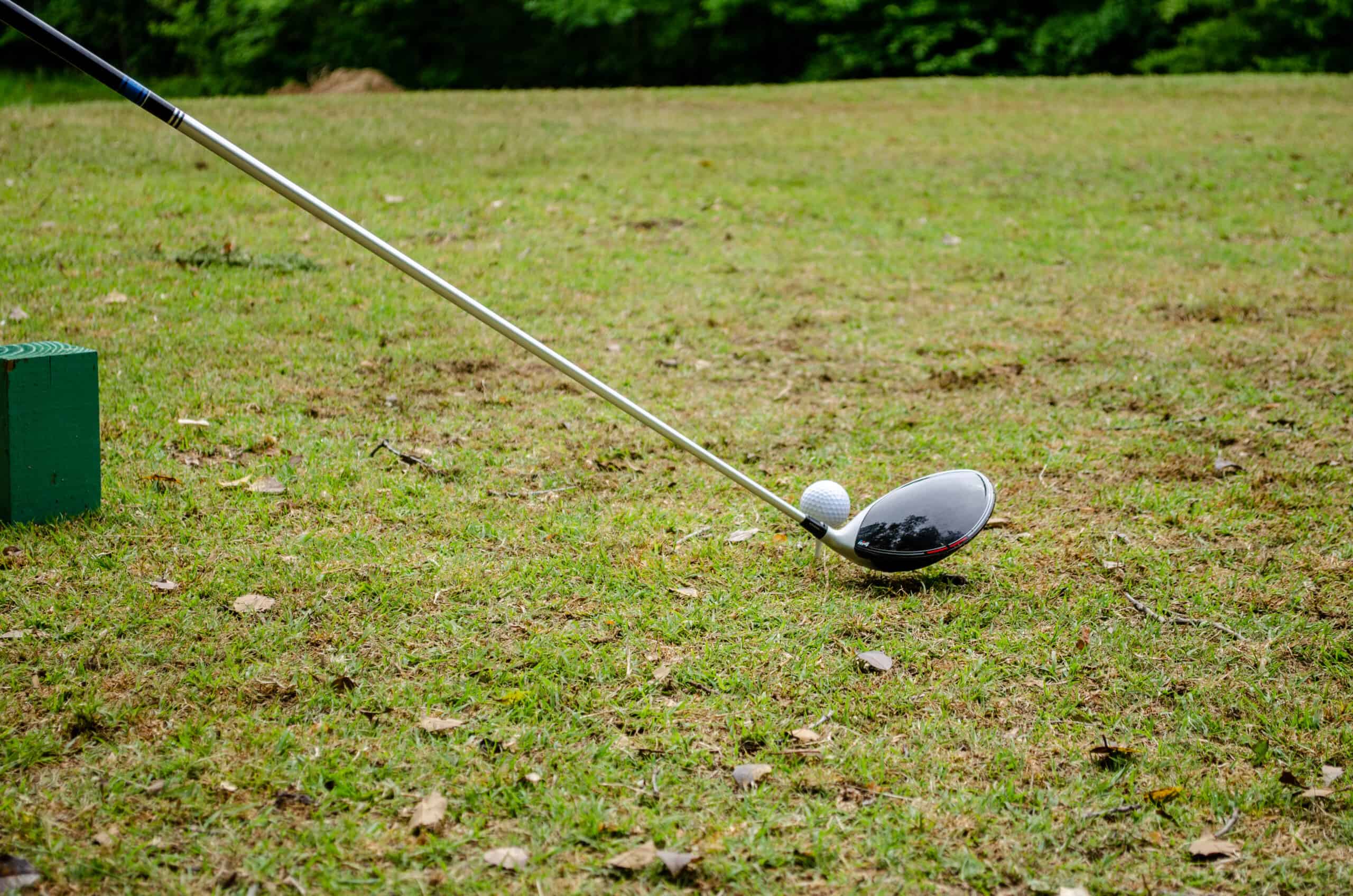
What Is Smash Factor In Golf?
Golf is a game of precision and technique, and one of the most important aspects of the game is ball striking. To hit the ball farther and with greater distance, golfers need to pay attention to their swing speed, attack angle, launch angle, and spin loft. But there’s another key metric that can make a big difference in the game: smash factor.
Smash factor is a term that refers to the efficiency of a golfer’s swing. It measures how much ball speed is generated from the club head speed, and it’s calculated by dividing ball speed by clubhead speed. Essentially, it’s a measurement of how well the golfer hits the sweet spot of the club face. A higher smash factor means that more energy is transferred from the club to the ball, resulting in greater distance and improved ball flight. In this article, we’ll explore what smash factor is, how it’s calculated, and how you can use it to improve your golf game.
Table of Contents
How is smash factor calculated, what is a good smash factor for a driver, smash factor chart for each club, how to increase your smash factor number, what is the best smash factor number, pga tour player with the highest smash factor number.
The calculation of smash factor is relatively straightforward, although there are a few key factors to consider. Essentially, it is a measurement of the efficiency with which a golfer is able to transfer energy from their swing into the ball. To calculate the smash factor, you need to measure two key pieces of data: ball speed and clubhead speed.
Ball speed refers to the velocity of the golf ball as it leaves the club face after impact. Clubhead speed, on the other hand, refers to the speed at which the golf club is traveling just before it makes contact with the ball. To calculate the smash factor, you simply divide the ball speed by the clubhead speed. For example, if your ball speed is 150 miles per hour and your clubhead speed is 100 miles per hour, your smash factor would be 1.5 (150 divided by 100).
There are a few things to keep in mind when calculating smash factor. First, it’s important to use accurate measurements of ball speed and clubhead speed. This can be done using launch monitors or other specialized equipment. Additionally, different types of golf balls and clubs can affect smash factor, so it’s important to be consistent in the equipment you use when making measurements. Finally, it’s worth noting that the average golfer’s smash factor tends to be lower than that of a professional golfer, but there are ways to improve your smash factor over time.
A good smash factor for a driver can vary based on a golfer’s skill level and swing characteristics. However, as a general rule, a good smash factor for a driver is around 1.50. This means that for every 1 mph of clubhead speed, the ball should travel 1.5 mph. So, if a golfer has a clubhead speed of 100 mph, a good smash factor would be 150 mph.
For professional golfers, the average smash factor with a driver is around 1.48 to 1.50. This means that they are getting optimal energy transfer and ball speed from their swings. However, for amateur golfers, the average smash factor is typically lower. The average amateur golfer has a smash factor between 1.25 to 1.35 with their driver.
It is important to note that a higher smash factor doesn’t necessarily mean more distance. Other factors such as launch angle, spin rate, and ball speed also play a significant role in determining how far the ball travels. However, having a good smash factor can help golfers hit the ball farther and more consistently, leading to better overall performance on the course.
Smash Factor For Each Club
For amateur male golfers, the average smash factor varies by club due to differences in loft and clubhead speed. According to data from Golf Digest , here are the average smash factors for each club:
It’s worth noting that these average smash factors can vary depending on a golfer’s skill level, swing speed, and club fitting. However, generally speaking, a higher smash factor indicates better ball striking and can lead to greater distance off the tee. So, if you’re an amateur male golfer looking to improve your game, it’s worth striving for a high smash factor with each club.
Improving your smash factor is critical to maximizing distance and accuracy off the tee. Luckily, there are several things you can do to increase your smash factor number. First, try to improve your swing speed. The faster your clubhead speed , the more energy you’ll transfer to the ball upon impact, resulting in higher ball speed and a better smash factor. To improve your swing speed, you can practice with weighted clubs or do exercises that focus on improving your strength and flexibility.
Second, work on your ball striking. Hitting the ball on the sweet spot of your clubface will result in a higher smash factor. Try to make solid contact with the ball and focus on hitting the center of the clubface. This may require adjusting your swing path or making sure your clubface is square at impact.
Third, consider getting a club fitting . Ensuring that you have the right shaft flex, loft, and clubhead design can make a significant difference in your smash factor. A club fitting can help you find the right combination of club specs to maximize your smash factor and distance off the tee. By implementing these tips, you’ll be on your way to improving your smash factor and hitting longer, more accurate drives.
The best smash factor number varies based on a golfer’s individual swing characteristics and skill level. Generally, a good smash factor for drivers is around 1.50, while for irons, it ranges between 1.30 to 1.50. However, a high smash factor alone does not guarantee longer distance or better ball flight. Golfers should aim to strike the ball with the sweet spot of the clubface for maximum energy transfer, and with the correct launch angle and spin for optimal ball flight.
For professional golfers, an ideal smash factor number may be higher than that of an amateur golfer. On the PGA Tour, players typically have a smash factor of 1.48-1.52 with their drivers, while LPGA Tour players have a slightly lower average at around 1.43-1.47. These professionals are able to achieve higher smash factors due to their superior technique and ability to hit the ball with the center of the clubface more consistently. However, it’s important for amateur golfers not to compare themselves to professionals and instead focus on improving their own smash factor numbers through proper swing mechanics and technique.
Ultimately, the best smash factor number is one that allows a golfer to achieve their desired ball flight and distance while maintaining consistency and accuracy. By experimenting with different clubs, swing paths, and launch angles, golfers can determine the optimal smash factor for their game and work towards achieving it.
The PGA Tour is home to some of the most talented golfers in the world, and many of them boast impressive smash factor numbers.
Here are the top 5 players for 2022:
And here are the top 5 players through the first 3 months of 2023:
In conclusion, smash factor is a crucial element in determining the efficiency and distance of a golfer’s shots. It measures the amount of energy transferred from the clubhead to the golf ball during impact, which is directly related to ball speed. A higher smash factor leads to a longer and more accurate shot.
By improving your swing mechanics and optimizing your equipment, you can increase your smash factor number and hit the ball farther with greater distance control. While the optimal smash factor may vary from player to player, the average for a driver is around 1.45.
PGA tour players have some of the highest smash factor numbers in the game, with Bryson DeChambeau currently holding the highest recorded number at 2.00. However, it’s important to remember that smash factor is not the only metric for success in golf and that a well-rounded game requires a combination of skills and strategies.
- Recent Posts
- Should Tee Boxes Be Level? - January 23, 2024
- 3 Hybrid Distance - November 15, 2023
- Innovations in Golf Mobility: An In-depth Review of Top Golf Scooters - October 12, 2023
Golf Blog & Instructional Golf Videos
How Smash Factor Helps Us Maximize Swing Speed
Mastering smash factor, maximizing speed.
You know how satisfying a solid drive can be. There’s the clean “ thwack” of the club making contact. The spin of the ball. The feel of solid impact.
Nothing feels better than smashing the ball. And smashing the ball begins with a very simple concept:
You have to hit the ball in the center of your clubface.
Of course, if you’ve been golfing any amount of time, you know centering the golf ball is easier said than done. And if you’re new to golf, you may have a difficult time judging your contact simply by the feel of it. The best way to evaluate and improve your contact is by actually knowing your smash factor.
I will explain exactly how to use smash factor to make sure you’re hitting the ball in the center of the clubface. But first, let me clarify exactly what “smash factor” is.
What is Smash Factor?
To put it simply, Smash Factor is a calculation between your clubhead speed and ball speed. Now, for those who like to know the exact math:
Smash Factor = Ball Speed / Clubhead Speed
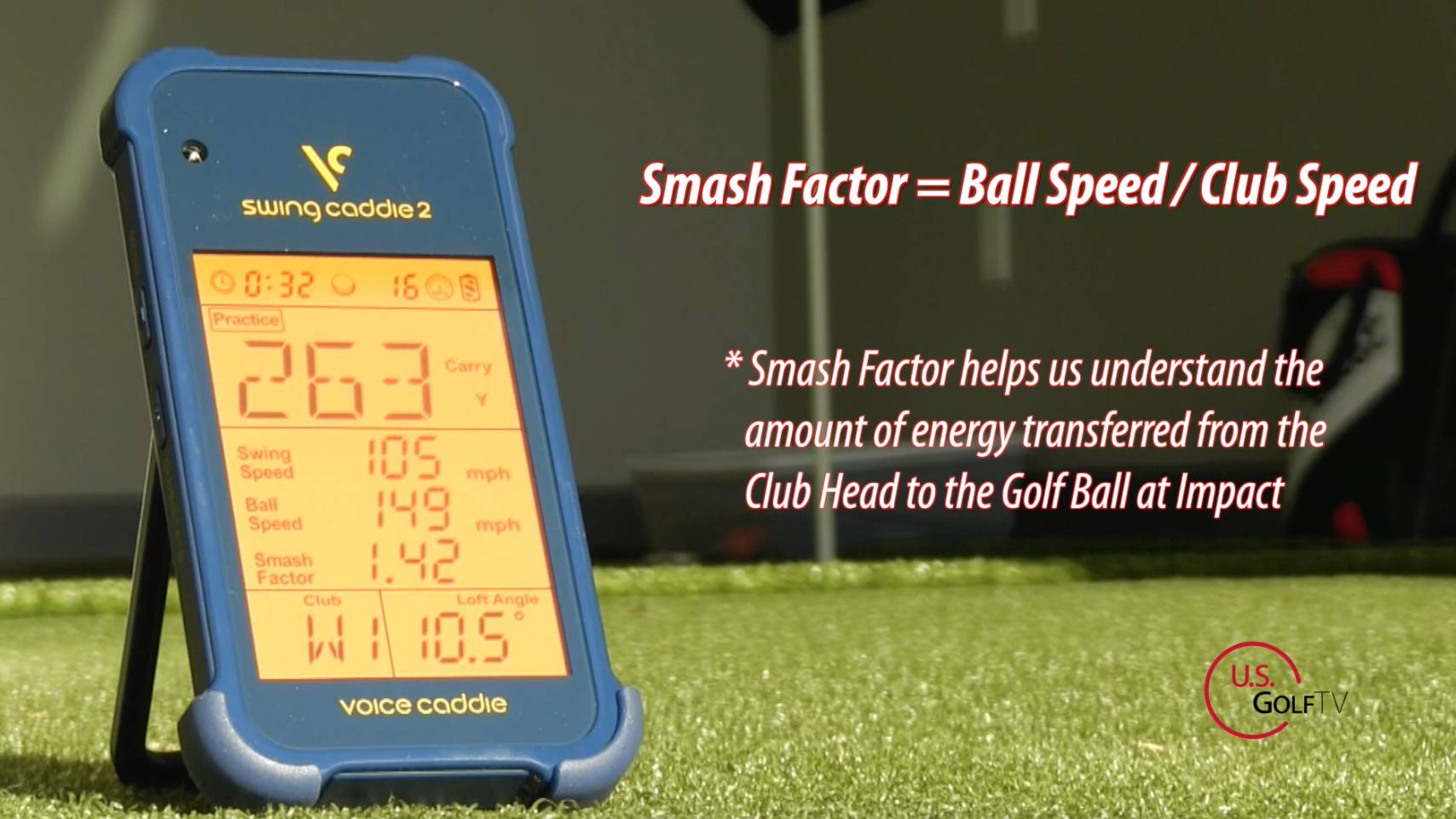
So why do we care about this calculation?
Well, the speed of your golf ball depends on two major factors. One factor is the speed of your swing. This is what I mean by “clubhead speed.”
The other factor is the amount of energy transferred from the clubhead to the golf ball at the moment of impact. This is what we refer to as the “smash factor.” The smash factor tells you if you’re hitting the ball cleanly and in the center of the clubface. Or to look at the big picture: it tells you if you’re making the most of your swing speed.
When using a driver, the smash factor to strive for is 1.5. This is the gold standard.
How do you know what your smash factor is? And once you know, how do you improve it?
It’s easiest to explain by example, so I performed a field test to demonstrate this process. Here’s what happened.
https://youtu.be/PGy4vtikvUc
Smash Factor Field Test
As I mentioned, the ideal smash factor on a driver is 1.5. The gold standard is a little lower for an iron, so for the sake of simplicity, I used a driver. In fact, I used my old driver from college. I was just curious how an outdated driver would do compared to the more advanced clubs we use today. This old driver did not let me down.
To measure my smash factor, I used Voice Caddie’s portable launch monitor . I use the SC200 model, also known as the Swing Caddie 2 .
If you’re not familiar with the SC200, let me give you a quick rundown of what it’s for and how it’s used.
Using the Swing Caddie 2 for Smash Factor
The SC200 is an affordable, portable launch monitor . The device is battery operated and is about the size of your smart phone. To use it, you just have to set it up behind your ball. With each shot, the SC200 tells you vital information about your swing. These stats include your carry distance, swing speed, ball speed, and – of course – your smash factor.
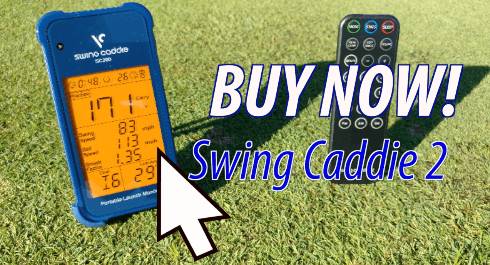
The Swing Caddie uses barometric pressure calibration to provide the most accurate readings possible. In fact, I have actually tested this device against the launch monitor we use at the Todd Kolb Golf Academy. Our unit is the industry standard and costs upwards of $15,000. When I tested both launch monitors side-by-side, they gave me near-identical readings.
The SC200 has several convenient features, including a remote control and Voice Distance Output. You can program the device according to whichever club you are using and even adjust the loft angle for greater accuracy. The SC200 also has three different modes depending on how you want to focus your practice time.
Now, there are many aspects of your game that can be helped by regular use of a launch monitor. In fact, I cover other uses for the SC200 in a handful of other articles and videos. For now, let’s just focus on smash factor.
To get started, I set my SC200 up on the ground behind my ball and used the remote to change the club setting for my driver. I took my first shot. It felt solid and a little bit on the toe.
This is the first important detail – how the moment of impact felt in my hands. If you haven’t been golfing very long, you may have a difficult time feeling where you hit your ball on the clubface. That’s normal. It also explains why it’s so important to start noticing how each shot feels when you practice with your launch monitor. When the SC200 shows you your smash factor, you can connect that number with the way your shot felt. You will start to recognize how a solid shot feels. As a result, you will have a better shot at reproducing that feeling and smashing the ball consistently.
The smash factor is highest when you hit the ball on the center of the face or a little towards the toe. This particular shot felt solid, and it felt like I hit it a little bit on the toe. Sure enough, these were my readings:
Carry Distance: 284 yards
Swing Speed: 105 mph
Ball Speed: 157 mph
Smash Factor: 1.49
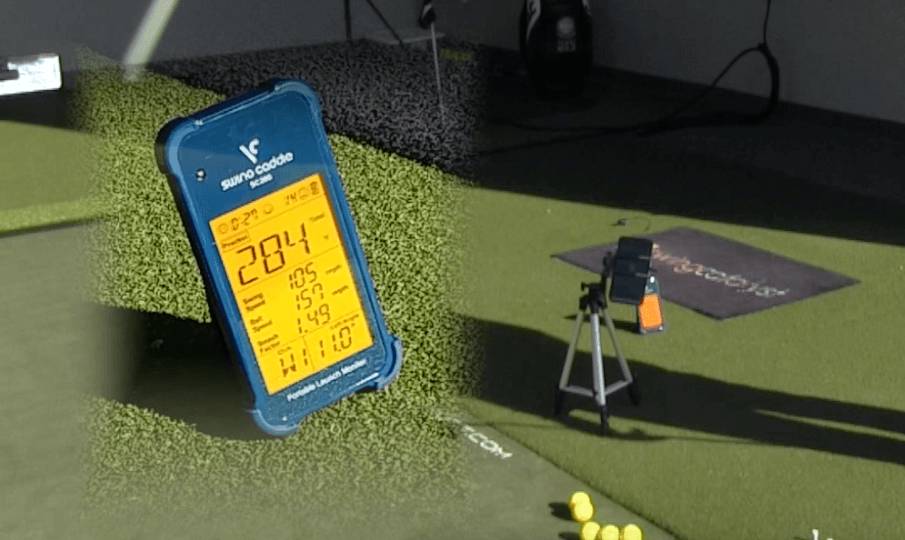
The SC200 confirmed that my smash factor was as good as it felt. Because I hit the sweet spot on my clubface, I was able to turn a 105 mph swing speed into a 157 mph ball speed. This calculates to a smash factor of 1.49, very close to the 1.5 gold standard.
My second swing did not feel as solid as the first. In fact, it felt like I hit the ball a little bit on the heel of the clubface. I also noticed that the resulting ball flight was up and to the right – another indication that I had hit this one on the heel.
Once again, the SC200 confirmed what I felt.
Carry Distance: 280 yards
Ball Speed: 155 mph
Smash Factor: 1.47
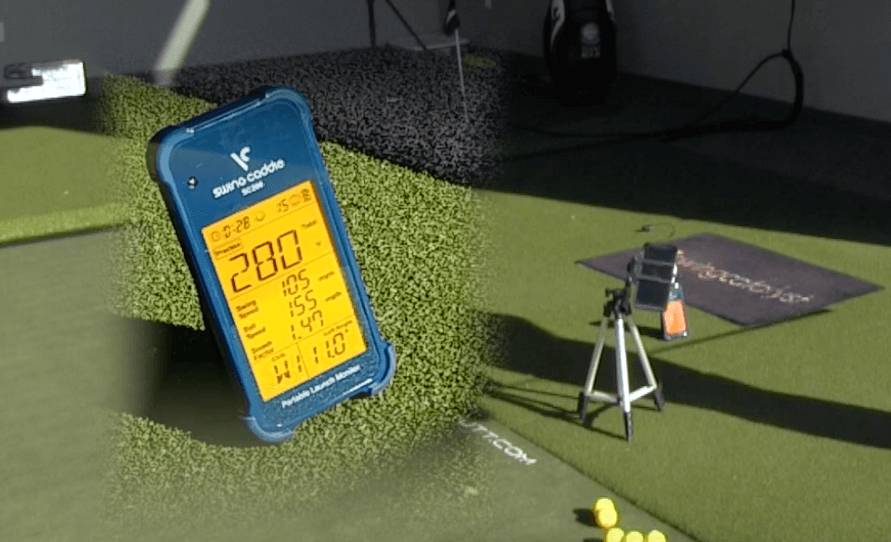
As you can see, the smash factor for this drive was only 1.47.
To further illustrate my point, let’s compare these readings to those of my previous drive.
Beyond the Numbers
You may notice that my swing speed is identical on both shots: 105 mph. However, my smash factor was lower on the second shot. This is because I didn’t hit the ball in the center of the clubface. Rather, I hit it on the heel. As a result, the energy transfer from clubhead to ball was less than it should have been. My ball speed went down by two mph, and I lost four yards on the carry distance.
This is a perfect example of how smash factor influences the success of your drive. Good clubhead speed means nothing if you can’t send that energy cleanly into the ball.
Now, let’s take a look at the third test.
I tried to hit my third shot a little harder. Like the first drive, this one hit a little towards the toe. That solid contact combined with my increased swing speed resulted in some good numbers. Here were my readings on the SC200:
Carry Distance: 287 yards
Swing Speed: 107 mph
Ball Speed: 160 mph
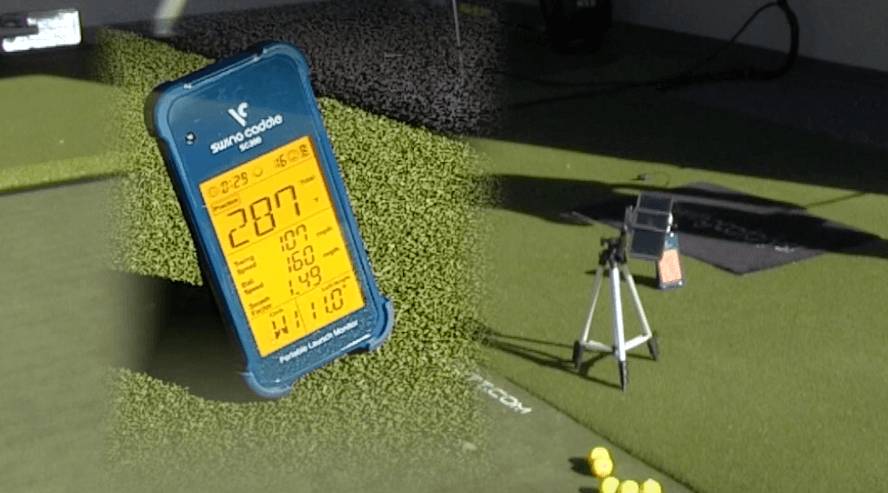
Now, let’s compare this to my previous best, Test #1.
Smash Factor Comparison Results
On both drives, I kept the smash factor up near the gold standard at 1.49. As a result, it helped me maximize the extra energy I packed into my third swing. With a new swing speed of 107 mph and a maintained smash factor of 1.49, I added three mph to my ball speed and three yards to my distance.
When you see all your numbers laid out like this, it’s easy to see why it’s so helpful to have a tool like the SC200 on hand. Two of these four stats—swing speed and smash factor—give you vital information about the effort you bring to the swing. Therefore, when you see how fluctuation in those two factors influence the other numbers, you can discover weaknesses in your game.
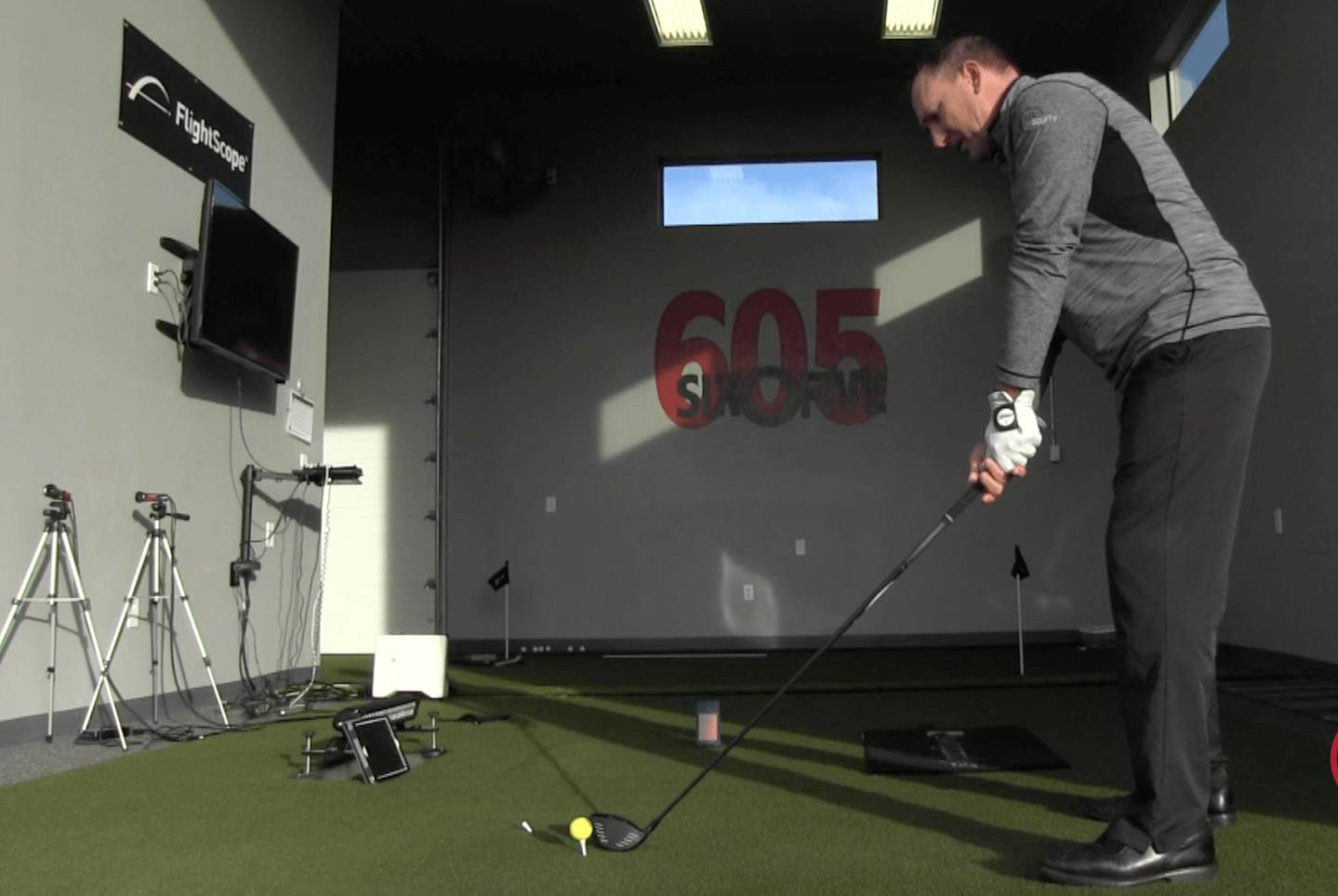
Let’s take a look at all three tests side-by-side.
What the Numbers Tell Us
You can see that Test #1 shares an identical swing speed with Test #2 and an identical smash factor with Test #3. However, there are no identical results… no identical ball speeds or carry distances. As a result, in Test #2 the identical swing speed is undermined by a less-than-perfect smash factor. Consequently, in Test #3 the identical smash factor is able to do quite a bit with the increased swing speed. Therefore, having this information helps you understand where your game might be lacking.
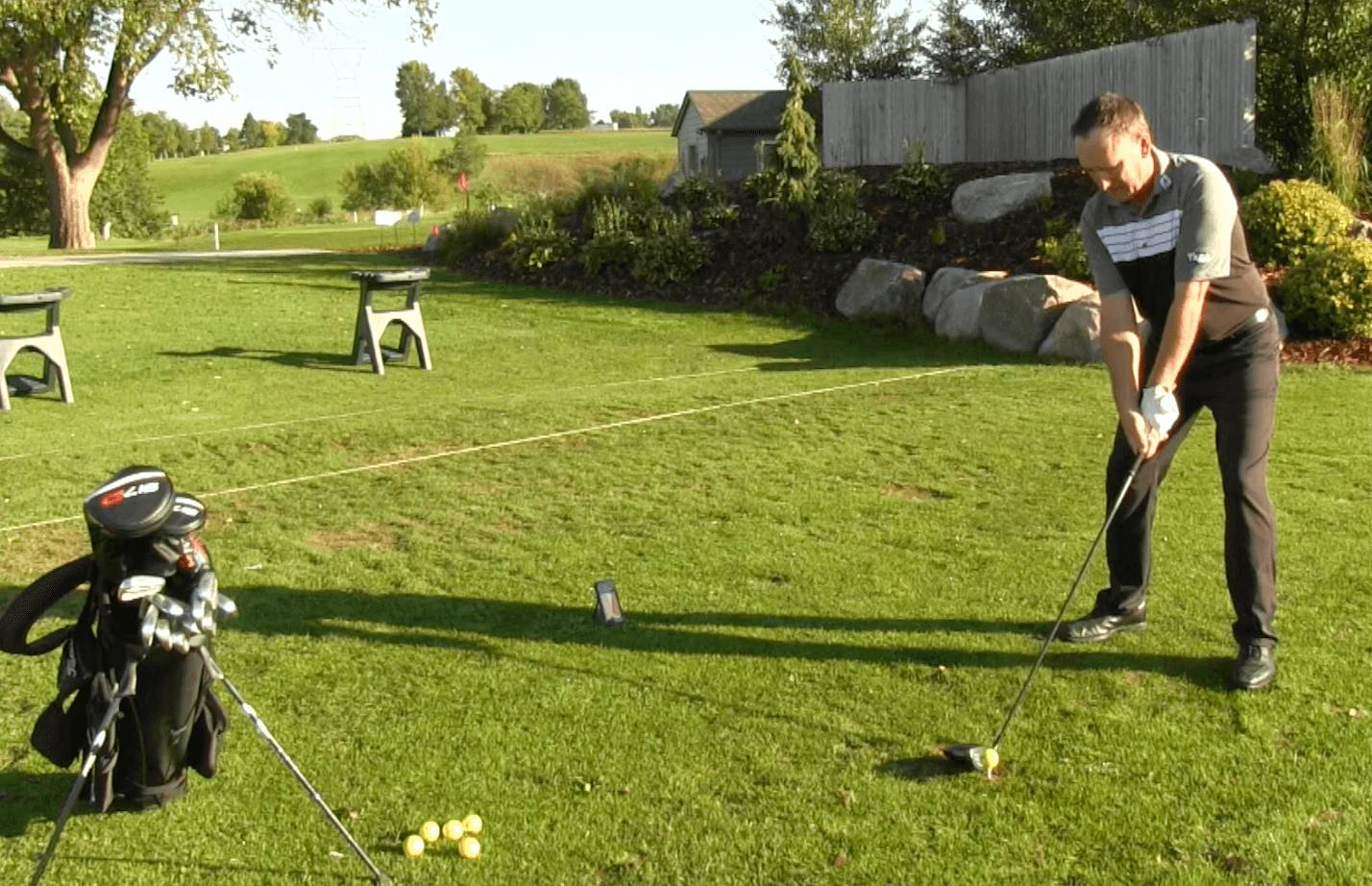
Moreover, the beauty of the SC200 is that it gives you these number automatically. In fact, it will be much easier for you to learn what a 1.5 smash factor feels like if you immediately know you’ve achieved one.
So, to review…
Smash Factor Takeaways
Smash factor is the key to achieving a long, controlled drive.
In fact, the term “Smash Factor” is a calculation between your swing speed and the resulting ball speed. It shows you how well you are transferring energy from the clubhead to the golf ball. A smash factor of 1.5 is ideal for a driver.
To smash the ball, you need to hit the ball on the center of the clubface or a little towards the toe.
Smash factor is the key to maximizing your speed. It is not enough to hit the ball hard. You also have to hit it correctly.
The SC200 is a great, affordable tool to help you track your smash factor and note how its impact on your game.
What Do You Think?
Has this been helpful to you? Do you disagree or have pointers of your own? Share your thoughts in the comment section.
If you’re interested in knowing more about the Swing Caddie 2, stay tuned! We have several articles and videos sharing how you can use this tool to sharpen your skills and why we at U.S. Golf TV trust the SC200.
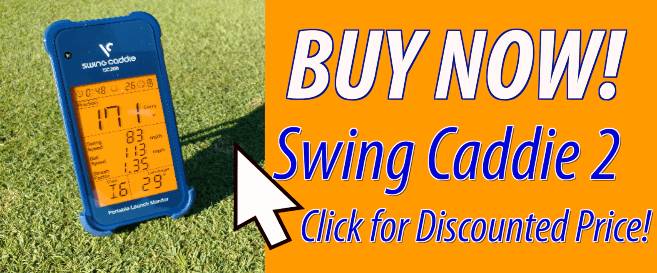
Your email address will not be published. Required fields are marked *

Smash Factor In Golf: How To Boost Your Numbers (Hit It Flush)
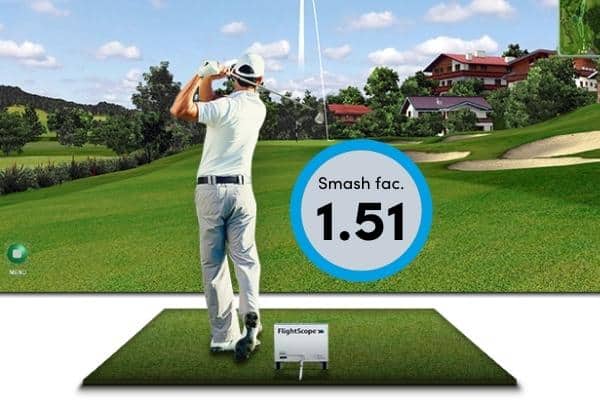
Put simply, smash factor is the relationship between ball speed and clubhead speed , a measure of both speed and efficiency in golf.
With a rise in the use of technology like FlightScopes and simulators, more and more people are becoming aware of data, like smash factor, that would have once only got attention from the top pros.
So, how does smash factor measure efficiency?
Whenever you swing a driver – or another club, but smash factor seems to be predominantly a driver-based obsession – the amount of clubhead speed you can maintain and turn into ball speed will largely influence the distance you hit the ball.
A smash factor number is calculated by dividing ball speed by clubhead speed, with an outcome of 1.5 seen as the ‘holy grail’ of an efficient golf swing.
If you swing the club fast and also have a high ball speed, then you will likely hit the ball a long way and have a high smash factor.
If you swing with a lower clubhead speed which produces a lower ball speed, you won’t hit the ball as far, yet your smash factor may still be OK.
The big issue we want to avoid is having a high clubhead speed and a low ball speed, ultimately producing a low smash factor and shots that don’t travel as far as you might have hoped.
If you find yourself in this position – swinging the club fast but failing to see the ball fly off the face with rapid ball speed and a high smash factor – what do you do about it?
To improve smash factor in golf, you need to marry-up clubface and path, as well as find the middle of the club. If you collect the ball out of the heel or the toe, you will lose ball speed. These glancing strikes will reduce the efficiency of your contact and negatively impact smash factor numbers.
I think it is important, however, to determine what you are trying to achieve prior to mindlessly commencing a journey to improve your smash factor.
Since it is just a ratio formed between clubhead speed and ball speed, you can actually hit the ball farther with a decrease in smash factor, dependent on how fast you are swinging the club.
Ultimately, if you are trying to up your smash factor by becoming more efficient and getting a bit extra out of your current swing, then you can definitely make this happen through some simple training and tweaks to your current swing.
Below, I’ll explain in greater detail how you can boost your smash factor numbers next time you step in front of a FlightScope monitor or golf simulator.
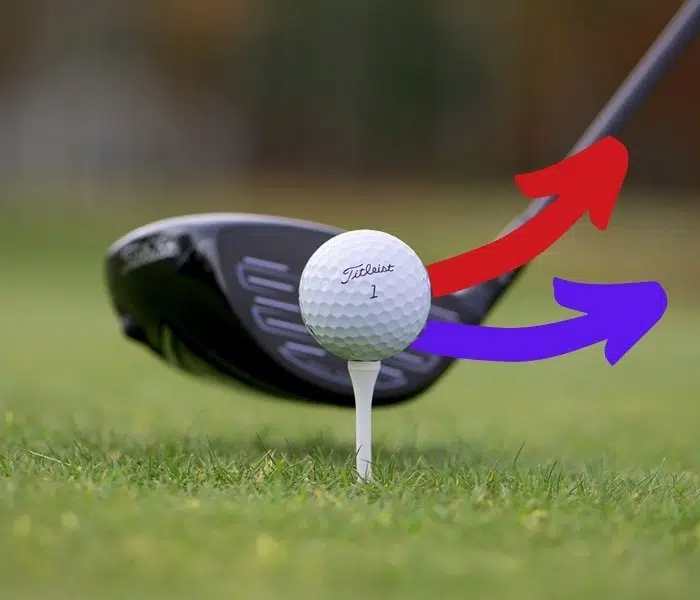
Table of contents
How do you increase your smash factor in golf?
To increase your smash factor in golf, you need to focus on clubface and path alignment; making a central strike; and mastering attack angle. Aligning clubface and path will stop you making inefficient glancing contact, with similar benefits reaped from finding the middle of the club. Optimising attack angle will impart ideal spin on the ball for maintaining speed and maximising distance.
Let’s take a look at each of these factors in greater detail below to explore why they all influence smash factor numbers.
Factor 1: Clubface and path alignment
When you strike the ball, you ideally want the club path to be on-plane and the clubface pointing straight at target.
Not only will this create a straight shot, but it will reduce sideways movement which will only decrease ball speed and hurt your smash factor.
If you are looking for speed and distance, hitting a straighter shot with little to no sideways spin will see you maintain smash factor and distance.
If you need help to determine whether you do in fact have an open or closed clubface at impact, make some slow swings with a magnetic alignment rod to get real-time feedback.
Factor 2: Central strike
It should go without saying that a central strike is key to increasing the quality and efficiency of your ball-striking, and therefore smash factor.
Shots that are struck high on the face or out of the bottom grooves aren’t going to reap the rewards of the sweet spot that will impart the maximum amount of clubhead speed and convert it into ball speed, increasing your smash factor.
Similarly, strikes out of the toe or heel aren’t going to retain the energy from your swing as well as those out of the centre, with heel strikes likely to slice and toe strikes likely to draw .
Too much shape on the ball is going to lose some of that energy from your swing, lowering your ball speed.
To determine whether you are, in fact, striking the ball out of the middle of your club, try using some impact tape on your golf clubs when at the range.
This will leave a clear and observable mark on your clubface, showing exactly where you strike the ball so that you can work on addressing any nasty habits.
Factor 3: Attack angle
If your attack angle is too steep or too shallow, you won’t impart the full force of your clubhead speed onto the ball, losing much of this energy in ball speed.
Depending on the loft of the club and the angle at which you deliver it, you’ll impart a different spin rate on the ball ; and if you fall out of an appropriate ‘window’ for the club you are using, you’ll probably see ball speed decrease.
Ideally, you want to try and optimise the attack angle and loft of the club so that they don’t stray too far apart from one another.
If you present too much loft in addition to striking the ball in too much of a downward fashion, then you will see a decrease in ball speed and smash factor along with it.
Check out a 2014 video from TrackMan below, where PGA Tour player Jason Dufner puts his swing to the test to determine his smash factor:

What contributes to smash factor in golf?
The main factors that contribute to smash factor are attack angle, strike and clubface versus path alignment. Getting all three of these things working in an optimal way will ensure you retain as much clubhead speed as possible when you strike the ball, turning it into ball speed. However, if you have a good smash factor number but don’t hit the ball very far, you may need to increase your swing speed.
It can be a frustrating thing for many golfers, but if you have an efficient, yet slow swing, you might see a solid smash factor number of 1.45 or more yet not hit the ball very far.
Ultimately, this is because – despite the fact you retain energy from your swing when you contact the ball – you don’t generate enough energy in the first place, hence need to find more by jacking up your swing speed.
One of the simplest and most popular methods to do so – it is used by hundreds of pros – is the Super Speed Golf Training System.
This product comes with three differently weighted headless clubs, both heavier and lighter than your usual clubs.
By following their training system of making swings on both dominant and non-dominant sides, you should find swinging your regular clubs faster a lot easier, generating more clubhead speed.
If you are able to pair this with a good path and efficient contact, you should be able to keep smash factor high, gaining greater distance as a result.
Is 1.3 smash factor good in golf?
A smash factor of 1.3 would be considered good for an amateur’s 6-iron, but not so good with driver. According to TrackMan, the average golfer who plays off a 14.5 handicap achieves a smash factor of 1.44 with their driver, so anything less than this could be considered below average. However, for a 6-iron, the pros achieve around 1.38 smash factor, so a bit above 1.3 would be a good target for amateurs.
As I have discussed earlier, smash factor can be a little deceiving, as it is more so a measure of efficiency than raw power and speed.
PGA tour pros achieve a smash factor of about 1.49 with their driver, exactly the same as a scratch level amateur.
However, tour players are likely striking the ball with a greater clubhead speed, rendering this smash factor far more impressive and likely hitting it longer, too.
Even 10 handicappers on average hit 1.44 smash factor, a mere 0.04 less than a PGA Tour player.
This is why it is important to look at all three factors as a package – clubhead speed, ball speed and smash factor – to work out where the strengths in your game lie and the areas you should single out for improvement.
What is the highest possible smash factor in golf?
The maximum achievable smash factor sits at around 1.5, curtailed by equipment design and general laws of physics. Some elite golfers are able to sneak above 1.5 ever so slightly, but this is quite rare. In theory, one could achieve a higher smash factor, but in practice, it is very unlikely average golfers would be able to achieve a smash factor above 1.5.
Ultimately, there’s a reason why 1.5 is considered the holy grail in terms of smash factor numbers, as it really signifies that we have gotten the most out of our swing and clubs.
If your driver reaches a smash factor of 1.5, you are essentially matching it with the pros (albeit perhaps not with clubhead speed and ball speed).
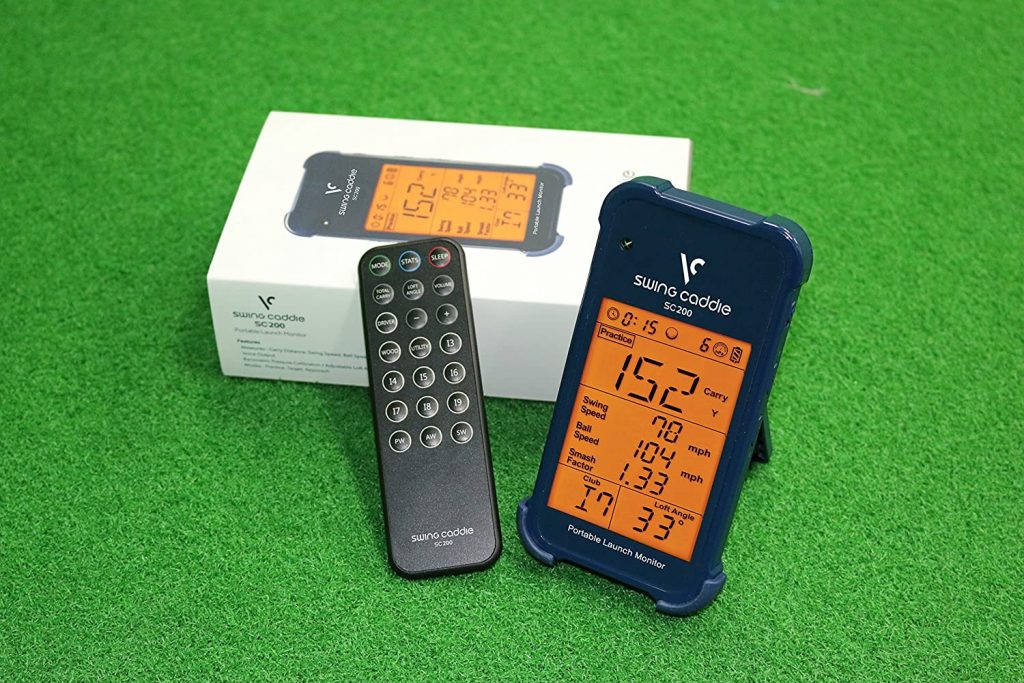
What is a good smash factor for a 6-iron?
A good smash factor for a 6-iron is in the 1.35-1.39 range, as this would place you in a similar range to PGA and LPGA tour players. On average, male tour players achieve a smash factor of 1.38 with their 6-iron, and female tour players 1.39. While you may not be able to replicate these exact numbers, something slightly less should be achievable for most amateurs.
As you move to higher-lofted clubs , you should see a gradual decrease in smash factor, given the purpose of the club changes from power and distance to finesse and accuracy.
By the time you reach pitching wedge , a good smash factor figure reduces to about 1.25.
Essentially, smash factor is a measure of how much clubhead speed is translated into ball speed, and friction on the clubface is a key reason why this figure might fall.
With your wedges, you are trying to increase the amount of time the ball spends on the clubface to impart spin , so this undoubtedly is going to see a drop in smash factor due to friction.
Can smash factor be too high in golf?
Yes, it is possible for smash factor to be too high, especially when using clubs of higher lofts. With your driver, you should be aiming for a smash factor of up to 1.5, whereas a pitching wedge will see better results at a smash factor number of 1.25. This is because, as you move into higher-lofted clubs, the onus is less on power transfer and distance, and more so on spin and accuracy.
Launch monitors are the only real way to fine tune your smash factor numbers, and for a long time they have been well and truly outside of the price range of the common golfer.
In recent years, a large number of simpler, cost efficient options have entered the market, such as the Voice Caddie SC 200 Portable Golf Launch Monitor .
A few thousand dollars can seem like an excessive purchase for most golfers, but a few hundred, especially if you love hitting the range on a weekly basis, could be a worthwhile purchase and help to transform your game.
What is the average golfer’s smash factor?
TrackMan data has shown the average golfer’s smash factor is around 1.44 with driver. This is based upon the average golfing handicap of 14.5. However, there isn’t a huge amount of difference between amateur golfers at a higher standard (single figures) and a lower standard (20+).
It is important to note that smash factor isn’t the be all and end all and is just one measure of golfing ability.
It is usually quite a good indication of strike and contact, but may not translate to distance if you don’t have a high clubhead speed.
Final message
Smash factor is just one piece of the golfing puzzle and a fairly new one at that, given it has only risen in focus and popularity with the advent of accessible launch monitors and technology.
While it is an excellent metric to determine whether you are getting the most out of your swing, purely increasing smash factor is not necessarily a recipe for more distance: you may actually need to generate more clubhead speed in the first place.
Nonetheless, if you are determined to get better, enough so that you are willing to buy a launch monitor, then smash factor is vital data worth your experimentation to create the most efficient swing you are capable of.
- Recent Posts
- Golf Club Length: Which Size is Right for Your Game? - March 13, 2024
- Protected: How Justin Rose’s Jaw-Dropping Swing and a Pilot’s Astonishing Survival Collide on a Key Largo Golf Course - March 1, 2024
- Can A Golf Ball Kill You? (+ 3 Reasons to Always Yell Fore) - February 26, 2024
ANDREW FERNANDES GOLF
- Oct 29, 2023
What Is Smash Factor? Maximizing Your Swing
Updated: Nov 2, 2023

Smash Factor is a term used to measure the efficiency of energy transfer from the clubhead to the golf ball. A high smash factor indicates that you're making the most of your swing and getting the most distance from each shot. The ideal Smash Factor is said to be around 1.5 for drivers, where a perfect energy transfer occurs. By focusing on this metric, golfers can work on their technique and make informed adjustments to enhance their overall ball-striking performance.
Key Takeaways
Smash Factor is a crucial aspect of assessing golf performance, focusing on energy transfer efficiency.
An ideal Smash Factor of 1.5 signifies perfect energy transfer between the club head and ball.
Improving Smash Factor requires attention to technique and making adjustments based on data and feedback.
Impact of Smash Factor on Golf Performance
Smash factor is a measure of how efficiently energy is transferred from the clubhead to the ball during impact. To calculate it, divide the ball speed by the clubhead speed at impact. For example, if my clubhead speed is 100 miles per hour and the ball speed is 150 miles per hour, the smash factor would be 1.5. A higher number indicates a more efficient swing.
Now that we know what it is let's dive into the effect of the smash factor on ball speed. When you maximize your smash factor, it means you're hitting the ball in the club's sweet spot. This results in an increase in ball speed, which is a significant factor in determining the distance the ball will travel. As we all know, achieving maximum distance off the tee can make a huge difference in our golf game.
In terms of efficiency, an optimal smash factor can help a golfer consistently achieve better shots with less energy. When the ball is struck with a high smash factor, the energy transfer from the clubhead to the ball is at its maximum. This allows us to generate greater ball speeds without needing to swing as hard, an especially important consideration as we play longer rounds and fatigue sets in.
Another key aspect impacted by the smash factor is the quality of impact. Hitting the sweet spot on the clubface ensures a more stable impact, reducing the likelihood of mishits, hooks, or slices. This leads to more accurate shots and tighter shot dispersion, helping build confidence in our game and, more importantly, lowering our scores.
Finally, understanding and focusing on the smash factor can encourage golfers to work on their swing mechanics. By honing our swing to maximize the smash factor, we strive for a more consistent and efficient golf swing. This, in turn, will lead to better overall golf performance and progress over time.
Key Elements Influencing the Smash Factor
The first thing that affects the smash factor is the clubhead speed. As a golfer, I can attest that faster club speeds result in higher ball speeds, but they also have a downside. When swinging faster, it becomes harder to maintain contact accuracy between the clubface and the ball, leading to a lower smash factor. To efficiently manage my club speed, I focus on maintaining an optimal balance between speed and contact accuracy.
Another major factor is the quality of contact between the clubface and the ball. When I strike the ball with more accuracy, I notice that it directly impacts my smash factor. Hitting the ball on the sweet spot, which is the center of the clubface, can significantly improve my energy transfer. Hitting on the heel or toe of the clubface, however, results in lower smash factors.
Various characteristics of clubs, such as driver, irons, and club head design, also play a role in golfers' smash factors. When selecting clubs, I consider factors like loft, angle of attack, and dynamic loft. Additionally, the type of shaft can influence club head speed, so it's important to carefully choose the right equipment to optimize ball speed and smash factor.
Swing path and attack angle are other essential elements that determine an effective golf shot. While mastering these aspects can be challenging, maintaining a consistent swing path and refining my attack angle has given me better ball launch angles, ultimately contributing to a higher smash factor.
Reading Smash Factor with Technology
I found launch monitors to be incredibly helpful in measuring and improving my Smash Factor. These amazing gadgets (like TrackMan) collect data on club speed, ball speed, and contact points, which can then be used to calculate this all-important number. For instance, TrackMan can help golfers identify and work on achieving a near-perfect Smash Factor of around 1.50 with a driver. Isn't that fascinating?
Curious about the different options out there? There's the USSGA-approved SC300, another popular choice among launch monitors. This pocket-sized device provides accurate readings and instant feedback on swing data, making it the perfect companion for your golf sessions.
As you've got an idea of the significance of Smash Factor, here's a quick look into how varying factors could impact the readings:
Club loft: Higher loft equals lower Smash Factor. For example, a driver will have a higher Smash Factor than a pitching wedge.
Clubhead mass: If the clubhead is heavier, it can result in more energy transfer and a higher Smash Factor.
How to Improve Your Smash Factor
Practicing is essential. By spending time at the range and committing to regular practice sessions, I've been able to work on my swing and get a better feel for how my club impacts the ball. Over time, this has helped me find the sweet spot more often, which has led to a higher smash factor.
Another crucial aspect is energy transfer. By focusing on my technique and body movement during the swing, I can maximize the energy transfer from my body to the club and, ultimately, to the ball. Specific drills have allowed me to hone in on this transfer, such as rotational exercises targeting my core and hips. These drills have enhanced my strength, stability, and overall balance.
I've also found that working with an instructor has been incredibly beneficial. Having someone guide me and provide feedback on my form and technique has made noticeable improvements. They've helped me identify areas to work on and have suggested useful drills to solidify my skills.
Maintaining control throughout my swing is essential. Rather than trying to generate too much power at the expense of my form, I focus on keeping a smooth, controlled motion. This approach has allowed me to make consistent contact with the ball, leading to a better energy transfer and a higher smash factor.
Frequently Asked Questions
How does the smash factor vary among different clubs.
Smash factor is the ratio of ball speed to club speed and can vary depending on the type of club being used. Generally, drivers will have a higher smash factor than irons or wedges. For instance, a well-struck driver shot can achieve a smash factor of around 1.50, while a wedge might be closer to 1.25. This variation is due to different swing speeds, loft angles, and lengths of each club. Remember, these are numbers that professional golfers would expect, and they may be different for amateurs.
What constitutes a good smash factor range?
A good smash factor range can vary depending on the specific club being used. For drivers, a great smash factor is around 1.50, but it might be more realistic for average golfers to aim for a range between 1.40 to 1.50. For irons, the range can vary significantly – a 6 iron, for example, might have a smash factor of about 1.2 to 1.4. Keep in mind that these numbers reflect ideal impacts, and achieving a high smash factor consistently can be challenging as it requires accurate and efficient energy transfer between the club and the ball.

How does the smash factor correlate with driving distance?
Smash factor represents how efficiently a golfer transfers energy from the club to the ball. A higher smash factor often correlates with greater driving distance since more of the club's kinetic energy is being converted into ball speed.
However, driving distance is also influenced by several other factors, such as launch angle, spin rate, and environmental conditions. While maximizing your smash factor can help improve your driving distance, it's important to consider and optimize these other contributing factors for a more accurate, consistent, and powerful shot.
Recent Posts
How to Clean Golf Gloves: Say Goodbye to Stained Gloves
What Is a Hybrid Golf Club and Why Every Golfer Needs One
What Is Skins in Golf? A Beginner's Guide

- Launch Monitors
- Golf Impact Screens
- Golf Hitting Mats
- Golf Simulator Software
- Launch Monitor Data
- Your Swing Studio
- Buying an Impact Screen – 11 Step Checklist for 2024
- Recommended Golf Mats – 10 Step Buying Guide
- Best Golf Simulator Projector 2023 – 8 Step Buying Guide + Setup Examples
- How to Build a DIY Golf Simulator Enclosure
- Skytrak Resources
- Uneekor Resources – QED + EYE XO
- System Requirements + Computers Reference Guide
- Launch Monitor & Golf Simulation Software – Compatibility Guide
- Curved Impact Screens
- Special Offers
- About MyGolfSimulator
- About Alex White
- Acceptable Use Policy
- Cookie Policy
- Privacy Policy
What is Smash Factor? – Launch Monitor Data 101
Posted in Launch Monitor Data
Smash factor is one of the data parameters given by a launch monitor. It is calculated from ball speed and clubhead speed and is available on a wide range of launch monitors. Smash factor is also known as Power Transfer Index.
Smash factor is the ratio of ball speed to clubhead speed in golf. The higher the smash factor, the better transfer of energy from club to ball. Smash factor is calculated by dividing ball speed by clubhead speed. It is determined by the clubface, your swing, and the golf ball.
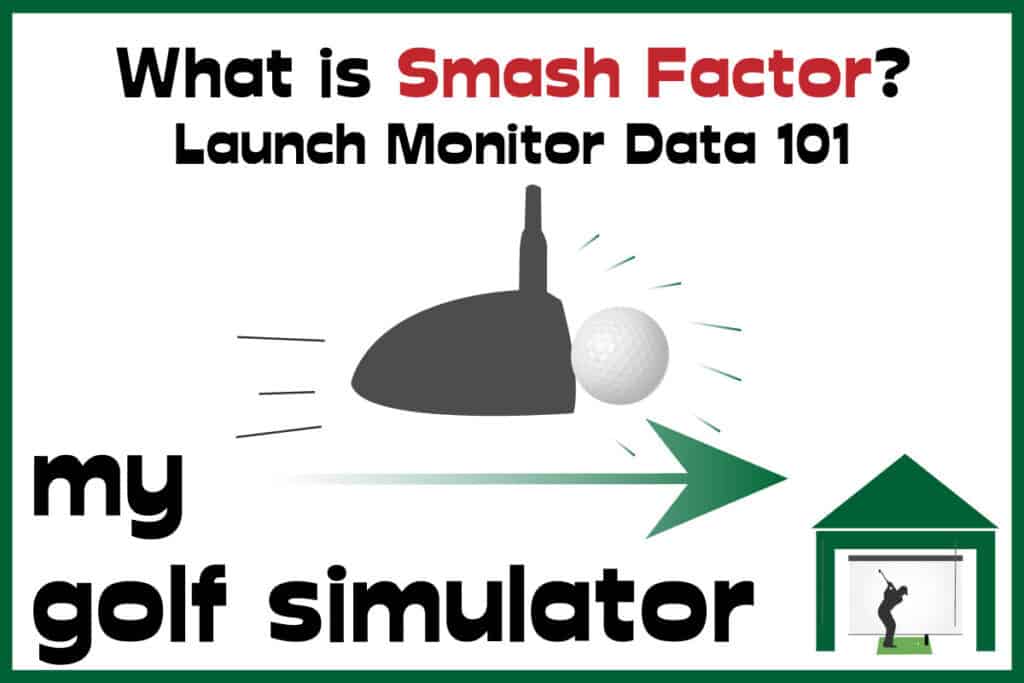
What does Smash Factor tell you?
Smash factor tells you how efficient your ball striking is. You get a measure of how efficiently you are imparting energy to the ball. Are you wasting any energy or are you maximizing your clubhead speed?
An example of Smash Factor
Say a golfer hits a driver and has a club head speed of 100mph and a ball speed of 140mph.
You can calculate smash factor like this:
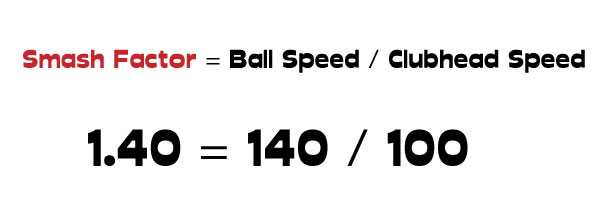
Does Higher Smash Factor Always Equal More Distance?
A higher smash factor for a given clubhead speed will equal more distance, providing all other variables are the same.
Say you absolutely nail the centre of the clubface but your swing path is a little off. Your smash factor could be higher but you have a suboptimal launch angle, or spin rate, causing a good initial ball speed but a quick drop off as the ball loses energy from moving sideways or upwards instead of forwards.
Smash factor can be a telling sign that you’re swinging too fast or at least not swinging very well. If you’re in the pursuit of extra distance then you can look at smash factor as a sign that you’re controlling your clubhead in such a way that you’re efficiently using the extra speed. If your smash factor numbers start to decrease then you need to work on your swing plane and balance more before increasing speed.
What is a Good Smash Factor for a Driver?
1.50 is often talked about at the number to aim for with smash factor. This is towards the maximum number achievable with a driver. There have been higher smash factor numbers recorded in the past but at 1.50 you’re transferring as much energy to the ball as the equipment will allow.
If there were no limits in equipment (for example ‘COR’ of a driver clubface) then theoretically higher smash factor scores would be possible. See below for more on this point.
What is a Good Smash Factor for a 6 Iron?
With a 6 iron, a smash factor of more than 1.30 would be a good result. According to the Trackman blog, the PGA Tour average for smash factor with mid irons like 6 iron is 1.38.
The trajectory of the flight of the ball matters a lot. The higher loft you put on the ball, the less efficient (in terms of speed and distance) the transfer of energy will be. However the optimum energy transfer and hence smash factor is achieved in a sweet spot of launch angles. Too low a launch and you’re sacrificing efficiency too.
How do you Increase your Smash Factor in Golf?
To increase your smash factor you need to hit the golf ball in the centre of the club face. To maximise the smash factor and hence energy transfer to the ball you also need to hit the ball without a glancing blow. You need a club path which is nice and neutral, both horizontally and vertically, not hitting down or up on the ball too much.
The main thing is a centred strike on the club face, as this video from the Trackman Youtube Channel explains. Using foot spray on the golf club can help you understand whee you hit the ball on the face. Premium launch monitors can help you learn about this visually too.
PGA Tour Smash Factor Examples
Take a look at the PGATOUR stats website . They list the Smash factor numbers for all the players in each and every tournament. All the smash factor numbers are great, I guess they all strike the ball beautifully!
Is there a Max Smash Factor?
Can smash factor be too high.
Smash factor can’t be ‘too high’ unless you’re getting inaccurate results from your equipment. You want as efficient a transfer of energy to the club as you can get. However golf is a game of consistency and as you improve you need to know exactly how far you hit the ball. Many golfers would sacrifice distance with their irons to ensure they always hit each iron a predictable distance.
What is the maximum allowed smash factor?
There is no official maximum smash factor in golf. However, indirectly, maximum smash factor numbers are determined by some of the limits imposed by golf’s governing bodies onto the equipment we use.
As we said at the beginning of this article, smash factor is determined by the clubface, your swing and the ball.
Smash Factor vs Coefficient of Restitution
The golf club face is limited by the rules of the game. There is a maximum level set at which the golf club can transfer energy to the ball. This sound a lot like a maximum smash factor number, however it is actually a maximum limit of a property called the Co-efficient of Restitution.
Co-efficient of Restitution is the ratio of the final velocity and the initial velocity of two objects after a collision. It is a measure of how much energy is lost during a collision of two independent objects, in this case the clubhead and the golf ball. The Co-efficient of Restitution is measured between 0.0 and 1.0 with a ratio of 1.0 being impossible as no collision will be so perfect that no energy is lost.
The difference between smash factor and Co-efficient of Restitution is that smash factor is strictly a ratio of post-impact ball speed and pre-impact club speed. Co-efficient of Restitution is a measurement of the change in velocities of the two objects.
They’re very similar, but Co-efficient of Restitution is a bit more scientific!
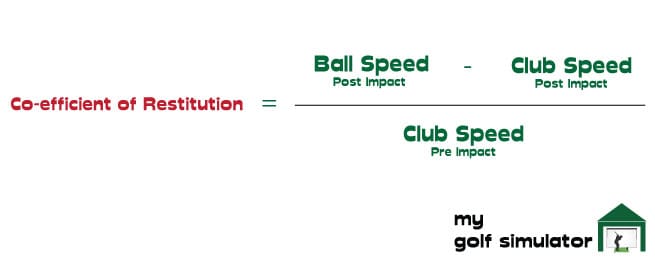
Co-efficient of Restitution is very hard to measure in practice though, so golf’s governing bodies introduced a property called Characteristic Time. Yet another measurement to get your head around. Characteristic time is a measurement of how long the ball is in contact with the clubface. The current limit is 239 microseconds (actually upto 257 microseconds with the error margin added).
Smash Factor and Spin Loft
Spin loft is another launch monitor parameter you’ll want to optimise, in order to maximise distance with driver or consistency with lofted clubs.
Spin loft is the approximate difference between the angle of attack of the club and the dynamic loft of the club face. The spin loft directly affects how much spin is imparted and how quickly the ball comes off the club. This means it has a clear effect on smash factor.
Spin loft is technically a 3D measurement as it is affected by the direction the loft is pointing in too.
Check our this excellent video from the GolfTec Youtube Channel.
Effects of Higher Spin Lofts
Increasing your spin loft will mean:
- The ball will leave the clubface with less speed, reducing smash factor (the efficiency of transfer of energy from club to ball) and the distance travelled
- Increased ball spin
Effects of Lower Spin lofts
Decreasing your spin loft will mean:
- The ball wil leave the clubface with more speed, increasing smash factor (the efficiency of transfer of energy from club to ball) and the distance travelled.
- Decreased ball spin
Using Spin Loft to your Advantage
You can generate maximum ball spin with a faster swing speed and a high spin loft. More of your effort will be transferred to spinning the ball rather than raw distance.
You can maximise distance by having a faster swing speed and a lower spin loft. More the energy you impart to the ball will be transferred to moving the ball forwards, rather than spinning it.
This is why you don’t achieve the same smash factor numbers with lofted clubs compared with your driver.
Does the golf shaft affect the Smash Factor
Smash factor can be used as a custom fitting tool to show that a certain shaft and clubhead combination works well for a golfer. If that golfer is achieving excellent smash factor numbers, along with optimum other numbers like distance, spin rates (and spin loft) and dispersion, then this is a good sign for that club.
He or she will then be getting the maximum distance possible out of that club for a given swing speed.
Pretty much every golfer wll be able to find the sweet spot more often with a shorter driver however. Whilst techinically a longer driver will be able to achieve a higher clubhead speed, the golfer will find it more difficult to hit the centre of the clubface with a longer shaft.
This means your club speed will be higher but your your strike likely off centre and your smash factor lower. Hence it’s difficult to achieve a higher ball speed consistently with a longer shaft. Shorter shafts sometimes equal more distance for this reason.
Getting fitted for the correct shaft is important too. Optimising the stiffness and kick point of the shaft will allow you to get the angle of attack, dynamic loft and club path just right. If you can maximise your smash factor and optimise your spin loft, face angle and club path, you’re winning!
Does Smash Factor matter for all clubs?
You won’t achieve the same smash factor with a wedge or 9 iron as you do with your driver. Higher lofted clubs impart much more spin onto the ball than a long club does. The impact with the club is not therefore optimised solely for distance.
Therefore, I don’t believe it’s wise to place too much stock in smash factor on your wedges and lofted irons. You can get a gauge on the efficiency of your strike on mid irons and above using smash factor, but I’d worry far more about your strike and achieving a consistent distance with your wedges.
If you really want to get into it, there’s been some work done that shows that achieving a smash factor of 1.0 can maximise the spin achieved in wedge shots. You can learn more about this here .
Optimising smash factor and the spin loft of the wedge shot can ensure consistent strikes and distance for advanced players.
Which Launch Monitors feature Smash Factor?
Most premium launch monitors read out smash factor.
Any premium launch monitor that measures clubhead speed and ball speed will then read out the ratio of these numbers as smash factor. It’s one of the measurements you should expect from your equipment. Some launch monitors will show it front and centre on the display, and some might feature it less prominently in their data tables for each shot.
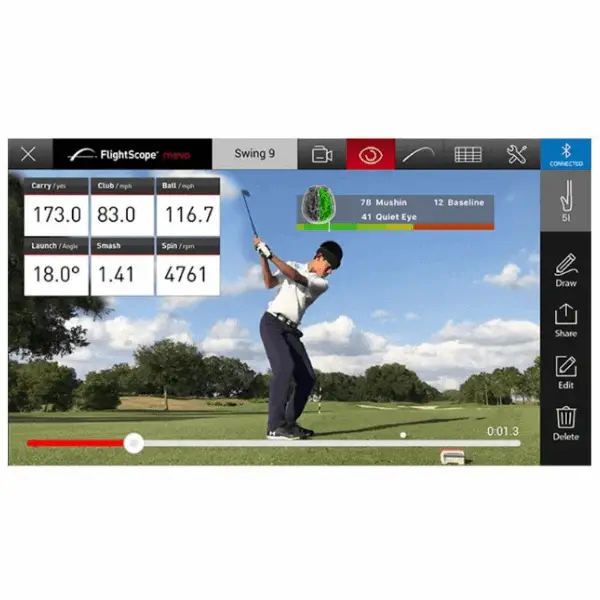
I will shortly be publishing a resource which will let you quickly check all launch monitors available on the market to see which data parameters are available.
Smash Factor and Portable launch monitors for the driving range
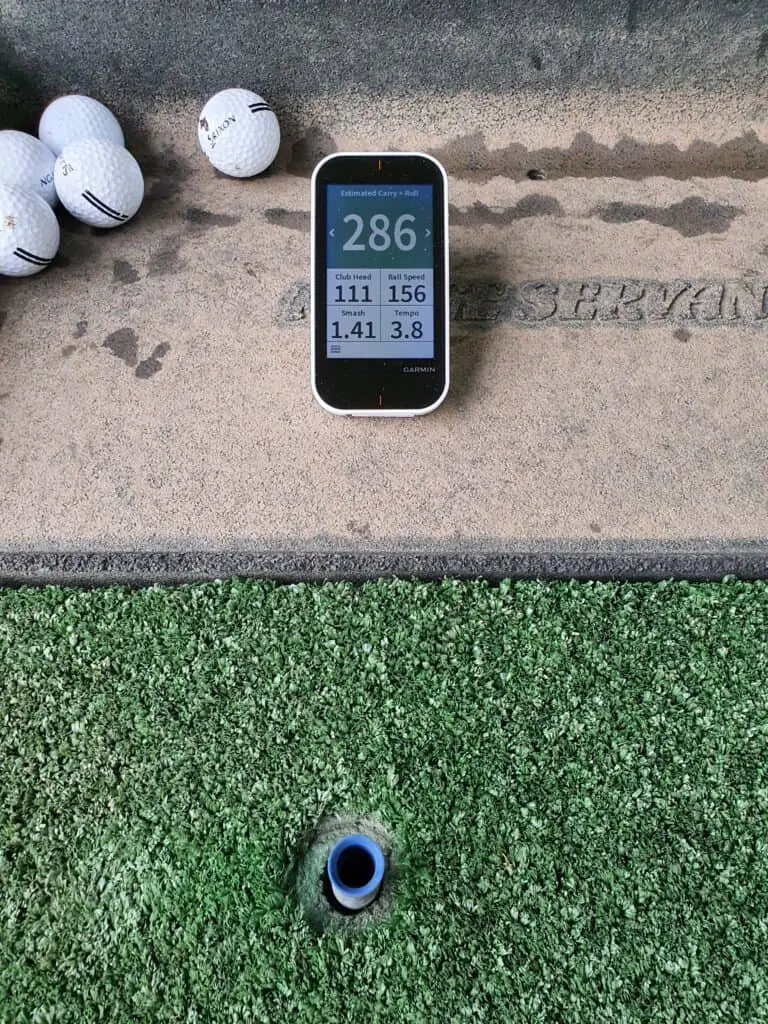
The above picture is my Garmin G80 at the driving range – I have room to improve my smash factor!
Smash factor is included on many cheaper portable launch monitors that are fantastic tools at the driving range. I’m seeing more and more golfers taking tools like this, as well as swing cameras to the range. They can really enhance your practice session, allowing you to work on specific achievable goals and drills.
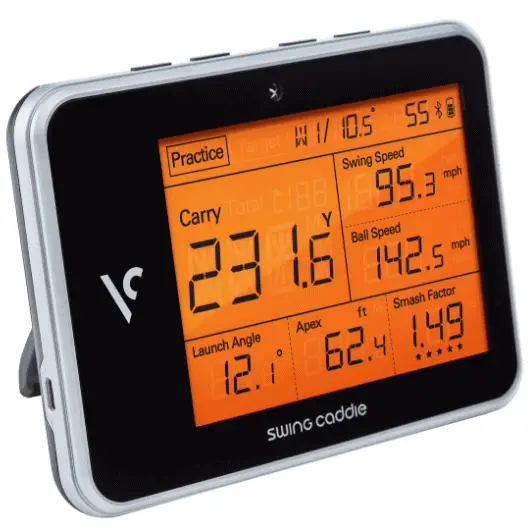
Conclusion – Why should you care about Smash Factor?
Smash factor is an easily measured and relatively easy to understand parameter given by the majority of launch monitors. It can tell you whether you’re getting the most out of your swing speed or wasting distance with poor ball strikes.
Smash factor can be the key to finding lots of extra yards of distance, without doing a Bryson Deschambeau and putting on 40lbs of muscle! If you’re an elite player it’s another method of honing your wedge game too.
Check out our similar articles

Alex @ mygolfsimulator

HackMotion in a Golf Simulator: All the Data you need!

Hackmotion Packages – Core, Plus, and Pro Compared
About the author.
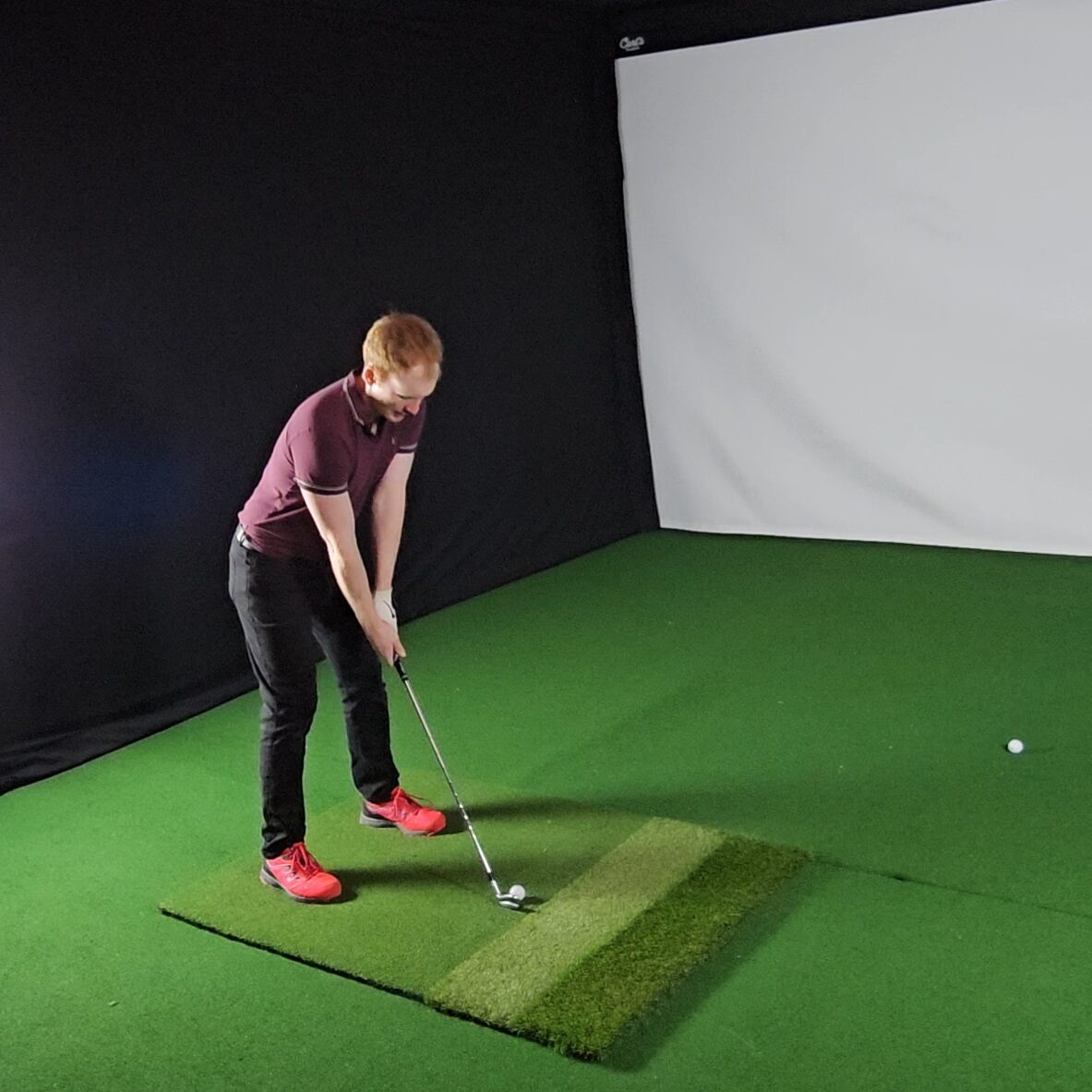
Hello! My name is Alex and it is my mission to bring you all the information you need to build your own home golf simulator! I hope mygolfsimulator.com helps you on your journey to better golf at home!
LEGAL INFORMATION
On this site, you'll find articles on all aspects of building a golf simulator. I will also link to other sites where you can buy some of the simulator components. Some of these links may be affiliate links, which means if you click them I gain a small commission at no extra cost to you. This really helps out me and my site so thank you in advance! mygolfsimulator.com and all related social media accounts are property of Awonline LTD.
Wells Fargo Championship
Quail Hollow Club
New Data Shows We're Not Hitting It Farther

J.R. Eyerman/The LIFE Picture Collection/Getty Images
The so-called "distance explosion" that has the USGA in a tizzy? Yeah, that might be happening on tour, but it ain't happening to you. New data on average golfers, including more than 10 million drives gathered by Arccos, the GPS-based stat-tracking app , paints a slightly stagnant picture about driving distance for the paying public. Even though golf's ruling bodies are alarmed by the 2.5-yard increase in average driving distance this past year on the PGA Tour, some amateur-golfer distance numbers haven't moved that much in two decades, and many are hitting it shorter than they used to. Here's our exclusive report on what the numbers say everyday golfers are doing wrong and why—and, frankly, what can be done about it. Of course, the stats are a little discouraging, but the prospects are game-changing. It just takes the right technology and understanding.
AVERAGE GOLFERS MIGHT BE GETTING SHORTER Distance is down the past four years, according to Arccos research. Looking at full-year data only, it's down 0.6 yards from 2015-'17. If you include 2018, distance has dropped to 217.1 yards, 3.5 yards less than in 2015. One bright spot: Better players (0-5-handicap) saw a 2.4-yard gain from 2015-'18. All other handicap groups lost five to seven yards.
GOOD PLAYERS HIT IT FARTHER ... DUH The best everyday players hit it longer than the worst. In the Arccos study, 0-5-handicaps average 239 yards, and high-handicappers average 201. The math suggests high-handicappers should play from tees at least 500 yards shorter than the tees played by low-handicappers.
EXPERIENCE IS GOOD, JUST NOT FOR DISTANCE Average golfers lose yardage faster the older they get. By Arccos tracking, players in their 70s are 46 yards shorter than those in their 20s. That data suggests we lose an average of seven yards per decade from our 20s to our 50s but twice that much per decade from our 50s to our 70s. Still, that trend is changing if you look at PGA Tour Champions data. Hale Irwin hits it farther today (253.6) at age 72 than he did in 1980, when he was 35 (250.2).
SPEED KEYS DISTANCE (BALL SPEED, THAT IS) The average male amateur's swing speed is 93.4 miles per hour, according to research by TrackMan, for an average distance of 214 yards. Using TrackMan's "optimal" distance, the average golfer's potential is 255 yards at that same swing speed. How? By hitting the ball more solidly, or what's known as upping your "smash factor." Smash factor is the ratio between the speed of the ball as it leaves the clubface and your swing speed. Generally, 1.5 is an ideal smash factor, but the average golfer's smash factor is only about 1.42, TrackMan says. If an average golfer could achieve a smash factor of 1.5 (by solid, center hits), that would increase ball speed by 8 miles per hour and reduce spin by about 30 percent. Add a higher launch angle (at least 2 degrees by making contact on the upswing), and TrackMan says the average golfer could add 41 yards to his or her drive.
YOU NEED TO HIT IT MORE LIKE AN LPGA PLAYER Everybody knows average male golfers aren't as skilled as PGA Tour pros, but when it comes to driving efficiency, PGA Tour pros are worse than LPGA Tour players. Because PGA Tour players typically hit the center of the face, they average 2.58 yards per mph of swing speed, according to TrackMan. Everyday golfers average only 2.29, according to research by Jaacob Bowden at Swing Man Golf. If they improved to just 2.40, average golfers' drives would increase by 10 yards. Bowden says LPGA Tour players swing at roughly the same speed as average male golfers (93.9 mph), but because they are even more efficient at center strikes than PGA Tour players, they average 2.64 yards per mph for an average of 248 yards off the tee. That's more than 30 yards longer than everyday male golfers.
SWING SLOWER, HIT IT LONGER Swing speed isn't everything, especially for average golfers. You can swing slightly slower—but much more efficiently—and you'll be in a new distance zip code. Data gathered by Foresight Sports simulation software found that swinging 2-mph slower can still lead to 20 more yards, provided that you reduce ball spin, increase your launch angle and hit the ball more squarely in the center of the face.
USGA AMATEUR DISTANCE STUDY: SLOW GROWTH It's a limited study, but in the USGA's 2017 Distance Report, an annual test of average golfers conducted at various clubs in the United Kingdom showed that the average distance increased from 200 yards in 1996 to 208 yards in 2017. But it was down nine yards from 2005. Unlike Arccos data, in this research only the higher-handicap group (13 and over) showed significant improvement. That group saw an average driving distance increase of about 17 yards. Meanwhile, in the same study, the best players gained only two yards in the past two decades. A small, somewhat irregular sample, but sure makes it seem like those hitting it the best aren't gaining as much as those hitting it all over the face.
YOU'RE PLAYING FROM THE WRONG TEES Driver, 7-iron makes for a solid par 4, just not the length you're thinking. Arccos research shows that the everyday golfer 7-iron distance is 145 yards. Combine that with Arccos' average golfer driver distance, and you get a 365-yard hole, or about a football field shorter than how a PGA Tour player might play those same two clubs.
GAME-CHANGERS: TECHNOLOGY AND FITTING Dozens of studies show the benefits of getting the right new equipment. Here are two: National clubfitting chain Club Champion studied average golfers who tried the latest equipment. The results: 78 percent benefited from using the latest drivers, gaining 11 yards. A Golf Digest robot test conducted by Golf Laboratories revealed that the latest models on average are six yards better (and more on off-center hits) than drivers from only four years ago.
RELATED: Are average golfers gaining distance? New study says not by a long shot
Check out Golf Digest All Access to get over 150 lessons on any of your devices, at any time.
WATCH: GOLF DIGEST VIDEOS
Sign up for Golf Digest All Access today
More from Golf Digest
Trending now.

Golf Instruction
What is smash factor and why should you care.
Even if you don’t yet know what ‘smash factor’ is in golf, it sure sounds cool. After all, who wouldn’t want to ‘smash’ the golf ball out into the distance hole after hole?
There are plenty of things that matter in golf other than distance, but hitting the ball a long way is a valuable skill. By evaluating your smash factor, you might be able to get more out of your swing and tack yards onto your drives (and the rest of your shots).
In this article, we’d like to give you an overview of what smash factor is, and why it is important. Also, at the end, we’ll offer up a few simple tips for how you can work on optimizing this measure in your own game. Let’s get started!
First, a Little Bit of Math
If the idea of having to do math as part of your golf game scares you, don’t run away just yet. The math here is pretty simple, and once you understand it, you’ll be able to see where your game might be open to improvement.
There are two numbers you will need to determine your smash factor – ball speed and club head speed .
Ball speed is the speed that the ball is traveling when it leaves your club face. Club head speed, of course, is the speed that the club is moving when it strikes the ball. As the speed of the club head increases, so too should the speed of the ball as it heads off toward the target.
Smash factor is important because it measures the efficiency of the energy transfer from the club to the ball. While it’s possible to measure smash factor with any of your clubs, it’s typically used with the driver.
Improving your smash factor should lead to longer drives, even if you don’t add any speed to your swing.
Let’s do some math for a quick example. Imagine you swing your driver at 100 miles per hour, which is right in the average range for a recreational male golfer. Then, when you strike the ball, it leaves the club at a speed of 145 miles per hour. Dividing that 145 MPH speed by the club head speed of 100 gives you a smash factor of 1.45.
Ball Speed / Club Head Speed = Smash Factor
So What’s the Goal?
With a driver, the ultimate goal is to get your smash factor up near the coveted 1.50 mark. So, from our previous example, a factor of 1.45 would be pretty good, if not great. If you were only getting ball speed in the 130 range out of your 100 MPH swing, there would be cause for concern.
If you would like to test out smash factor for yourself, you can ask to have your swing analyzed on a launch monitor at your local course. Most facilities these days have a launch monitor available and will charge a modest fee for your swing and equipment to be measured. In addition to smash factor, you can learn a lot more about your game by working with launch monitor technology.
Some Potential Problems with Your Smash Factor
Should you discover that your smash factor is rather low, you’ll immediately begin to wonder what is going wrong with your swing. Unfortunately, as is often true in golf, there are a variety of issues that could be to blame. You’ll need to sort through everything in order to get down to the root of the problem.
The first place to look is the location of impact on the club face. Ideally, you will strike the ball perfectly on the sweet spot, or as close as possible.
The center of the club face is going to give you the most efficient transfer of energy , and help you avoid a low smash factor. If you tend to have your contact point drift significantly away from the center of the face, it’s likely your smash factor is going to suffer.

There are other problems in your swing that can lead to a low smash factor. It’s possible that your angle of attack is too steep, leading to impact conditions that are less than optimal. Even if you do manage to catch the center of the club face with that steep swing, you are still unlikely to get a great transfer of energy.
Also, you could have equipment problems, such as a shaft that is not a good fit for the dynamics of your swing. Working with a professional during a launch monitor session should help you figure out if equipment is to blame.
Making Adjustments to Improve Your Smash Factor
On the equipment side of things, you’ll need to work with a pro or club fitter to get your issues sorted out. However, if it is technique that seems to be to blame the tips listed below might get you back on the right track.
Focus on Balance
This is always a good place to start when trying to improve anything in your golf game. With better balance, you should be able to achieve a better strike, as well as perform more consistently. It is often the case that players who are struggling to find the center of the club face will see a great improvement simply by becoming more balanced.
Keep a Steady Head
Another important factor in clean ball striking is a stable head position. If your head is moving around actively during the swing, it’s always going to be hard to strike your shots on the sweet spot. Your head is bound to move a bit during the swing but minimize that movement to improve contact quality.
Commit to the Shot
Sometimes, poor contact quality comes down to nothing more than a lack of commitment to the shot. Before each swing, commit fully to your plan and execute to the best of your ability.
A Final Word on Smash Factor
Is optimizing your smash factor automatically going to lead to lower scores? No – not really. But improvement in golf is all about taking small steps toward the bigger goal.
Work on this point and you’ll be one step closer to the dream of shooting lower scores and having more fun on the links than ever before.
How to Get More of Your Putts Rolling On Line
QUICK TIP: Try This Drill at Home to Improve Balance and Rotation
Rory McIlroy Maintains Status As Negotiator with PIF Despite PGA TOUR Policy Board Slight
PGA National Resort Announces First Annual ‘Hole in One Challenge’
Rory McIlroy Lands on PGA TOUR Subcommittee After Board Snub
LIV Golf’s Louis Oosthuizen DECLINES PGA Championship Invitation Offer
Tiger Woods Is the Only PGA Tour Player Who Will Be Directly Negotiating With the Saudis
Bryson DeChambeau is Using Custom 3D Printed Irons at The Masters

Viktor Hovland Makes His Decision on PGA TOUR Future
PGA Tour Loyalty Payouts Revealed: Tiger Woods Stands to Make The Most
WATCH: Kevin Na Throws a Temper Tantrum at LIV Golf Adelaide

LIV Golf Sets New Record With Adelaide Event

We Played This Old Golf Course Where Thomas Edison Was A Member

Are You MEASURING Your Golf Swing Correctly? (This Can Help)

Zach Johnson Explains Why He Didn’t Pick Bryson DeChambeau for the Ryder Cup

Justin Thomas FIRES Coach before Ryder Cup…Who’s Next?

What Nobody Tells You About Great Ball Striking

Fantasy Golf Picks, Odds, and Predictions – 2024 Wells Fargo Championship
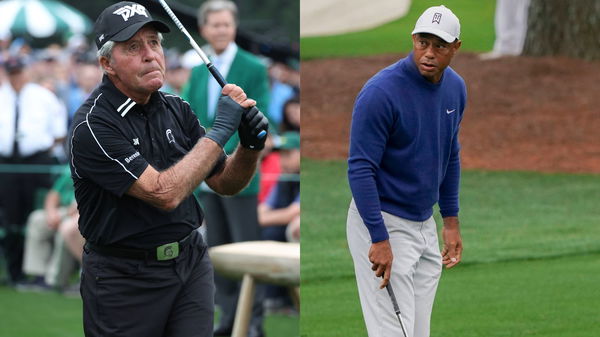
Gary Player Says Tiger Woods Won’t Go Down as The Greatest Athlete Ever Because of This Mistake
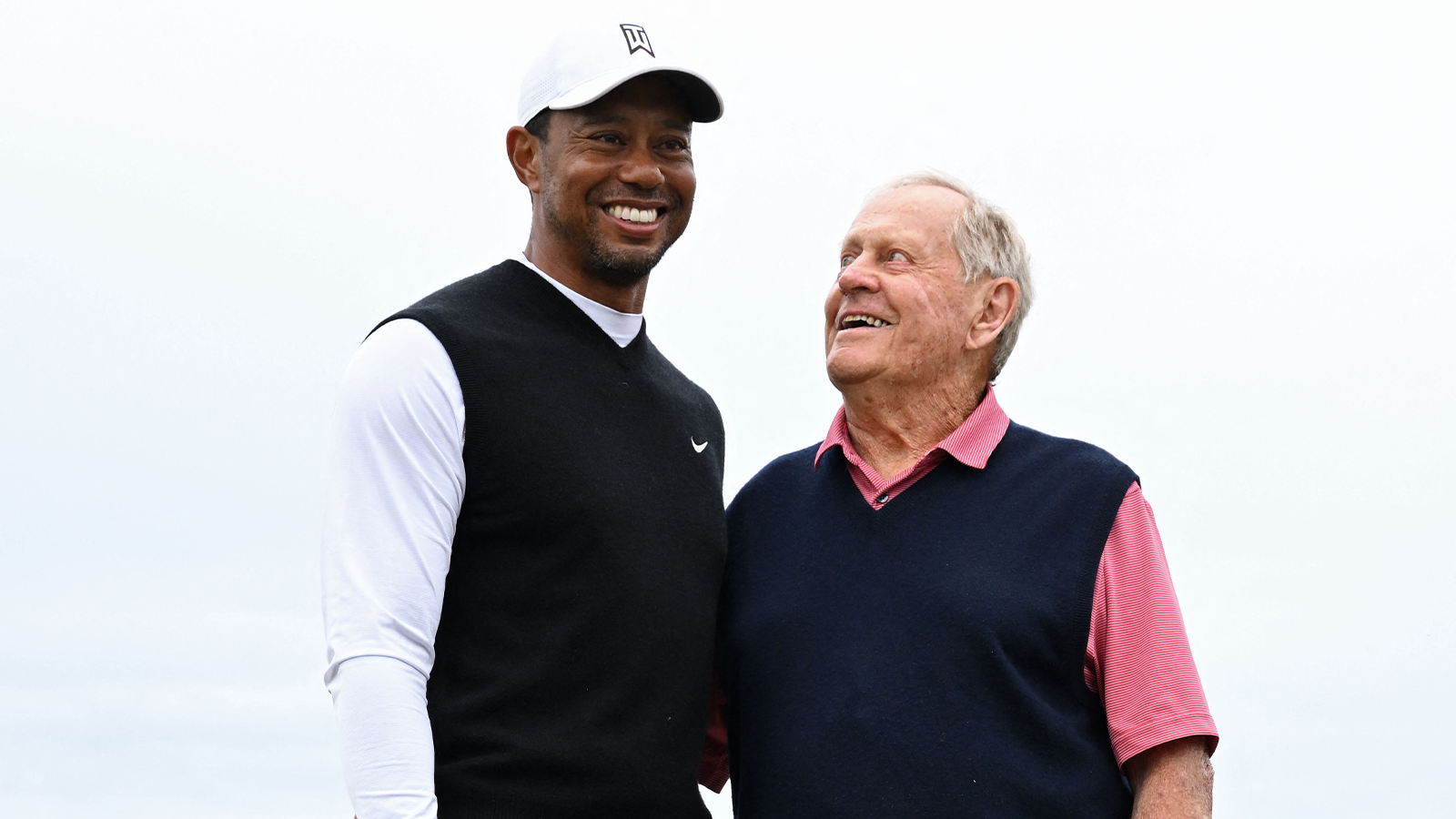
Jack Nicklaus Makes CRAZY Tiger Woods Prediction

Phil Mickelson Hints His Golf Career May Be Coming to a Close

LIV Golf Has Tiger Woods and Rory McIlroy’s Relationship on Thin Ice
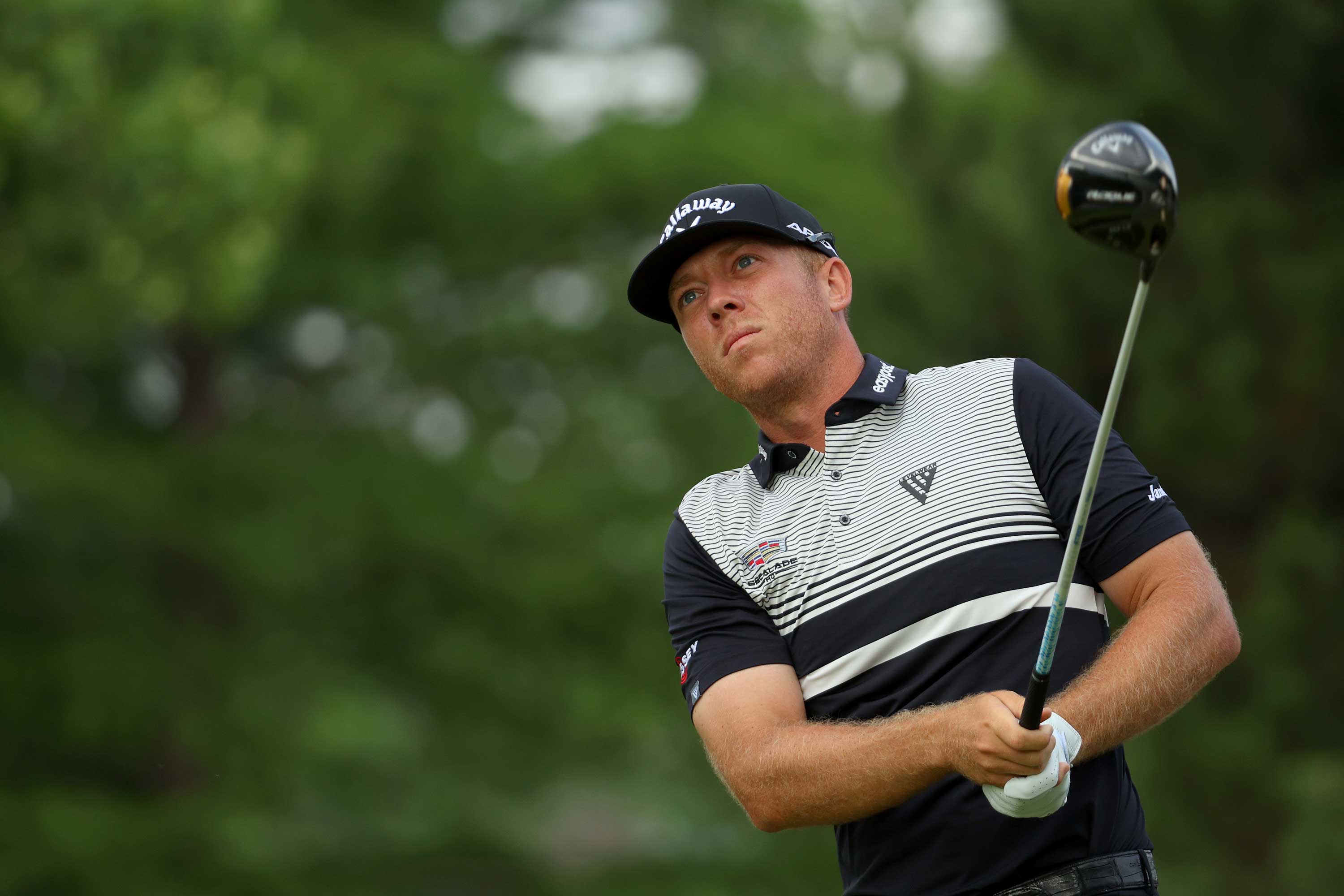
Talor Gooch, David Puig Land PGA Championship Invitations
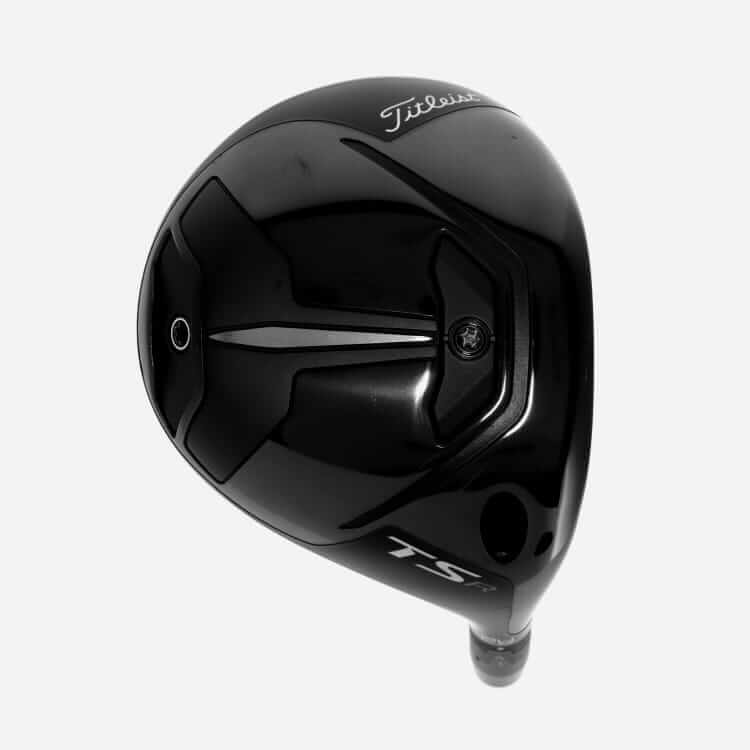
Titleist Hops On ‘Mini-Driver’ Hype with CRAZY TSR 2-Wood
/cdn.vox-cdn.com/uploads/chorus_image/image/73322952/2150492315.0.jpg)
Phil Mickelson Sends STERN Message to LIV Golf Haters: ‘F*** Around and Find Out’
What Is Smash Factor? How Can It Help My Golf Game?

Why Smash Factor is an Important Metric
Whether you are playing baseball, tennis, or golf, the velocity of the ball when hit is only maximized when it is struck on the “sweet spot” of the implement being used to hit it.
Those towering 400-foot home runs don’t occur when the baseball is hit near the handle of the bat. To optimize the baseball’s speed and distance, it must be struck squarely on the fat part of the bat. The same is true in tennis. When you see a blistering 130 MPH serve, you can be assured that the tennis ball was hit in the precise center of the racket. Contact made out toward the frame of the racket will not produce that kind of ball velocity.
So why does a purely struck baseball or tennis ball react so much better than one that is mishit? The laws of physics provide the answer. On those strikes that make contact in the “center of percussion” there is an optimal transfer of energy from the bat or the racquet to the ball.
These Laws of Physics Apply to Golf as Well
Yes, those same laws of physics obviously apply to golf also. A golf ball that strikes the sweet spot of the club will generate a better transfer of energy from club to ball than one that is hit out toward the toe or in toward the heel of the club face. To produce the best shots possible, at least as far as ball speed and distance are concerned, center-face contact is a prerequisite. The equation is pretty straightforward: better transfer of energy = greater distance.
So, it stands to reason that, in a game that is now characterized by the constant pursuit of greater distance, all golfers want to hit the ball farther, which we now know means that they will need to improve the transfer of energy that they are able to deliver to the ball.
The Launch Monitor Measures Your Efficiency
But how do you know how proficient you are at generating that transfer of energy? Fortunately, golfers have a tool at their disposal that enables them to quantify just how efficient their current swing is in producing ball speed.
Some years ago Foresight, and other makers of the now ubiquitous launch monitors, engineered into the device the capability to measure a golf swing’s transfer of energy into the ball, and they gave it a catchy title: Smash Factor. Most of the readers of this blog will already be familiar with the term, but many of you may not have a complete understanding of exactly what Smash Factor is and, more importantly, how to improve yours. This article was written to give you some additional perspective on why Smash Factor is important.
And keep in mind, Smash Factor data is just one of the many metrics captured by the Foresight family of launch monitors . In addition to Smash Factor, there is wide variety of other ball launch and club data indicators that users have access to as tools to help them improve the overall efficiency of their swing. Check out this excellent guide (“ Understanding Ball Launch and Club Data ”) that goes into great detail on all of these various metrics.
Exactly What Is This Thing Called Smash Factor?
As stated above Smash Factor is, at its essence, a measurement of efficiency. It’s a numerical representation that indicates the ratio of your ball speed to your club head speed. It tells you how much ball speed you’re achieving per 1 MPH of club head speed, which is an indication of how efficiently and precisely you’re able to transfer energy from the club to the ball with your swing.
The calculation is fairly simple: Smash Factor is derived by dividing your ball speed by your club head speed.
As a reference, the ideal Smash Factor (i.e., a shot in which there is a perfect amount of energy transfer), is 1.5. This represents the gold standard of Smash Factor measurements. This means that ideally, the speed with which the ball leaves the club face would be one and a half times the speed that the club head was moving at impact.
Let’s look at an example: Golfer A generates a ball speed of 140 MPH with a club head speed of 100 MPH. That would compute to a Smash Factor of 1.40 (140 ÷ 100). Golfer B, by comparison, generates 145 MPH of ball speed with that exact same 100 MPH club head speed and, in so doing, would have a Smash Factor of 1.45.
How can two golfers with identical swing speeds generate different ball speeds? Golfer B’s higher Smash Factor rating, despite having the same club head speed as Golfer A, indicates that his swing is more efficient in transferring energy into the ball. Put another way, Golfer A’s golf swing unfortunately exhibits more of the issues that can cause a loss of energy transfer compared to Golfer B’s swing (i.e., it’s less efficient).
Smash Factor is Just a Number, Right?
Statistics and data can be useful but, by themselves, aren’t very valuable. Raw numbers don’t tell you very much. Only by extracting meaning from that data can you derive actionable information.
That is very much the case with Smash Factor. By itself, it’s basically just a number. In the example above, it’s of no real value to Golfer A to simply know that his Smash Factor is 1.40, or for Golfer B to know that his Smash Factor is 1.45. But in the hands of a skilled instructor, someone able to take that number and translate it into an improvement plan for the golfer, Smash Factor becomes an invaluable piece of data.
For Golfer A to increase his Smash Factor rating, and therefore his distance, he will need to understand what factors are causing him to lose efficiency in his swing, and to then correct those issues. This process is what transforms that raw data (the Smash Factor number) into a meaningful and valuable piece of information .
What Issues Affect the Smash Factor Rating?
There are several issues that can affect a player’s Smash Factor. Knowing what they are, and understanding how they affect your swing’s efficiency, is the first step in your plan to increase your Smash Factor number.
Centeredness of contact
As stated above, whether it’s hitting a baseball or a tennis ball, and most definitely when you’re hitting a golf ball, finding the sweet spot (the center of percussion, in scientific terms) is a prime determinant in maximizing ball speed. Mishits that don’t find the center of the club face will result in a reduction in the transfer of energy into the ball, which obviously means that they won’t go as far.
The GCQuad will tell you where on the club face you made contact. Working with an instructor to increase your frequency of center-face strikes (which could possibly require changes to your stance or posture, or changes to your swing path, or changes to your attack angle, etc.) is probably the best way to increase your Smash Factor.
Club head speed
It should be self-evident by now that your club head speed is a key factor in creating ball speed. Clearly a 120 MPH swing will generate a lot more ball speed than a 100 MPH swing. And, in fact, the very calculation of the Smash Factor rating utilizes club head speed as one of the components in the equation.
Increasing your club head speed, then, whether that comes from improvements in your technique or from switching to clubs, or club settings, that are a better fit for your particular swing profile, can translate directly to an increase in your Smash Factor.
For those who would like to learn more about how to increase your club head speed and to understand what the factors are that are potentially costing you distance, check out this article here .
Angle of Attack
The angle at which your club head approaches the ball can have a big effect on the efficiency of the strike. Most of our readers understand that, when hitting your driver, the attack angle should ideally approach the ball slightly on the upswing. A too-steep attack angle with the driver will generate too much backspin, which in turn reduces the optimal energy transfer and detracts from overall distance. With the irons, on the other hand, the angle of attack usually needs to be more acute (descending).
The GCQuad indicates your precise angle of attack on each swing. Get this right, and you will likely see an increase in your Smash Factor .
Face angle at impact
Ideally, golfers want their club face to approach the ball so that it is square to their swing path (assuming that they are not trying to intentionally hit a fade or a draw). Striking the ball with a clubface that is open relative to your path will produce excessive slice sidespin. Conversely, a face that is closed to the path at impact imparts hook sidespin. In both cases, the creation of sidespin results in a less efficient transfer of energy into the ball, the consequence of which will be a reduction in your Smash Factor number.
Foresight’s GCQuad launch monitor will identify the orientation of your club face at impact, revealing whether it was open or closed, and by how much. This “face to path” metric will be a vital tool when attempting to correct those types of face angle issues.
As all golfers can attest, the swing is a very complicated action, requiring the coordinated sequence of many different movements. Consequently, there are numerous points throughout that progression where potential swing flaws can inhibit you from maximizing your efficiency. The issues mentioned above are just some of the more prevalent factors that can negatively impact one’s Smash Factor. When time and space allow, perhaps we’ll delve more deeply into some of the other, more nuanced issues that are relevant to Smash Factor optimization (e.g., dynamic loft, ball compression, etc.).
Final Thoughts
We all want to hit the ball farther. The quest for more distance is universal in golfers everywhere. To increase your distance, though, you need to improve the efficiency of your golf swing. Doing so will enable you to optimize how well you transfer energy from the club to the ball.
Smash Factor, as one of the key metrics reported by the GCQuad, helps us to understand if we have efficiency gaps that need to be improved. A low Smash Factor (relative to other golfers) provides you with confirmation that corrections are needed in one or more of the swing issues itemized above.
This is why Smash Factor is an important metric. The numerical rating is interesting, but of limited value until you combine it with an improvement plan aimed at increasing it. When you see your Smash Factor number go up, you’ll know that you’ve made key strides in creating a more efficient golf swing.
Recent Articles
You have no items in your bag
Shipping & taxes calculated at checkout.

What is Smash Factor?
Learn how to increase distance with the driver by improving solidity of contact.
TrackMan’s 10 Fundamentals were originally released as part of a 2010 newsletter. This video looks at the second fundamental, smash factor .
Leave a Reply Cancel reply
- Coach Of The Month
Subscribe and get the latest Insights!
Recent comments.
- Keith Rogers on Paul McGinley – How To Practice
- Anthony on 6 TrackMan numbers all amateur golfers should know
- BillM on TRACKMAN HANDICAP
- Tim Work on How To Work On Attack Angle
- WAYNE B EISMAN on 6 TrackMan numbers all amateur golfers should know
Stay updated
Stay up to date and receive free notifications of new posts by email.
Email Address
Subscribe - It's Free!
- Coach of the month

- Remember me Not recommended on shared computers
Forgot your password?
- Instruction & Academy
Help understanding Trackman smash factor

By pitchinwedge June 20, 2013 in Instruction & Academy
- Reply to this topic
- Start new topic
Recommended Posts
Pitchinwedge.
Looking for some possible explanations. I got fit outdoors on a Track-man that resulted in unbelievable smash factor numbers with drivers and woods.
The fitting session started with my own fairway woods, which produced smash of 1.42-1.45, which I found to be entirely credible:
SS = 89 mph
BS = 128 mph
Then, the fitter handed me Callaway, Ping, and TM fairways to try. These clubs had a variety of custom shafts, but they all resulted in smash factor measurements greater than 1.50, and consistently between 1.51-1.53:
BS = 136 ?!
Needless to say, I left scratching my head. The next day, I go to my local golf store, which is equipped with Flightscope and try out the same model Callaway and Ping clubs, off the rack. Guess what... smash factor 1.45
I thought maybe I was hitting the ball in a manner which skewed the Track-man results. I believe I read somewhere that smash factor measured on off-the-toe hits can result in higher smash numbers because of the way Track-man calculates smash factor, but I don't think it's a good explanation. I wasn't hitting off the toe, the results were too consistent, and the measurements of my own club provide a solid baseline for comparison. So what's really going on here? Is it really the custom shafts? How can the shafts affect smash factor? Where the heads of the fitter's clubs just abnormally "hot"?
I'm going to ask the fitter for his explanation, but I'd love to hear what WRX'ers think.
917 D2 8.50* - Tensei CK Pro White 60 917 F2 13.5* - Rogue Max 70 816 H2 19.0* - D+ Plus 90 716 T-MB (3i, 4i) - Modus 120 716 CB (5-PW) - Modus 120 Hogan TK15 - 49, 55 Edel Deschutes [url="http://www.golfwrx.com/forums/topic/1457364-pitchinwedges-witb/page__p__15152218#entry15152218"][color=#0000ff][b]Photo WITB[/b][/color][/url]
Link to comment
Share on other sites.
- Created 10 yr
- Last Reply 3 yr
Top Posters In This Topic
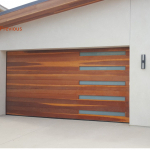
Popular Days
pitchinwedge 9 posts
PutterKilledTheDream 6 posts
ultra45 2 posts
iteachgolf 2 posts
Jun 20 2013
Jun 21 2013
Jun 22 2013

Here is an old post: http://www.golfwrx.com/forums/topic/205973-smash-factor/
Here is an old post: http://www.golfwrx.c...3-smash-factor/
Yes, that was the same article I referred to in my original post:
TrackMan™ always refers to the club head speed at the center of the club face, but because of around a ⅜ inch uncertainty of the location of the radar reflection point on the back of the club face, this leads to an accuracy of the club head speed measurement of the TrackMan™ of ±1 mph with reference to the center of the club face.
I am ruling this out as the explanation because 1) I was not consistently hitting it off the toe as in example 2 above; and 2) my own fairway woods during the same session resulted the typical smash of 1.45
Any other ideas?

I had nearly the same experience on flight scope. 1.48 to 1.51 with my Ping k15 10.5* @ 92 mph. My swing speed was low that day but I know I play a course with a bunker measured at 230 yds by gps that I can carry when I am playing well. My launch was 12.7* at just a shade under 2800 rpm and + 1.8 AoA.
Callaway Epic MAX 10.5* Callaway Mavrik MAX 15* Taylor Made M4 19* & 22* hybrids PING G410 5-U w/DG 105s Cleveland RTX 54* & 58* Odyssey Stroke Lab Big Seven Toe Up vs MEZZ1 vs Seemore Precision Pro Nx7 Pro, Garmin S60 (watch)
https://forums.golfwrx.com/discussion/1580770/recaps-the-taylormade-twistfaceexperience-7-golfwrx-members-visit-the-kingdom-for-an-exclusive-m3/p1
Yeah, being skeptical at best I'm leaning towards one of the two explanations: 1. The test clubs having hotter than off-the-rack faces 2. Trackman was rigged Or maybe somebody has another reasonable explanation of why the same makes and models of golf clubs should produce significantly different smash factors?
Mine was with my club and not with someone trying to sell me a driver. I've known him for almost 20 yrs.

I would rule out a clubhead speed issue, since it was very similar with all clubs and monitors. ball speed seems weird, if its showing an unusual PTR, and its way higher than what you actually get.
PutterKilledTheDream
[quote name='pitchinwedge' timestamp='1371767499' post='7293294'] Yeah, being skeptical at best I'm leaning towards one of the two explanations: 1. The test clubs having hotter than off-the-rack faces 2. Trackman was rigged Or maybe somebody has another reasonable explanation of why the same makes and models of golf clubs should produce significantly different smash factors? [/quote] Trackman can't be 'rigged'. The reason for different smash factors is because you reported 2 different ball speeds. Were you using the same ball type at the two different locations ( one indoor and one outdoor) with the two different systems? Without knowing additional information about your swing( such as path, AoA, spin loft, ect.) it's hard to isolate if you impact location/and or swing was changing between the two sessions. Ball speed changes by that much indicate to me it's an impact location problem. Also keep in mind, that the drivers you demo'd on day 2, may very well had completely different actual lofts (higher) than what was stamped or what you tested the previous day for that matter. Those subtle changes would alter your spin loft which could have adversely lowered the ball speed. Off the rack club set ups are rarely consistent despite the stamped loft/ flex ratings.
Yes the same balls during the Trackman session produced 1.45 smash with my own clubs and 1.5+ with the "custom" clubs. This is what's really got me curious. Could the new custom fitted clubs really offer so much more ball speed? I totally believe my own clubs produce ball speeds of 1.45x my club head speed. I'm skeptical, however, that all the custom clubs I was offered to hit actually produce ball speeds greater than 1.5x head speed. Seems to me they would be a non-conforming clubs (or the WRX holy grail, lol). So how come I can't replicate anything even close to 1.50 with off the rack clubs?
I didn't catch that you weren't talking about drivers at all. Those numbers seem way to high for fairway woods. I see a 1.5 occasionally with a 3-wood but not frequently. Ball speed is directly measured and can't be manipulated so unless the unit was misreading head speed slower than it was (closer to the heel) than the only plausible reason for the jump in ball speed is the heads. Spin loft with a 3-wood shouldn't produce enough compression to get perfect smash conditions.
Precisely the point. Just trying to reach a reasonable explanation for this phenomena. I've been fit on Trackman before and found its measurements quite believable, which is why these results confuse me. Why didnt my club give 1.5+ smash too? Still at quite a loss as to how these numbers came about. Is it possible the clubs were modified to be hotter than stock? If so, they modified a lot of clubs... I hit many Callaway, Ping, Tmag, and others.
Just thought of something.... Does ball compression contribute to spin loft and spin loft contribute to smash? And do shafts in any way contribute to compression? Could the custom and exotic shafts in someway be contributing to the elevated smash numbers? Better shafts = better compression = better smash?!
Spin loft is ball compression according to Trackman. Yes, spin loft directly affects ball speed. The lower your spin loft reading the higher the ball speed is going to be and is directly affected by how much loft you're delivering to the ball minus the vertical direction (aoa) the club is traveling. You need a couple things to achieve a high smash factor: center face contact, as little loft as possible, and a level or accending strike. Golfers are able to achieve 1.5 smash readings because the driver has little loft and if moving relatively level the spin loft is low. It's a direct transfer of energy into the ball because the clubs moving level with a flat (ish) face. A 3-wood, would have more dynamic loft at impact and more of a downward blow creating more of a 'glancing' shot that results in a higher spin loft. Smash goes down as spin loft increases. The custom shafts shouldn't have that significant of an impact on ball speed unless the profile of that shaft is helping you make better contact with the head. Regardless, spin loft would be too high with a fairway wood to achieve perfect compression.
I believe that the theory behind the smash factor says that it CANNOT be higher than 1.49. You must accept that to begin to identify possible problems. Second, smash factor is calculated from the ball speed divided by clubhead speed. So, the most likely scenario is that the clubhead speed is being measured incorrectly. it's been shown that the toe of the club is moving faster than the heel by quite a bit. If the Trackman is measuring slightly off from the impact point with the ball, then you will get funny calculated smash factors. I've heard that the most common error is to measure closer to the heel, thereby inflating the clubhead speed and resulting in higher smash factors. It's possible the problem is with ball speed, but I think it's been determined that ball speed is fairly accurate and can be confirmed by carry distance where as clubhead speed is only used to calculate smash factor and has no independent confirmation. Generally, if you're testing clubs, you should ignore clubhead speed and smash factor (particularly if it's above the theoretical maximum)...instead focus on carry distance, total distance, and offline distance. That's the only thing that matters.
There has been research done by at least 3 people/groups I know of that state that Trackman reads lower than actual club head speeds. One was done by the Quintic Consultancy Group (a golf based research group in Europe), one was done by golf instructor Kelvin Miyahira and another one was done by somebody I won't name because they asked me not to do so. All were done using a Phantom camera and other measuring devices. Simply put, Trackman's margin for error claims are well off from reality according to these studies. Trackman utilizes what they call the 'Geometric Center of the Head.' The problem is that it's been found that their tracking of the Geometric Center of the Head is more towards the heel than they lead you to believe. Therefore, the actual head speeds are faster than Trackman claims. And therefore, they record high smash factors. I'm guessing FlightScope uses the 'geometric center of the head' as well, but it could very well be in a different location. Therefore, the FlightScope smash factors can be lower (same ball speed, but the head speed is faster, thus reducing smash factor). Anything that Trackman calculates has a larger degree for error than they claim, particularly on shots that miss the sweet spot (which is only the size of a needle point). I've had numerous current PGA Tour players that I've worked and consulted with complain about the differences in clubhead speed between the two launch monitors. I would say that is the chief complaint I get from them. With that said, I generally find that Tour players have a positive assessment towards Trackman and FlightScope. You just need to know some of the potential flaws they have. RH
WITB https://forums.golfwrx.com/discussion/comment/19140253#Comment_19140253
[quote name='ericpaul2' timestamp='1371836086' post='7298304'] I believe that the theory behind the smash factor says that it CANNOT be higher than 1.49. You must accept that to begin to identify possible problems. Second, smash factor is calculated from the ball speed divided by clubhead speed. So, the most likely scenario is that the clubhead speed is being measured incorrectly. it's been shown that the toe of the club is moving faster than the heel by quite a bit. If the Trackman is measuring slightly off from the impact point with the ball, then you will get funny calculated smash factors. I've heard that the most common error is to measure closer to the heel, thereby inflating the clubhead speed and resulting in higher smash factors. It's possible the problem is with ball speed, but I think it's been determined that ball speed is fairly accurate and can be confirmed by carry distance where as clubhead speed is only used to calculate smash factor and has no independent confirmation. Generally, if you're testing clubs, you should ignore clubhead speed and smash factor (particularly if it's above the theoretical maximum)...instead focus on carry distance, total distance, and offline distance. That's the only thing that matters. [/quote] I disagree. OP reported consistent club head speed on two separate monitors but an 8 mph ball speed increase on Trackman outdoors. A [quote name='RichieHunt' timestamp='1371836711' post='7298366'] There has been research done by at least 3 people/groups I know of that state that Trackman reads lower than actual club head speeds. One was done by the Quintic Consultancy Group (a golf based research group in Europe), one was done by golf instructor Kelvin Miyahira and another one was done by somebody I won't name because they asked me not to do so. All were done using a Phantom camera and other measuring devices. Simply put, Trackman's margin for error claims are well off from reality according to these studies. Trackman utilizes what they call the 'Geometric Center of the Head.' The problem is that it's been found that their tracking of the Geometric Center of the Head is more towards the heel than they lead you to believe. Therefore, the actual head speeds are faster than Trackman claims. And therefore, they record high smash factors. I'm guessing FlightScope uses the 'geometric center of the head' as well, but it could very well be in a different location. Therefore, the FlightScope smash factors can be lower (same ball speed, but the head speed is faster, thus reducing smash factor). Anything that Trackman calculates has a larger degree for error than they claim, particularly on shots that miss the sweet spot (which is only the size of a needle point). I've had numerous current PGA Tour players that I've worked and consulted with complain about the differences in clubhead speed between the two launch monitors. I would say that is the chief complaint I get from them. With that said, I generally find that Tour players have a positive assessment towards Trackman and FlightScope. You just need to know some of the potential flaws they have. RH [/quote] The OP showed consistency in club head speed readings between both units. Ball speed was what jumped significantly when using the custom/exotic set-ups. This example wouldn't be explained by what you're claiming because the ball speed change is what increased the smash, not the club head speed . Is it possible that the new shafts gave the OP a sudden increase in head speed and Trackman was underreporting the value toward the heel? I suppose, but highly unlikely unless he dropped shaft weight. One would then assume based on this data, that both Trackman and Flightscope were underreporting the club speed because his Trackman number was higher than the Flightscope. What you're essentially saying is that the OP was actually swinging faster than reported but that fails to explain the 8 mph increase in ball speed.

russc1597187869
I do not have easy access to a Trackman and therefore defer to you experts who use it frequently. I have seen a number of articles questioning the validity of some of Trackman's readings,especially those that are not directly measured.I have also read other articles which claim that one of the LM is more accurate than the other.Kelvin's use of a very high speed camera add even more controversy to the mix..I have no bias at all,but am really confused as to the accuracy of this technology and the assumptions that are made to derive some of its readings
Most of the posts have built-in bias. All of us that own these units have to justify the investment:) But a lot of the comments aren't based off the actual thread topic. It's been fairly well established that ball speed is directly measured and extremely accurate. In this case the OP's smash factor reading with a fairway wood jumped up to a perfect 1.5+ because he reported a sudden increase in ball speed. Several are suggesting that the club head speed is actually faster than what Trackman measured, but if you actually read the thread, his head speeds were within a normal margin of consistency with both Trackman and Flightscope. Puts a new, exotic shaft in...gains club head speed and therefore ball speed, but Trackman underreports the actual club head speed with the new set-up, despite reading it correctly with his normal set-up and the same as Flightscope read it the following day? Least likely and silliest of all possible scenarios IMO.
[quote name='RichieHunt' timestamp='1371836711' post='7298366'] There has been research done by at least 3 people/groups I know of that state that Trackman reads lower than actual club head speeds. One was done by the Quintic Consultancy Group (a golf based research group in Europe), one was done by golf instructor Kelvin Miyahira and another one was done by somebody I won't name because they asked me not to do so. All were done using a Phantom camera and other measuring devices. Simply put, Trackman's margin for error claims are well off from reality according to these studies. Trackman utilizes what they call the 'Geometric Center of the Head.' The problem is that it's been found that their tracking of the Geometric Center of the Head is more towards the heel than they lead you to believe. Therefore, the actual head speeds are faster than Trackman claims. And therefore, they record high smash factors. I'm guessing FlightScope uses the 'geometric center of the head' as well, but it could very well be in a different location. Therefore, the FlightScope smash factors can be lower (same ball speed, but the head speed is faster, thus reducing smash factor). Anything that Trackman calculates has a larger degree for error than they claim, particularly on shots that miss the sweet spot (which is only the size of a needle point). I've had numerous current PGA Tour players that I've worked and consulted with complain about the differences in clubhead speed between the two launch monitors. I would say that is the chief complaint I get from them. With that said, I generally find that Tour players have a positive assessment towards Trackman and FlightScope. You just need to know some of the potential flaws they have. RH [/quote] Excellent post Richie, very informative.
[quote name='PutterKilledTheDream' timestamp='1371840185' post='7298780'] Most of the posts have built-in bias. All of us that own these units have to justify the investment:) But a lot of the comments aren't based off the actual thread topic. It's been fairly well established that ball speed is directly measured and extremely accurate. In this case the OP's smash factor reading with a fairway wood jumped up to a perfect 1.5+ because he reported a sudden increase in ball speed. Several are suggesting that the club head speed is actually faster than what Trackman measured, but if you actually read the thread, his head speeds were within a normal margin of consistency with both Trackman and Flightscope. Puts a new, exotic shaft in...gains club head speed and therefore ball speed, but Trackman underreports the actual club head speed with the new set-up, despite reading it correctly with his normal set-up and the same as Flightscope read it the following day? Least likely and silliest of all possible scenarios IMO. [/quote] This is exactly what I'm saying. I find it very difficult to accept that the custom clubs were really any longer or had greater actual ball speeds. IMO exotic shafts should likely contribute to changes in launch angle, spin, feel, consistency, and dispersion. Because all measurements had similar club head speeds, I'm leaning towards something with the heads to be the source of the speed gains. Too bad I just cant figure out anything more specific m

Gator_Hater
[quote name='RichieHunt' timestamp='1371836711' post='7298366'] There has been research done by at least 3 people/groups I know of that state that Trackman reads lower than actual club head speeds. One was done by the Quintic Consultancy Group (a golf based research group in Europe), one was done by golf instructor Kelvin Miyahira and another one was done by somebody I won't name because they asked me not to do so. All were done using a Phantom camera and other measuring devices. Simply put, Trackman's margin for error claims are well off from reality according to these studies. Trackman utilizes what they call the 'Geometric Center of the Head.' The problem is that it's been found that their tracking of the Geometric Center of the Head is more towards the heel than they lead you to believe. Therefore, the actual head speeds are faster than Trackman claims. And therefore, they record high smash factors. I'm guessing FlightScope uses the 'geometric center of the head' as well, but it could very well be in a different location. Therefore, the FlightScope smash factors can be lower (same ball speed, but the head speed is faster, thus reducing smash factor). Anything that Trackman calculates has a larger degree for error than they claim, particularly on shots that miss the sweet spot (which is only the size of a needle point). I've had numerous current PGA Tour players that I've worked and consulted with complain about the differences in clubhead speed between the two launch monitors. I would say that is the chief complaint I get from them. With that said, I generally find that Tour players have a positive assessment towards Trackman and FlightScope. You just need to know some of the potential flaws they have. RH [/quote] This post isn't even relevant to the OP question. OP is reporting relatively the same club head speed on both units. The discrepancy lies with ball speed which is measured not calculated. There are several plausible reasons for the discrepency in ball speed: 1. COG of the club head. It is a fact that the COG of a club head can be all over the place. That's one of the reasons tour players stand on the range with club reps until they find one they like. I've experienced all types of ball flight abnormalities due to COG locations. 2. The shaft can have an unbelievable effect on ball speed. Virtually no two shafts have the same playing charachteristics (even the exact same make and model). If you don't believe me, call up the boys at Fujikura and schedule a fitting on ENZO Pro. You won't believe what you see.

hoganfan924
I've had similar experiences with Trackman. Put up 1.45 SF with a conventional solid forged head 6 iron (that several posters said was impossible). and consistently put up 1.52 with a driver. The TM fitter told me that they had just downloaded new software a couple of weeks earlier and that he'd had several players post 1.52 One of the things I noticed in the data file was that carries were corrected for temperature and pressure. However, I don't see how that should have had any effect on SF
[quote name='Gator_Hater' timestamp='1371871258' post='7301234'] 1. COG of the club head. It is a fact that the COG of a club head can be all over the place. That's one of the reasons tour players stand on the range with club reps until they find one they like. I've experienced all types of ball flight abnormalities due to COG locations. 2. The shaft can have an unbelievable effect on ball speed. Virtually no two shafts have the same playing charachteristics (even the exact same make and model). If you don't believe me, call up the boys at Fujikura and schedule a fitting on ENZO Pro. You won't believe what you see. [/quote] Thanks for this bit. Seems like the most reasonable explanation so far. Do you feel then the TM ball speeds and smash could have been true and the custom setup really did boost ball speeds?
Numbers are correct, but still doesn't explain how perfect compression could be achieved with a fairway wood. Let me put it this way, I've got all exotics in my bag and I don't get 1.51+ smash reading with fairway woods....nor do I see it. Shafts help deliver more energy to the ball but there's too much loft to get perfect smash/compression. It's the heads.
[quote name='PutterKilledTheDream' timestamp='1371921679' post='7303200'] Numbers are correct, but still doesn't explain how perfect compression could be achieved with a fairway wood. Let me put it this way, I've got all exotics in my bag and I don't get 1.51+ smash reading with fairway woods....nor do I see it. Shafts help deliver more energy to the ball but there's too much loft to get perfect smash/compression. It's the heads. [/quote] The heads are likely to be nonconforming then? I've never experienced this before on TM. Previous TM fittings with DRIVER maxed out at an indicated 1.49 smash. Starting to feel really bad about the fitting now because I have no confidence in the results and no understanding of why. Since my current fairway woods produce the same smash as off-the-rack new clubs I have to believe this is the correct baseline. Im just not comfortable paying a HUGE premium for custom clubs that might give me faster ball speeds, smash factor, and extra distance without knowing how its happening. Sadly, the explanation provided by the top 100 fitter was vague at best.
- 2 years later...
There is a trackman in the store i work at and my co-worker and I have some weird numbers...
we were both hitting 7irons ... his swing speed was in the low 80's ... i was high 70's... his ball speed was 110-113 while mine was consistently around 120
I tried some of the fit clubs today and still had similar numbers... not paying much attention to the smash factor until today when i was at and near 1.5 with a 7iron!!
I do flight the ball lower than he does so the spin loft is not likely the same.. but a 7 mile ball speed difference is HUGE... so the only thing that makes sense in my option is that something is not being measure/calculated properly..
for the record when i hit the driver I end up just under 100mph with over 1.5 smash... even saw 1.53 today... which i thought wasn't possible
Those smash factors aren't possible. Have seen this multiple times lately. Seen reports with smash factors on short irons of 1.45-1.5. Severely under reporting clubhead speed or over stating ball speed. Also saw a 1.6 with a driver. Not sure what their issue has been but I've seen it both indoor and outdoors. Outdoors it's 100% under reporting clubhead speed.
Fort Worth Pro
What we have seen on drivers is it has to do with shape. A more round shape will have the geometric center more toward heel and will read lower club head speed and higher smash factor. The more pear shaped drivers have a center more toward toe and will read higher club head speed and lower smash factor

Interesting discussion. In my experience with flightscope and trackman, trackman has always reported slower club speed but very similar ball speed..resulting in a higher smash factor. One thing to consider too, is the importance of what type of ball you are hitting. Range balls aren't necessarily conforming and could lead to higher than normal ball speeds thus a higher smash factor.
ball wasn't the issue unless trackman doesn't like prov's either....
we even went as far as using the same clubhead/shaft from a fitting cart and our club/ball speeds stayed pretty much the same
still doesn't really explain why i have higher balls speeds with a slower club speed by 7miles using the same club unless acceleration actually does matter at impact where i thought there was discussion before saying it doesn't.
Join the conversation
You can post now and register later. If you have an account, sign in now to post with your account.

× Pasted as rich text. Paste as plain text instead
Only 75 emoji are allowed.
× Your link has been automatically embedded. Display as a link instead
× Your previous content has been restored. Clear editor
× You cannot paste images directly. Upload or insert images from URL.
- Insert image from URL
- Submit Reply
Recently Browsing 0 members
- No registered users viewing this page.

2024 Wells Fargo Championship - Discussion and Links to Photos
GolfWRX_Spotted posted a topic in Tour and Pre-Release Equipment , Monday at 07:55 PM

2024 CJ Cup Byron Nelson - Discussion and Links to Photos
GolfWRX_Spotted posted a topic in Tour and Pre-Release Equipment , April 29

2024 Zurich Classic - Discussion and Links to Photos
GolfWRX_Spotted posted a topic in Tour and Pre-Release Equipment , April 22

2024 RBC Heritage - Discussion and Links to Photos
GolfWRX_Spotted posted a topic in Tour and Pre-Release Equipment , April 15
2024 Masters - Discussion and Links to Photos
GolfWRX_Spotted posted a topic in Tour and Pre-Release Equipment , April 10
Popular Now

By dgarland Started 4 hours ago

By EmperorPenguin Started 6 hours ago

By onafriday Started Friday at 04:18 AM
By aquafeener1997 Started Thursday at 08:50 PM

By MattyO1984 Started Thursday at 11:53 AM
Welcome. Register Here.
Come on in, the water is fine...
Recent B/S/T

Mclancy94 · Started 16 minutes ago

negolfer · Started 32 minutes ago
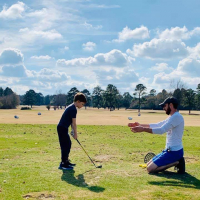
Cjetblack · Started 55 minutes ago

Redbird · Started 1 hour ago

Bigjim1022 · Started 1 hour ago

GolfWRX_Spotted · Started December 5, 2023
- Existing user? Sign In
The Bag Room
- Tour & Pre-Release Equipment
- WRX Club Techs
- Golf Sims/GPS/RFs/Apps
- Golf Style and Accessories
The Club House
- General Golf Talk
- Classic Golf And Golfers
- Courses, Memberships and Travel
- Groups, Tourneys, and Partners Matching
WRX Academy
- Instruction & Academy
- Rules of Golf and Etiquette
- Swing Videos and Comments
Classifieds & ProShops
- Deal/No Deal
Website Help
- Forum Support
- BST AD Help Forum
My Activity Streams
- BST/Deal Activity
- All Activity
- Unread - No BST/19th
- Subscriptions
Classifieds
- For Sale Forum
- Wanted to Buy
- Mall of Pro Shops
- Where Did My Ad Go?
- Trade In Tool
- Create New...

The Rolling Stones record smash hit "(I Can't Get No) Satisfaction" on this day in 1965
Posted: May 12, 2024 | Last updated: May 12, 2024

More for You
Trump could face a $100 million tax bill after the IRS says he tried to write off the same losses twice on his Chicago skyscraper
Drop A Flavor Bomb On Your Buttered Noodles With One Secret Sauce
Putin Ally Threatens NATO Countries With 'Special Ammunition'
Luka Doncic Mimics Lu Dort Flopping As He Wants OKC Star To Be Punished
Saying goodbye to "Young Sheldon"
The Rubber Band Trick That Removes a Stripped Screw
Get Rid Of Pesky Wasps Using Two Ingredients You Already Own
Here is the true value of having a fully paid-off home in America — especially when you're heading into retirement
Frank Sinatra's Favorite Cocktail Only Requires 2 Ingredients
Westminster Dog Show crowns champions and sparks joy
These Crispy Onion Rings Are Almost Too Good to Share
Michael Spicer: "Jerry Seinfeld is a dinosaur and he’s wrong – comedy has just evolved"
Man raises concerns over growing phenomenon happening with cars across the world: 'A heartbreaking collective failure'
The best lake towns in America to live in year-round, based on data
Donald Trump Threatened With New Investigation
Bob Raissman: Loyalty in short supply as CBS dumps Phil Simms and Boomer Esiason from ‘The NFL Today’
The Best Movies Streaming on Paramount Plus
Why You Should Be Putting Paper Towels in the Fridge
What Is Canadian Bacon?
Mike Budenholzer Vows To Compete For Championships After Signing 5-Year Deal Worth Over $50 Million As Suns Head Coach
Cognizant Founders Cup
Watch on espn+, nordqvist & h. green groups, lydia ko & marina alex groups, nelly korda & lydia ko groups, g. ruffels & m. stark groups, n, korda & b. henderson groups, a. lee & a. thitikul groups, latest golf videos, nelly korda sinks birdie on 8th.
- Terms of Use
- Privacy Policy
- Your US State Privacy Rights
- Children's Online Privacy Policy
- Interest-Based Ads
- About Nielsen Measurement
- Do Not Sell or Share My Personal Information
- Disney Ad Sales Site
- Work for ESPN
- Corrections
The Offspring Celebrate 30th Anniversary of Smash Album at Hard Rock Live in Hollywood
by DJ Siddiqi

HOLLYWOOD, Fla. (CBS12) — Legendary punk rock band The Offspring brought their witty lyrics and well-known hits back to South Florida at Hard Rock Live at Seminole Hard Rock Hotel & Casino on Thursday night.
The band is in the midst of celebrating the 30th anniversary of the release of their mainstream breakout album Smash . The album was released in April of 1994 and is well-known for helping revive the punk rock genre in the 90's.
Although the band has since released seven more albums in the past three decades-- including their most recent one, 2021's Let The Bad Times Roll -- their set list featured songs almost exclusively from Smash, 1997's Ixnay On The Hombre , 1998's Americana and 2000's Conspiracy Of One .
The California-based rock band performed "Come Out And Play" -- their first mainstream hit single -- to open up their set list in front of the packed auditorium at Hard Rock Live. They then followed with well-known singles such as "All I Want" and "Want You Bad."
Sprinkled in between The Offspring's set list of songs was a cover of Ramones' "Blitzkrieg Bop" and hilarious interactions between two of the band's remaining members from the original lineup back in 1984, singer Dexter Holland and guitarist Kevin "Noodles" Wasserman.
After playing their cover of Ramones' debut single from 1976, The Offspring performed "Original Prankster" before playing three straight songs from Smash , including "Nitro," "Bad Habit," and "Gotta Get Away" in front a packed crowd that was mostly on their feet all night.
However, it was their last few songs that made the crowd give their loudest ovation all night. Included in their final songs were "Pretty Fly (For A White Guy)" -- their biggest Billboard Hot 100 single, which peaked at No. 53 after being released in 1998 -- and their main event song to close the night, "Self Esteem."
The Offspring's appearance is also notable because it marks the first time since 2018 that the band has played a concert in South Florida. It's the first time since 2009 that they've performed in Broward County.
The Offspring will continue their tour in Daytona Beach with the well-known Rockville festival before heading over to Europe for the middle leg of their tour before eventually returning to the United States. They'll conclude the tour with a date on Sep. 28 in Ocean City, Maryland.
The Offspring's Set List
1. Come Out And Play
2. All I Want
3. Want You Bad
4. Staring At The Sun
5. In The Hall Of The Mountain King (Edvard Grieg Cover)
6. Blitzkrieg Bop (Ramones Cover)
7. Original Prankster
8. It'll Be A Long Time
9. Bad Habit
10. Gotta Get Away
11. Why Don't You Get A Job?
12. (Can't Get My) Head Around You
13. Pretty Fly (for a White Guy)
14. The Kids Aren't Alright
15. You're Gonna Go Far, Kid
16. Self Esteem
- Entertainment
- Celebrities
- Ticket Sales
- Promoted: What to Watch on Prime Video
Recommended
Zayn malik is ‘happier’ after one direction — but he still has one big regret with band.
- View Author Archive
- Get author RSS feed
Thanks for contacting us. We've received your submission.

Zayn Malik has a major regret from his time in One Direction.
The British singer-songwriter, 31, admitted on the “Zach Sang Show” last week that he wishes he had appreciated his experience in the former boy band more when he was a member .
“The main thing that I always feel bad about when I look back over my life is not enjoying the band enough,” Malik said. “I feel like I just took things too seriously, you know?”

“I’m grateful that I’m able to be happier now,” he continued. “I can actually enjoy things and own my own perspective a bit, you know? Like, glass half full versus it being half empty. That’s my choice.”
Malik quit One Direction in 2015. The rest of the band — Harry Styles, Niall Horan, Liam Payne, and Louis Tomlinson — went on an indefinite hiatus as a group the following year and all pursued solo careers.
During the interview, Malik explained that he “didn’t understand the importance of just trying to be happy” when he was in the boy band.
“I had this, like, teen angst thing going on — chip on my shoulder,” he shared. “I’m like, ‘It’s really cool to be moody as f**k all the time.’ It’s not. You’re just a loser. Let’s be honest, you know what I mean?”

“You should be a nice person,” Malik noted. “You should be somebody that people want to be around and enjoy being in your presence, and you should bring light to peoples’ day instead of being this f***ng negative cloud of energy.”
After reflecting on his One Direction days, the “Pillowtalk” singer said that he’s “happier” now thanks to his 3-year-old daughter Khai , whom he shares with his ex Gigi Hadid.
“I have so much love in me that I didn’t have before she was born,” Malik said. “She laughs all day. She wants to do the silliest things, and she gains so much excitement from it, you know? She just has a whole fresh perspective on life.”

One Direction formed under the leadership of Simon Cowell on the UK version of “The X-Factor” in 2010. All five members, including Malik, were teenagers when the group came together.
One Direction became one of the best-selling boy bands of all time before they disbanded.
Malik cited “stress” after leaving the group’s world tour in March 2015.
“My life with One Direction has been more than I could ever have imagined,” he said in a statement at the time. “But, after five years, I feel like it is now the right time for me to leave the band. I’d like to [apologize] to the fans if I’ve let anyone down, but I have to do what feels right in my heart.”

He also said that his reason for leaving the group was “because I want to be a normal 22-year-old who is able to relax and have some private time out of the spotlight.”
Malik released three solo albums after leaving One Direction. His fourth solo album, “Room Under the Stairs,” releases May 17.
Share this article:

Advertisement

COMMENTS
Club Speed, Attack Angle, Ball Speed, Smash Factor, Launch Angle, Spin Rate, Max Height, Land Angle and Carry. TrackMan Average Stats Taken From The PGA TOUR . TrackMan LPGA Tour Average Stats . ... The tour max and min range is a starting point versus having to create this from scratch. Reply. Jeff Bourg September 29, ...
So if you de-loft the club a lot (i.e deliver loft is low) you'll have smash factors in the 1.4 range for many of your irons. If you deliver the club perpendicular to the club, less so. I was closer to your stated 6 iron smash factor. So to answer your question, with a 6 iron a smash factor of 1.2 could mean 1.
Smash factor is the amount of energy transferred from the club to the ball. It is a simple math problem, ball speed divided by club speed. A great smash factor is around 1.50 for a driver, a wedge may be closer to 1.25. But these are numbers that professional golfers would expect. "Efficiency", or "Efficiency Rating" are other terms ...
A smash factor of 1.50 is considered highly efficient, and 109 players on tour this year currently have achieved that average, led by Camilo Villegas at 1.517. Scheffler, by comparison, is at 1.479.
Smash Factor relates to the amount of energy transferred from the club head to the golf ball. The higher the smash factor the better the energy transfer. A golfer would hope to achieve a smash factor near 1.50 on driver shots. That means for a 100 mph club speed the ball speed would be 150 mph. The higher the loft of the club, the lower the ...
In simple terms, smash factor is an "efficiency rating" on the quality of strike; it shows us how much ball speed we are achieving per 1 mph of club speed that we produce. For example, if your ball speed was 140 mph and your club speed was 100 mph, your smash factor would be 1.4, since 140/100 = 1.4. Generally, top professionals would be ...
A player swings the driver and records a clubhead speed of 100 mph. The resulting ball speed clocks in at 150 mph. Therefore, the smash factor is calculated as: Smash Factor = Ball Speed ÷ Clubhead Speed = 150 ÷ 100 = 1.50. This is considered an ideal smash factor for a driver.
Smash factor is a measure of how efficient you are at transferring energy from the club head into the ball. It is calculated by dividing the ball speed by the club head speed. If your ball speed is 145 miles per hour and your driver club head speed is 100 mile an hour, then the smash factor is 1.45. Smash factor will vary for different clubs ...
According to stats tracked by the PGA Tour in 2020, the average club head speed of PGA Tour Professionals is around 114 mph. Cameron Champ led the season in this category with an average club speed of 127 mph on qualifying par-4 and par-5 holes. The fastest drive of the season was achieved by Bryson DeChambeau, reaching 137.14 mph.
Put simply, Smash Factor is the ratio of ball speed to clubhead speed on a given shot - in other words, a measure of the efficiency of impact. Limitations placed by physics and the rules on club and ball design have given smash factor a nominal upper limit of 1.5 (15 players on the PGA Tour currently hit this, or slightly above) - in other ...
According to the PGA TOUR statistics, the smash factor values for each player in each tournament are listed. The smash factor scores are all excellent, so I assume everyone strikes the ball well. According to the study, the driver has a smash factor of 1.48 at a club speed of 94 mph, an attack angle of 3.0 degrees, and an optimal carry. ...
On the PGA Tour, players typically have a smash factor of 1.48-1.52 with their drivers, while LPGA Tour players have a slightly lower average at around 1.43-1.47. These professionals are able to achieve higher smash factors due to their superior technique and ability to hit the ball with the center of the clubface more consistently. However, it ...
A smash factor of 1.50 is considered highly efficient, and 73 players on tour this year currently have achieved that average, led by Camilo Villegas at 1.510. DeChambeau, by comparison, is at 1.437.
Smash factor is the key to achieving a long, controlled drive. In fact, the term "Smash Factor" is a calculation between your swing speed and the resulting ball speed. It shows you how well you are transferring energy from the clubhead to the golf ball. A smash factor of 1.5 is ideal for a driver.
What is a good smash factor for a 6-iron? A good smash factor for a 6-iron is in the 1.35-1.39 range, as this would place you in a similar range to PGA and LPGA tour players. On average, male tour players achieve a smash factor of 1.38 with their 6-iron, and female tour players 1.39.
A good smash factor range can vary depending on the specific club being used. For drivers, a great smash factor is around 1.50, but it might be more realistic for average golfers to aim for a range between 1.40 to 1.50. For irons, the range can vary significantly - a 6 iron, for example, might have a smash factor of about 1.2 to 1.4.
With a 6 iron, a smash factor of more than 1.30 would be a good result. According to the Trackman blog, the PGA Tour average for smash factor with mid irons like 6 iron is 1.38. The trajectory of the flight of the ball matters a lot. The higher loft you put on the ball, the less efficient (in terms of speed and distance) the transfer of energy ...
Smash factor is the ratio between the speed of the ball as it leaves the clubface and your swing speed. Generally, 1.5 is an ideal smash factor, but the average golfer's smash factor is only about ...
As the speed of the club head increases, so too should the speed of the ball as it heads off toward the target. Smash factor is important because it measures the efficiency of the energy transfer from the club to the ball. While it's possible to measure smash factor with any of your clubs, it's typically used with the driver.
Let's look at an example: Golfer A generates a ball speed of 140 MPH with a club head speed of 100 MPH. That would compute to a Smash Factor of 1.40 (140 ÷ 100). Golfer B, by comparison, generates 145 MPH of ball speed with that exact same 100 MPH club head speed and, in so doing, would have a Smash Factor of 1.45.
Smash Factor - 10 Fundamentals - TrackMan University. Watch on. Learn how to increase distance with the driver by improving solidity of contact. TrackMan's 10 Fundamentals were originally released as part of a 2010 newsletter. This video looks at the second fundamental, smash factor. Visit TrackManUniversity.com and try our new platform:
This should theoretically give a smash factor of 1.48. However, due to the uncertainty of the exact location of the club head speed reading of the TrackMan™, the smash factor might be measured somewhere between 148/101 and 148/99 (1.465 to 1.495).
The PGA Tour statistics give an average smash factor value of 1.48, with a 94mph club speed (for a driver). The attack angle is at 3 degrees. This pertains to all tour players. All the players show excellent performances. Moreover, the 6-iron shows a smash factor of 1.41 when hit with a 78mph club speed. The smash factor for most wedges is 1.28.
PGA TOUR, PGA TOUR Champions, and the Swinging Golfer design are registered trademarks. The Korn Ferry trademark is also a registered trademark, and is used in the Korn Ferry Tour logo with ...
Mick Jagger, Ron Wood, Charlie Watts and Keith Richard perform as The Rolling Stones officially kicked off their 50th anniversary tour in Staples Center in Los Angeles, CA on May 3, 2013. More for You
Visit ESPN to view the Cognizant Founders Cup Golf leaderboard from the LPGA tour
The band is in the midst of celebrating the 30th anniversary of the release of their mainstream breakout album Smash. The album was released in April of 1994 and is well-known for helping revive ...
Zayn Malik at Paris Fashion Week in January 2024. WireImage. One Direction formed under the leadership of Simon Cowell on the UK version of "The X-Factor" in 2010.